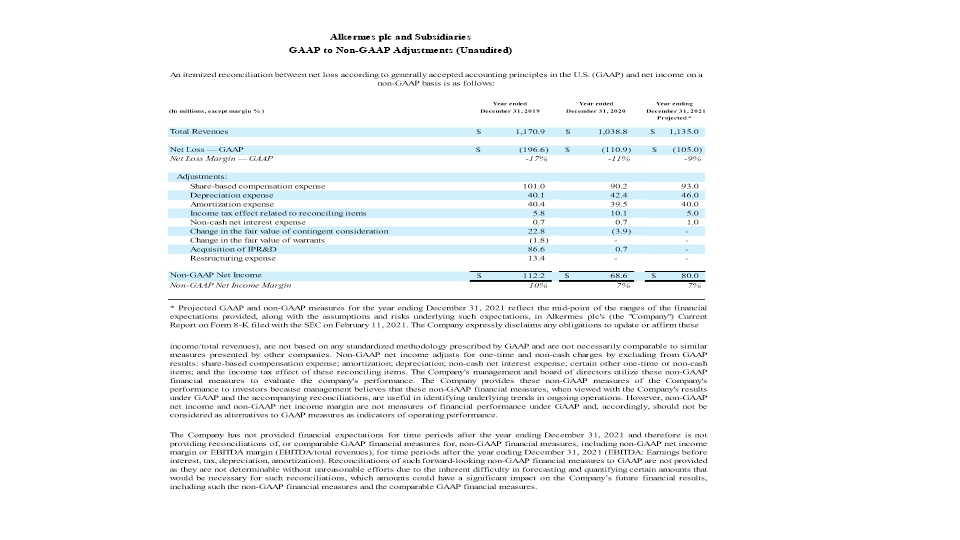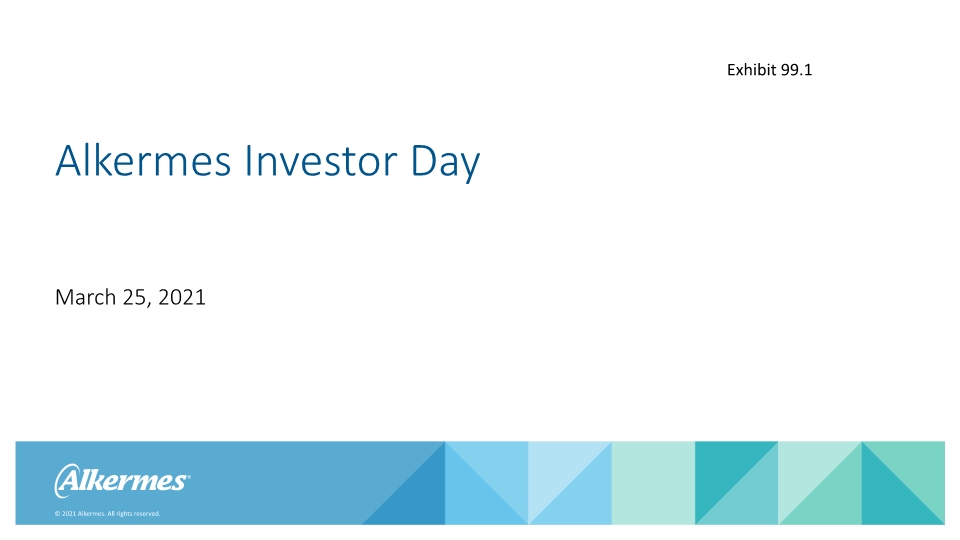
March 25, 2021 Alkermes Investor Day Exhibit 99.1
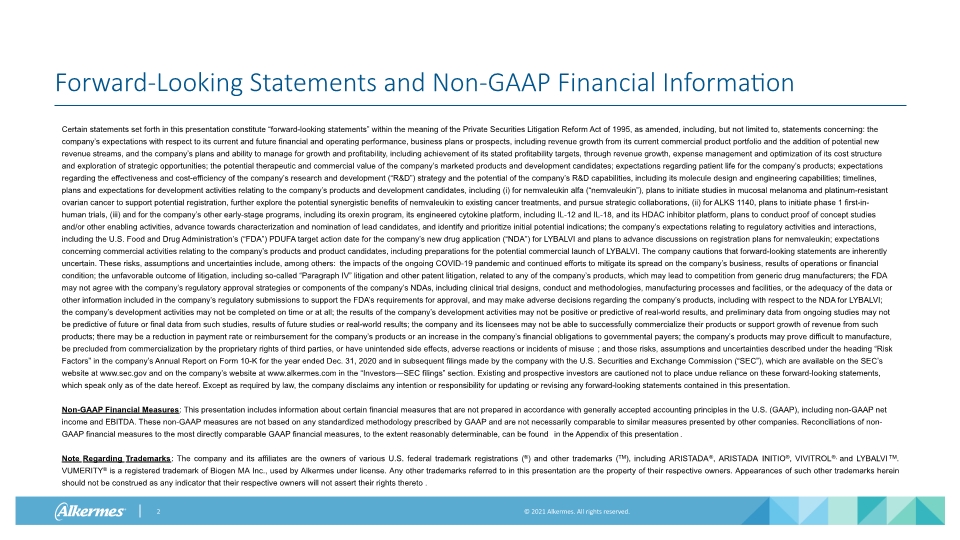
Forward-Looking Statements and Non-GAAP Financial Information Certain statements set forth in this presentation constitute “forward-looking statements” within the meaning of the Private Securities Litigation Reform Act of 1995, as amended, including, but not limited to, statements concerning: the company’s expectations with respect to its current and future financial and operating performance, business plans or prospects, including revenue growth from its current commercial product portfolio and the addition of potential new revenue streams, and the company’s plans and ability to manage for growth and profitability, including achievement of its stated profitability targets, through revenue growth, expense management and optimization of its cost structure and exploration of strategic opportunities; the potential therapeutic and commercial value of the company’s marketed products and development candidates; expectations regarding patient life for the company’s products; expectations regarding the effectiveness and cost-efficiency of the company’s research and development (“R&D”) strategy and the potential of the company’s R&D capabilities, including its molecule design and engineering capabilities; timelines, plans and expectations for development activities relating to the company’s products and development candidates, including (i) for nemvaleukin alfa (“nemvaleukin”), plans to initiate studies in mucosal melanoma and platinum-resistant ovarian cancer to support potential registration, further explore the potential synergistic benefits of nemvaleukin to existing cancer treatments, and pursue strategic collaborations, (ii) for ALKS 1140, plans to initiate phase 1 first-in-human trials, (iii) and for the company’s other early-stage programs, including its orexin program, its engineered cytokine platform, including IL-12 and IL-18, and its HDAC inhibitor platform, plans to conduct proof of concept studies and/or other enabling activities, advance towards characterization and nomination of lead candidates, and identify and prioritize initial potential indications; the company’s expectations relating to regulatory activities and interactions, including the U.S. Food and Drug Administration’s (“FDA”) PDUFA target action date for the company’s new drug application (“NDA”) for LYBALVI and plans to advance discussions on registration plans for nemvaleukin; expectations concerning commercial activities relating to the company’s products and product candidates, including preparations for the potential commercial launch of LYBALVI. The company cautions that forward-looking statements are inherently uncertain. These risks, assumptions and uncertainties include, among others: the impacts of the ongoing COVID-19 pandemic and continued efforts to mitigate its spread on the company’s business, results of operations or financial condition; the unfavorable outcome of litigation, including so-called “Paragraph IV” litigation and other patent litigation, related to any of the company’s products, which may lead to competition from generic drug manufacturers; the FDA may not agree with the company’s regulatory approval strategies or components of the company’s NDAs, including clinical trial designs, conduct and methodologies, manufacturing processes and facilities, or the adequacy of the data or other information included in the company’s regulatory submissions to support the FDA’s requirements for approval, and may make adverse decisions regarding the company’s products, including with respect to the NDA for LYBALVI; the company’s development activities may not be completed on time or at all; the results of the company’s development activities may not be positive or predictive of real-world results, and preliminary data from ongoing studies may not be predictive of future or final data from such studies, results of future studies or real-world results; the company and its licensees may not be able to successfully commercialize their products or support growth of revenue from such products; there may be a reduction in payment rate or reimbursement for the company’s products or an increase in the company’s financial obligations to governmental payers; the company’s products may prove difficult to manufacture, be precluded from commercialization by the proprietary rights of third parties, or have unintended side effects, adverse reactions or incidents of misuse; and those risks, assumptions and uncertainties described under the heading “Risk Factors” in the company’s Annual Report on Form 10-K for the year ended Dec. 31, 2020 and in subsequent filings made by the company with the U.S. Securities and Exchange Commission (“SEC”), which are available on the SEC’s website at www.sec.gov and on the company’s website at www.alkermes.com in the “Investors—SEC filings” section. Existing and prospective investors are cautioned not to place undue reliance on these forward-looking statements, which speak only as of the date hereof. Except as required by law, the company disclaims any intention or responsibility for updating or revising any forward-looking statements contained in this presentation. Non-GAAP Financial Measures: This presentation includes information about certain financial measures that are not prepared in accordance with generally accepted accounting principles in the U.S. (GAAP), including non-GAAP net income and EBITDA. These non-GAAP measures are not based on any standardized methodology prescribed by GAAP and are not necessarily comparable to similar measures presented by other companies. Reconciliations of non-GAAP financial measures to the most directly comparable GAAP financial measures, to the extent reasonably determinable, can be found in the Appendix of this presentation. Note Regarding Trademarks: The company and its affiliates are the owners of various U.S. federal trademark registrations (®) and other trademarks (TM), including ARISTADA®, ARISTADA INITIO®, VIVITROL®, and LYBALVITM. VUMERITY® is a registered trademark of Biogen MA Inc., used by Alkermes under license. Any other trademarks referred to in this presentation are the property of their respective owners. Appearances of such other trademarks herein should not be construed as any indicator that their respective owners will not assert their rights thereto.

Richard Pops Chief Executive Officer Scientific and Business Excellence: Focused on New Approaches to Creating Value
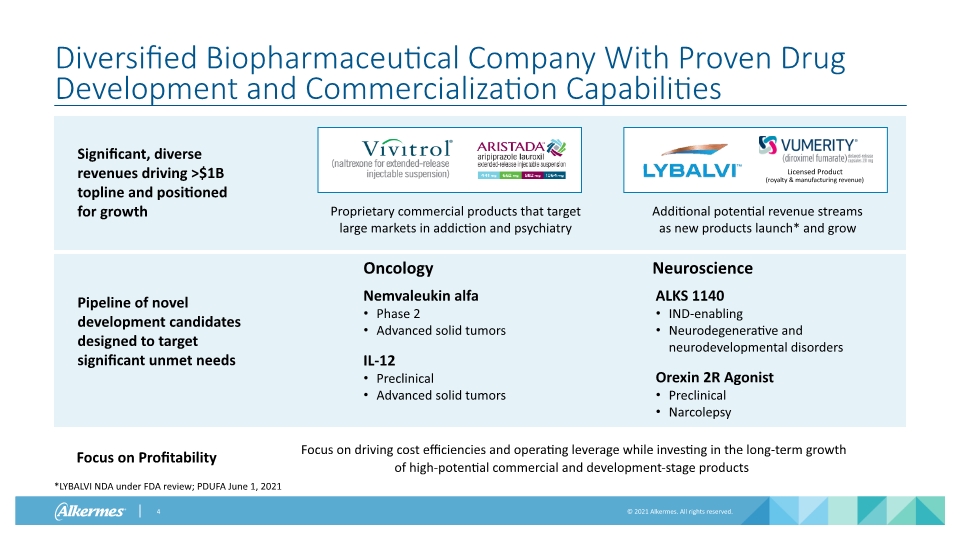
Diversified Biopharmaceutical Company With Proven Drug Development and Commercialization Capabilities Significant, diverse revenues driving >$1B topline and positioned for growth Proprietary commercial products that target large markets in addiction and psychiatry Additional potential revenue streams as new products launch* and grow Licensed Product (royalty & manufacturing revenue) Pipeline of novel development candidates designed to target significant unmet needs ALKS 1140 IND-enabling Neurodegenerative and neurodevelopmental disorders Orexin 2R Agonist Preclinical Narcolepsy Nemvaleukin alfa Phase 2 Advanced solid tumors IL-12 Preclinical Advanced solid tumors Focus on Profitability Oncology Neuroscience Focus on driving cost efficiencies and operating leverage while investing in the long-term growth of high-potential commercial and development-stage products ™ *LYBALVI NDA under FDA review; PDUFA June 1, 2021
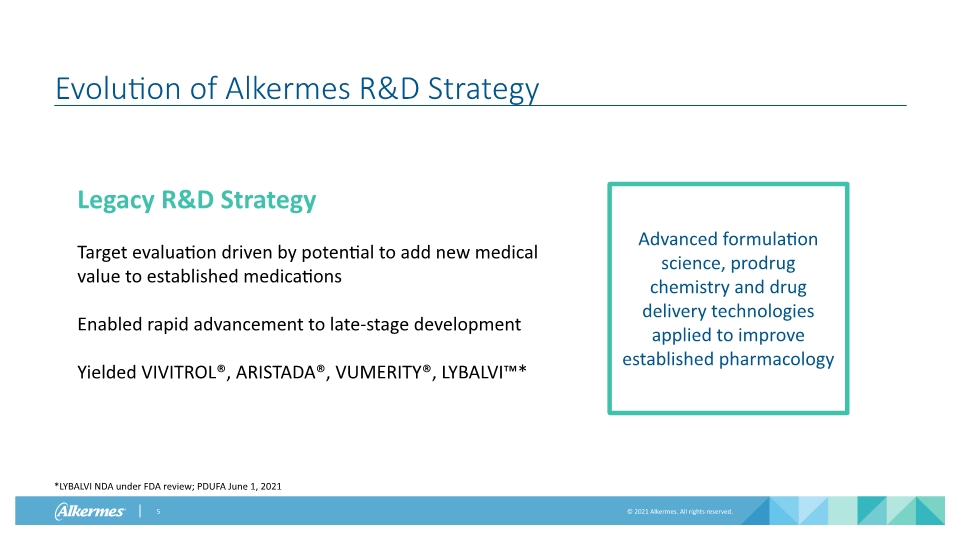
Legacy R&D Strategy Target evaluation driven by potential to add new medical value to established medications Enabled rapid advancement to late-stage development Yielded VIVITROL®, ARISTADA®, VUMERITY®, LYBALVI™* Evolution of Alkermes R&D Strategy Advanced formulation science, prodrug chemistry and drug delivery technologies applied to improve established pharmacology *LYBALVI NDA under FDA review; PDUFA June 1, 2021
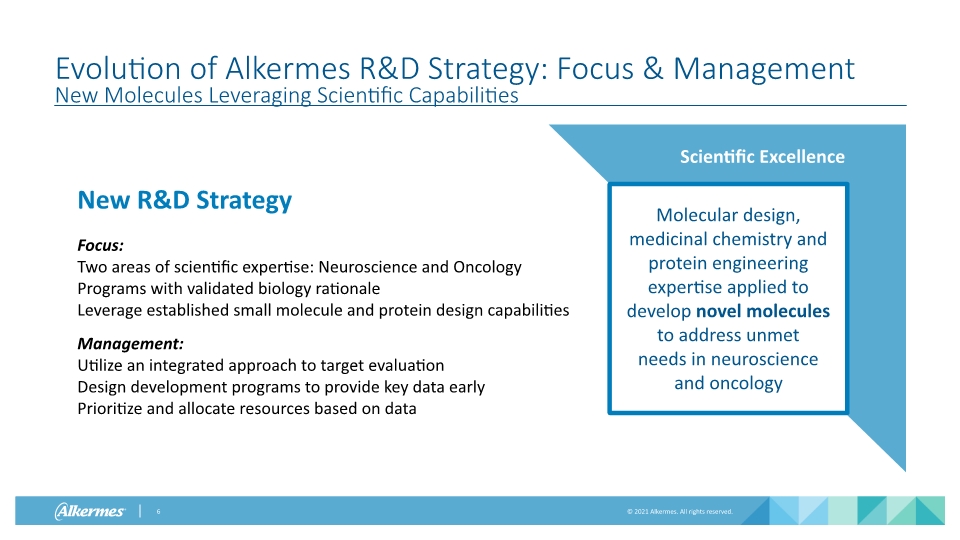
Molecular design, medicinal chemistry and protein engineering expertise applied to develop novel molecules to address unmet needs in neuroscience and oncology Scientific Excellence New R&D Strategy Focus: Two areas of scientific expertise: Neuroscience and Oncology Programs with validated biology rationale Leverage established small molecule and protein design capabilities Management: Utilize an integrated approach to target evaluation Design development programs to provide key data early Prioritize and allocate resources based on data Evolution of Alkermes R&D Strategy: Focus & Management New Molecules Leveraging Scientific Capabilities
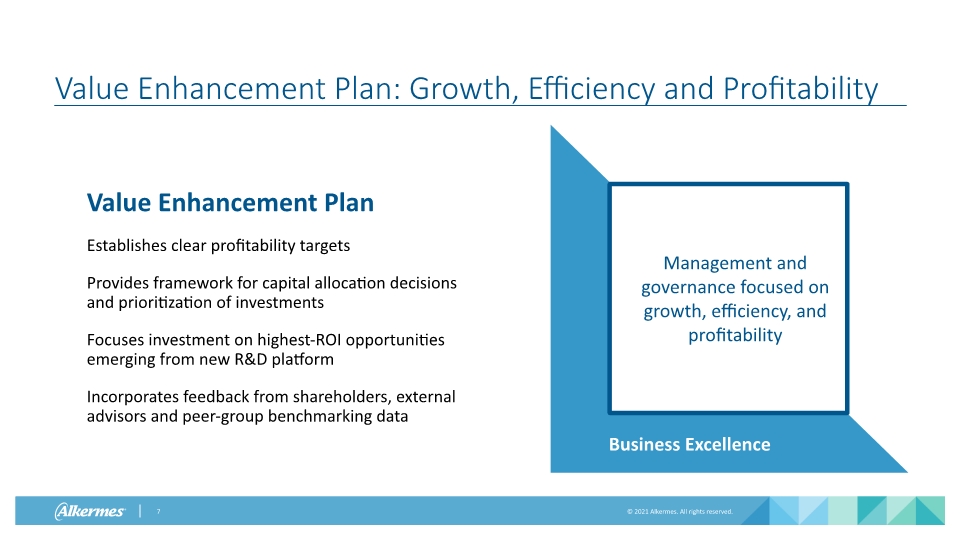
Business Excellence Value Enhancement Plan: Growth, Efficiency and Profitability Value Enhancement Plan Establishes clear profitability targets Provides framework for capital allocation decisions and prioritization of investments Focuses investment on highest-ROI opportunities emerging from new R&D platform Incorporates feedback from shareholders, external advisors and peer-group benchmarking data Management and governance focused on growth, efficiency, and profitability
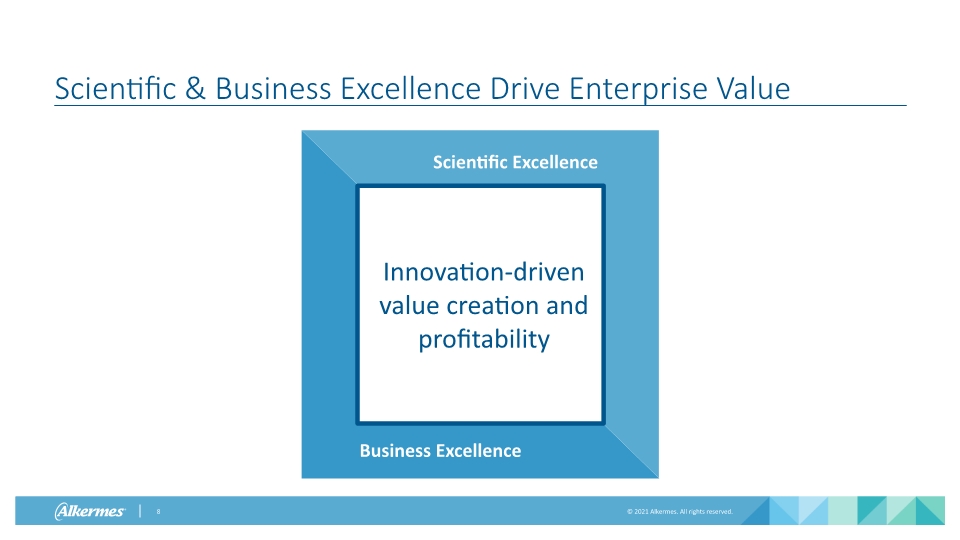
Innovation-driven value creation and profitability Scientific Excellence Business Excellence Scientific & Business Excellence Drive Enterprise Value
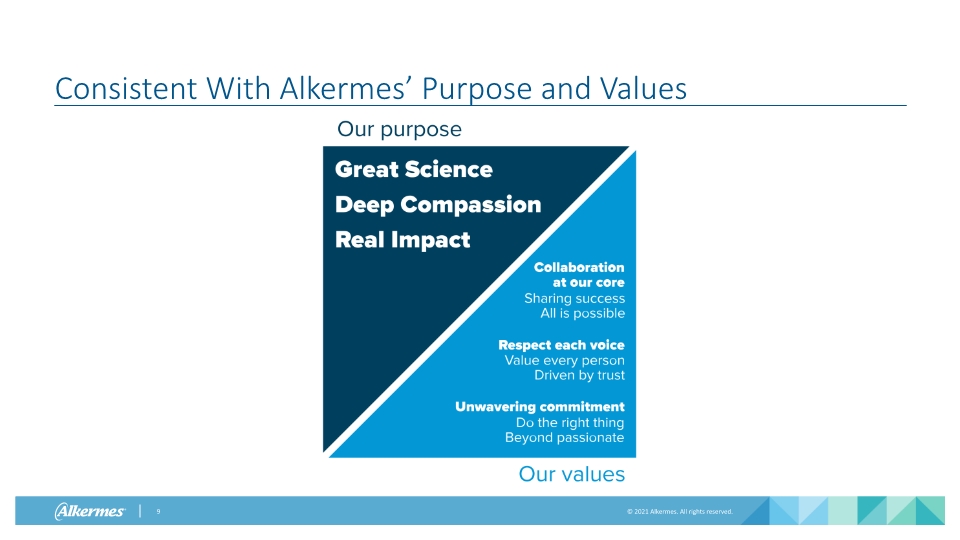
Consistent With Alkermes’ Purpose and Values
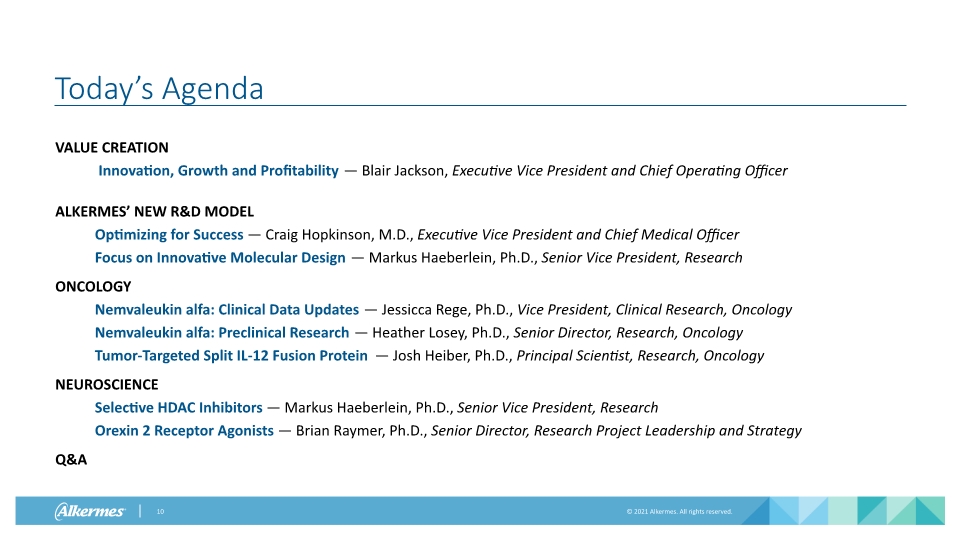
Today’s Agenda VALUE CREATION Innovation, Growth and Profitability — Blair Jackson, Executive Vice President and Chief Operating Officer ALKERMES’ NEW R&D MODEL Optimizing for Success — Craig Hopkinson, M.D., Executive Vice President and Chief Medical Officer Focus on Innovative Molecular Design — Markus Haeberlein, Ph.D., Senior Vice President, Research ONCOLOGY Nemvaleukin alfa: Clinical Data Updates — Jessicca Rege, Ph.D., Vice President, Clinical Research, Oncology Nemvaleukin alfa: Preclinical Research — Heather Losey, Ph.D., Senior Director, Research, Oncology Tumor-Targeted Split IL-12 Fusion Protein — Josh Heiber, Ph.D., Principal Scientist, Research, Oncology NEUROSCIENCE Selective HDAC Inhibitors — Markus Haeberlein, Ph.D., Senior Vice President, Research Orexin 2 Receptor Agonists — Brian Raymer, Ph.D., Senior Director, Research Project Leadership and Strategy Q&A
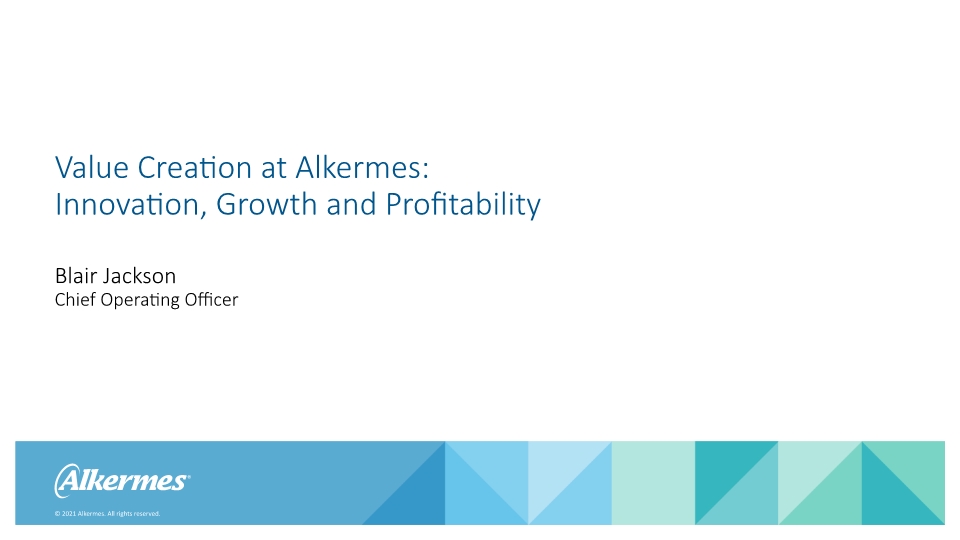
Blair Jackson Chief Operating Officer Value Creation at Alkermes: Innovation, Growth and Profitability
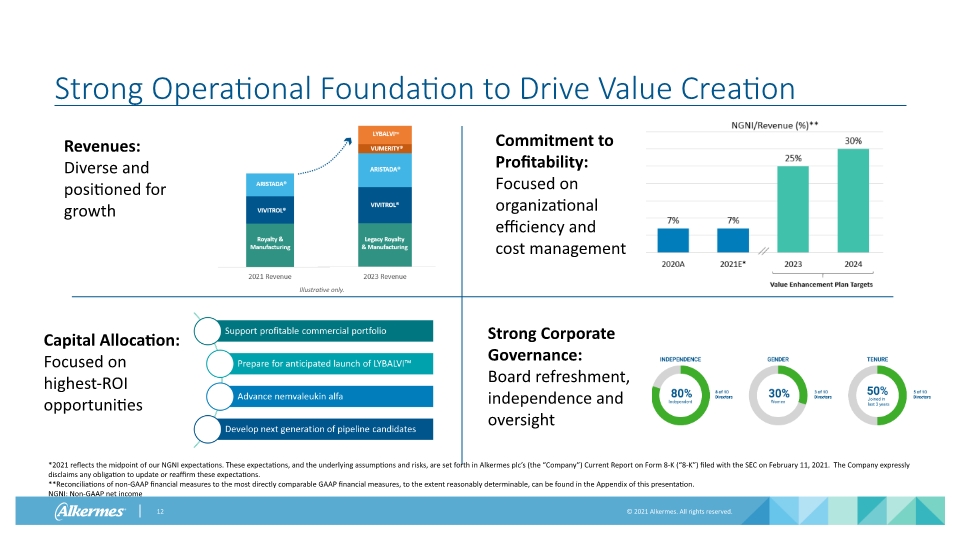
Strong Operational Foundation to Drive Value Creation Revenues: Diverse and positioned for growth Commitment to Profitability: Focused on organizational efficiency and cost management Capital Allocation: Focused on highest-ROI opportunities Strong Corporate Governance: Board refreshment, independence and oversight *2021 reflects the midpoint of our NGNI expectations. These expectations, and the underlying assumptions and risks, are set forth in Alkermes plc’s (the “Company”) Current Report on Form 8-K (“8-K”) filed with the SEC on February 11, 2021. The Company expressly disclaims any obligation to update or reaffirm these expectations. **Reconciliations of non-GAAP financial measures to the most directly comparable GAAP financial measures, to the extent reasonably determinable, can be found in the Appendix of this presentation. NGNI: Non-GAAP net income Illustrative only.
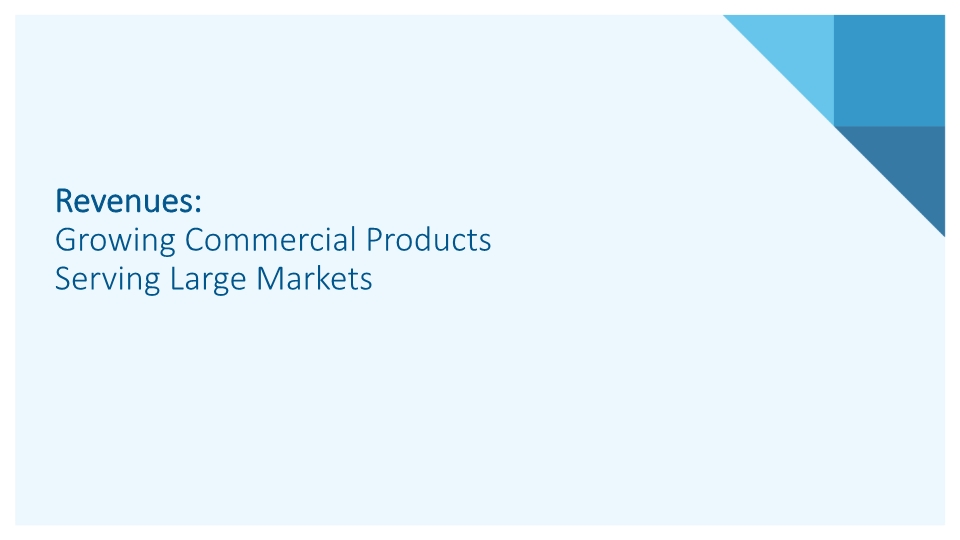
Revenues: Growing Commercial Products Serving Large Markets
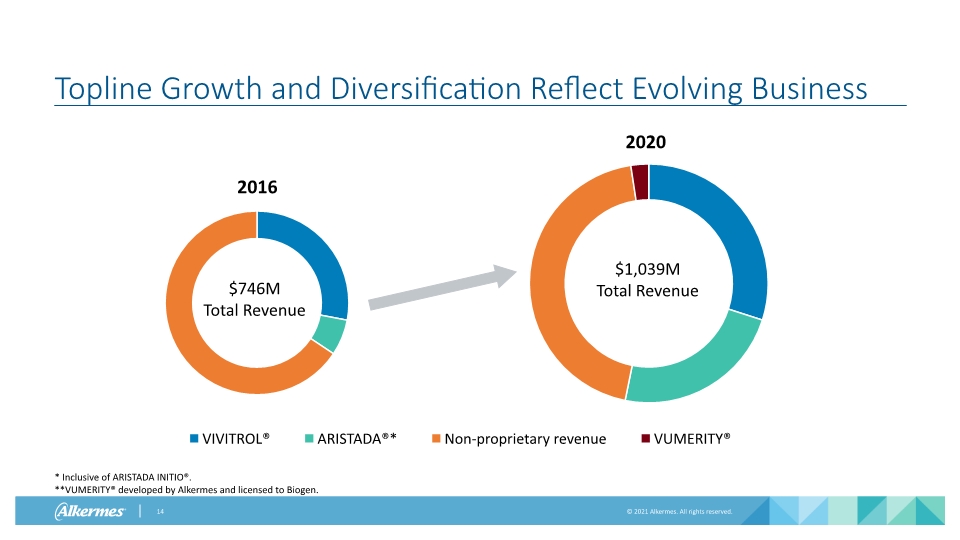
Topline Growth and Diversification Reflect Evolving Business * Inclusive of ARISTADA INITIO®. **VUMERITY® developed by Alkermes and licensed to Biogen.
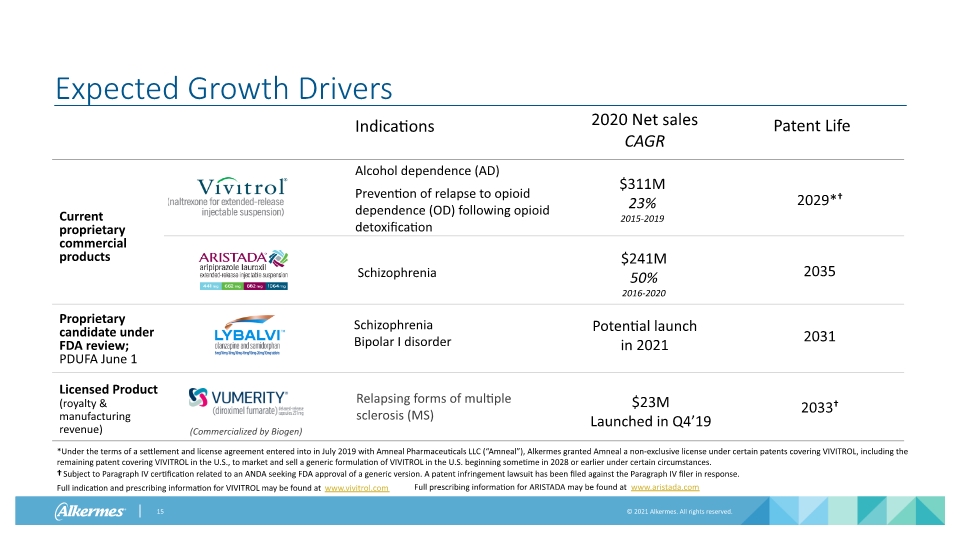
Current proprietary commercial products Proprietary candidate under FDA review; PDUFA June 1 Licensed Product (royalty & manufacturing revenue) Expected Growth Drivers Patent Life 2020 Net sales CAGR Indications Alcohol dependence (AD) Prevention of relapse to opioid dependence (OD) following opioid detoxification Schizophrenia Schizophrenia Bipolar I disorder Relapsing forms of multiple sclerosis (MS) $311M 23% 2015-2019 $241M 50% 2016-2020 Potential launch in 2021 $23M Launched in Q4’19 2029*† 2035 2031 2033† *Under the terms of a settlement and license agreement entered into in July 2019 with Amneal Pharmaceuticals LLC (“Amneal”), Alkermes granted Amneal a non-exclusive license under certain patents covering VIVITROL, including the remaining patent covering VIVITROL in the U.S., to market and sell a generic formulation of VIVITROL in the U.S. beginning sometime in 2028 or earlier under certain circumstances. † Subject to Paragraph IV certification related to an ANDA seeking FDA approval of a generic version. A patent infringement lawsuit has been filed against the Paragraph IV filer in response. Full indication and prescribing information for VIVITROL may be found at www.vivitrol.com Full prescribing information for ARISTADA may be found at www.aristada.com (Commercialized by Biogen)
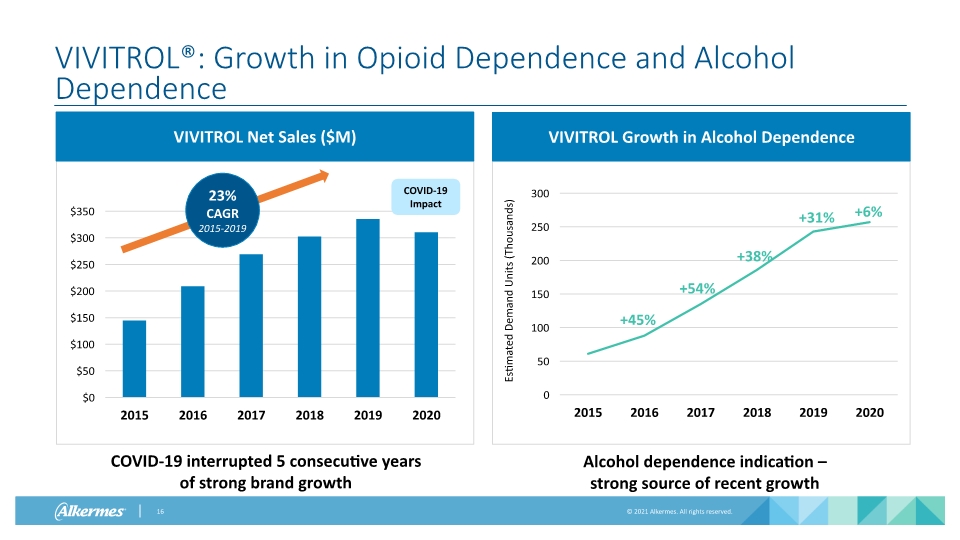
VIVITROL®: Growth in Opioid Dependence and Alcohol Dependence 23% CAGR 2015-2019 COVID-19 Impact +54% +38% +31% +6% +45% VIVITROL Net Sales ($M) VIVITROL Growth in Alcohol Dependence COVID-19 interrupted 5 consecutive years of strong brand growth Alcohol dependence indication – strong source of recent growth
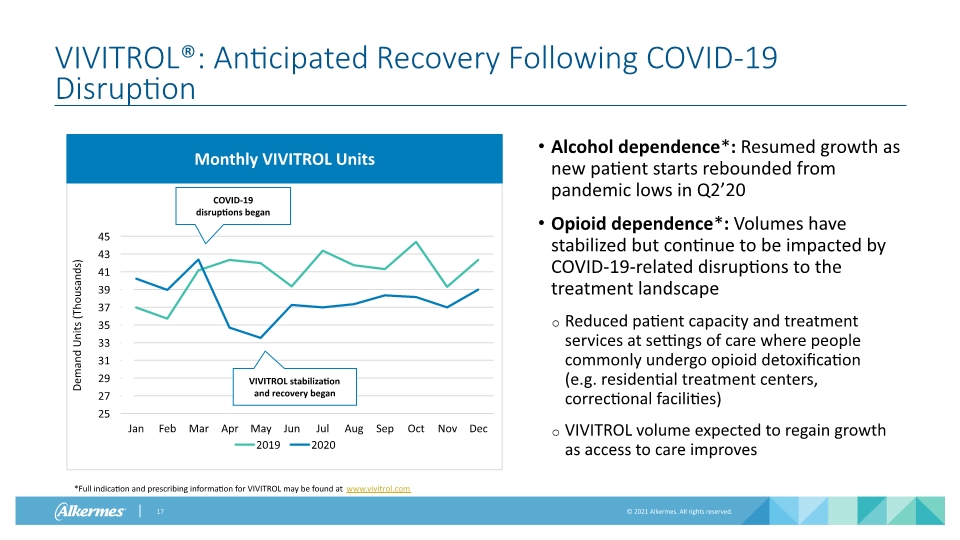
VIVITROL®: Anticipated Recovery Following COVID-19 Disruption Alcohol dependence*: Resumed growth as new patient starts rebounded from pandemic lows in Q2’20 Opioid dependence*: Volumes have stabilized but continue to be impacted by COVID-19-related disruptions to the treatment landscape Reduced patient capacity and treatment services at settings of care where people commonly undergo opioid detoxification (e.g. residential treatment centers, correctional facilities) VIVITROL volume expected to regain growth as access to care improves Monthly VIVITROL Units VIVITROL stabilization and recovery began COVID-19 disruptions began *Full indication and prescribing information for VIVITROL may be found at www.vivitrol.com
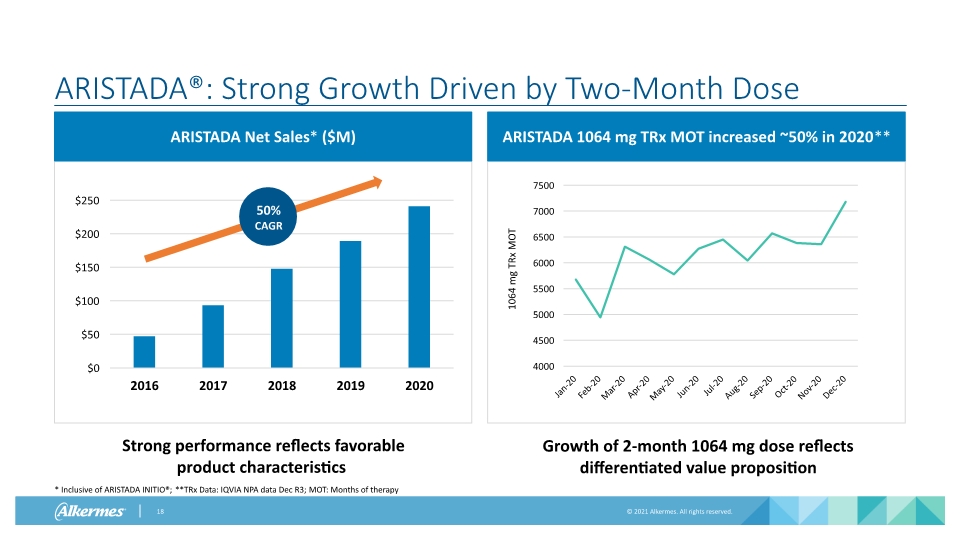
50% CAGR ARISTADA®: Strong Growth Driven by Two-Month Dose * Inclusive of ARISTADA INITIO®; **TRx Data: IQVIA NPA data Dec R3; MOT: Months of therapy ARISTADA Net Sales* ($M) ARISTADA 1064 mg TRx MOT increased ~50% in 2020** Strong performance reflects favorable product characteristics Growth of 2-month 1064 mg dose reflects differentiated value proposition
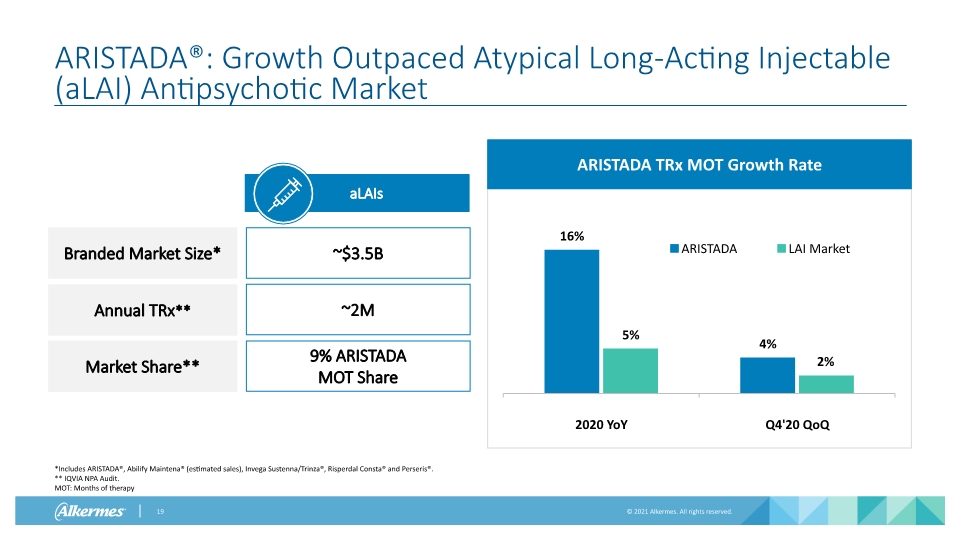
aLAIs Branded Market Size* Annual TRx** Market Share** ~$3.5B ~2M 9% ARISTADA MOT Share ARISTADA TRx MOT Growth Rate ARISTADA®: Growth Outpaced Atypical Long-Acting Injectable (aLAI) Antipsychotic Market *Includes ARISTADA®, Abilify Maintena® (estimated sales), Invega Sustenna/Trinza®, Risperdal Consta® and Perseris®. ** IQVIA NPA Audit. MOT: Months of therapy
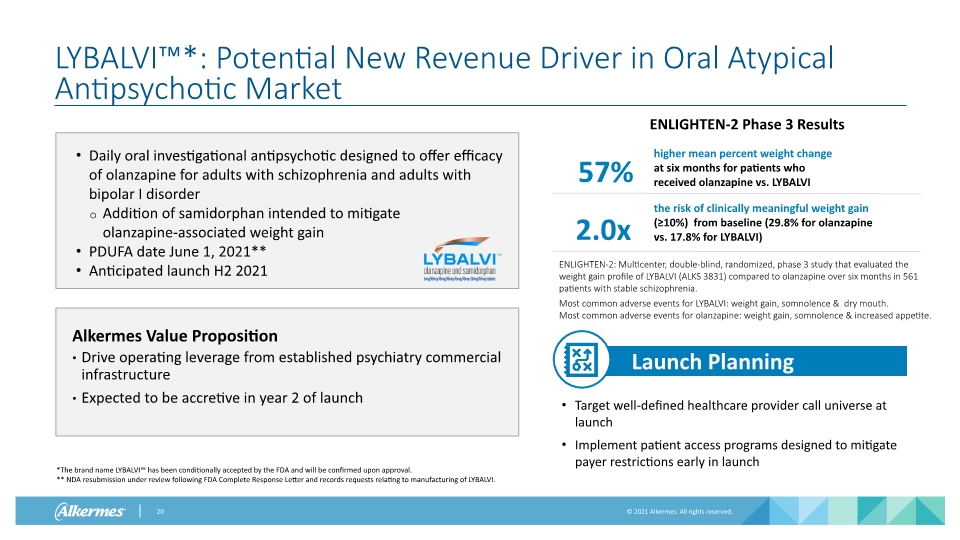
Alkermes Value Proposition Drive operating leverage from established psychiatry commercial infrastructure Expected to be accretive in year 2 of launch *The brand name LYBALVI™ has been conditionally accepted by the FDA and will be confirmed upon approval. ** NDA resubmission under review following FDA Complete Response Letter and records requests relating to manufacturing of LYBALVI. Launch Planning Target well-defined healthcare provider call universe at launch Implement patient access programs designed to mitigate payer restrictions early in launch LYBALVI™*: Potential New Revenue Driver in Oral Atypical Antipsychotic Market Daily oral investigational antipsychotic designed to offer efficacy of olanzapine for adults with schizophrenia and adults with bipolar I disorder Addition of samidorphan intended to mitigate olanzapine-associated weight gain PDUFA date June 1, 2021** Anticipated launch H2 2021 ENLIGHTEN-2: Multicenter, double-blind, randomized, phase 3 study that evaluated the weight gain profile of LYBALVI (ALKS 3831) compared to olanzapine over six months in 561 patients with stable schizophrenia. Most common adverse events for LYBALVI: weight gain, somnolence & dry mouth. Most common adverse events for olanzapine: weight gain, somnolence & increased appetite. higher mean percent weight change at six months for patients who received olanzapine vs. LYBALVI 57% ENLIGHTEN-2 Phase 3 Results *LYBALVI NDA under FDA review; PDUFA June 1, 2021 the risk of clinically meaningful weight gain (≥10%) from baseline (29.8% for olanzapine vs. 17.8% for LYBALVI) 2.0x
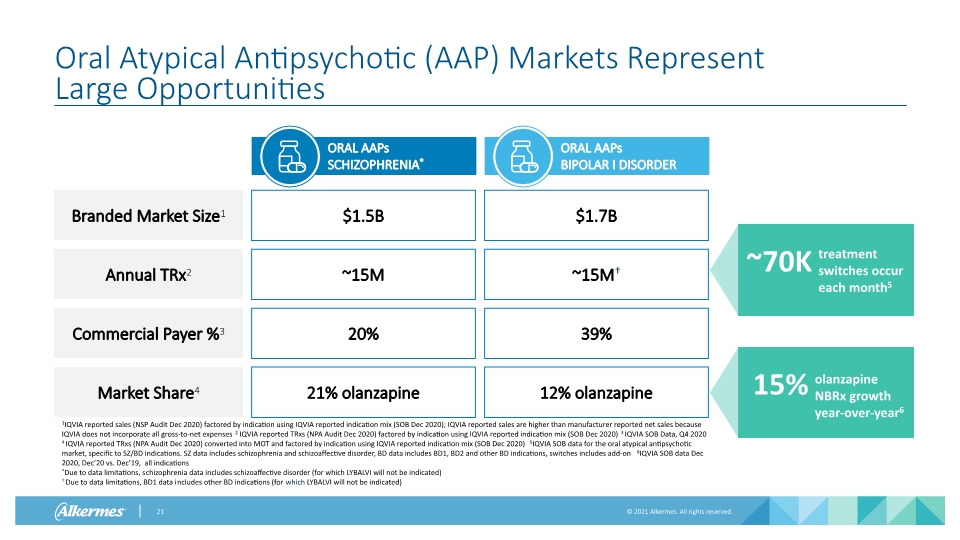
ORAL AAPs BIPOLAR I DISORDER Branded Market Size1 Annual TRx2 Market Share4 $1.5B ~15M 21% olanzapine $1.7B ~15M† 12% olanzapine ORAL AAPs SCHIZOPHRENIA* Commercial Payer %3 20% 39% ~70K treatment switches occur each month5 olanzapine NBRx growth year-over-year6 15% Oral Atypical Antipsychotic (AAP) Markets Represent Large Opportunities 1IQVIA reported sales (NSP Audit Dec 2020) factored by indication using IQVIA reported indication mix (SOB Dec 2020); IQVIA reported sales are higher than manufacturer reported net sales because IQVIA does not incorporate all gross-to-net expenses 2 IQVIA reported TRxs (NPA Audit Dec 2020) factored by indication using IQVIA reported indication mix (SOB Dec 2020) 3 IQVIA SOB Data, Q4 2020 4 IQVIA reported TRxs (NPA Audit Dec 2020) converted into MOT and factored by indication using IQVIA reported indication mix (SOB Dec 2020) 5IQVIA SOB data for the oral atypical antipsychotic market, specific to SZ/BD indications. SZ data includes schizophrenia and schizoaffective disorder, BD data includes BD1, BD2 and other BD indications, switches includes add-on 6IQVIA SOB data Dec 2020, Dec’20 vs. Dec’19, all indications *Due to data limitations, schizophrenia data includes schizoaffective disorder (for which LYBALVI will not be indicated) † Due to data limitations, BD1 data includes other BD indications (for which LYBALVI will not be indicated)
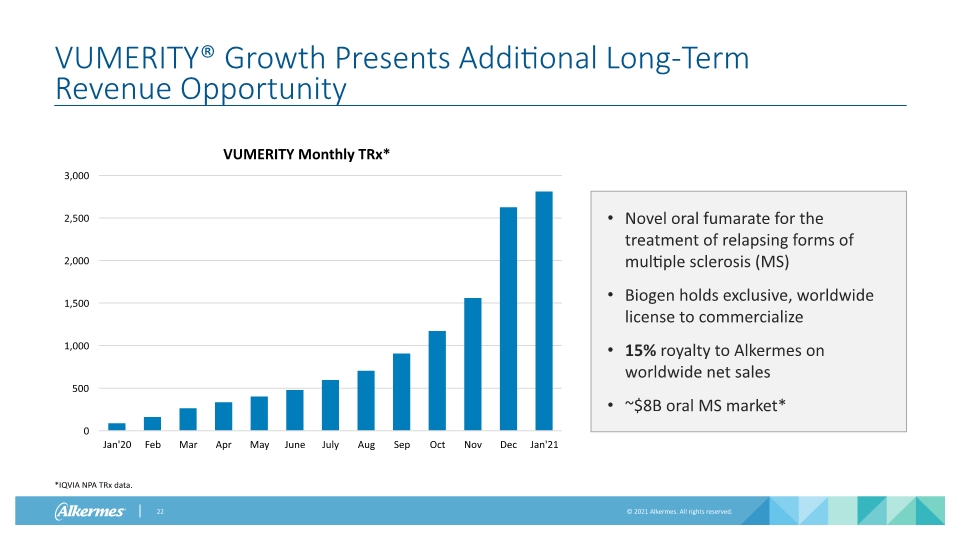
Novel oral fumarate for the treatment of relapsing forms of multiple sclerosis (MS) Biogen holds exclusive, worldwide license to commercialize 15% royalty to Alkermes on worldwide net sales ~$8B oral MS market* *IQVIA NPA TRx data. VUMERITY® Growth Presents Additional Long-Term Revenue Opportunity
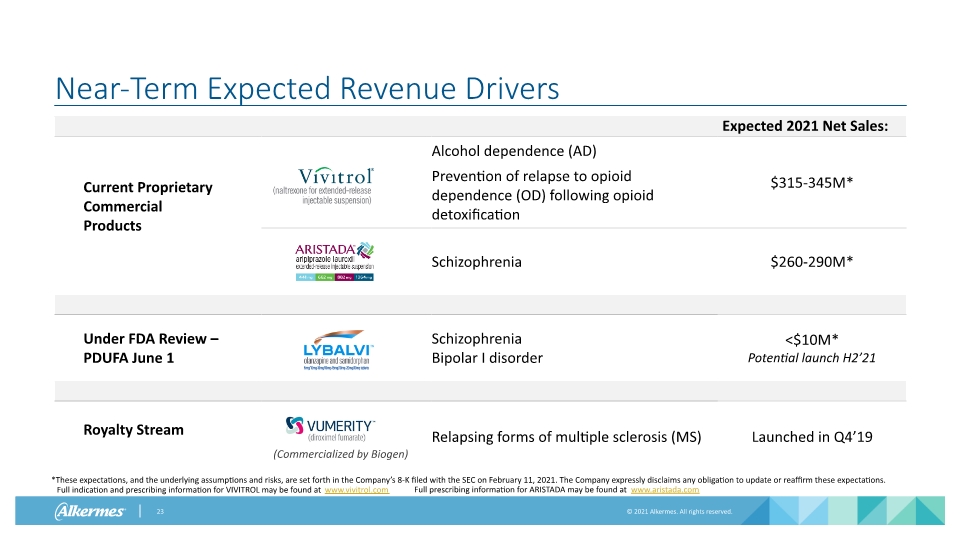
*These expectations, and the underlying assumptions and risks, are set forth in the Company’s 8-K filed with the SEC on February 11, 2021. The Company expressly disclaims any obligation to update or reaffirm these expectations. Near-Term Expected Revenue Drivers Expected 2021 Net Sales: Full indication and prescribing information for VIVITROL may be found at www.vivitrol.com Full prescribing information for ARISTADA may be found at www.aristada.com
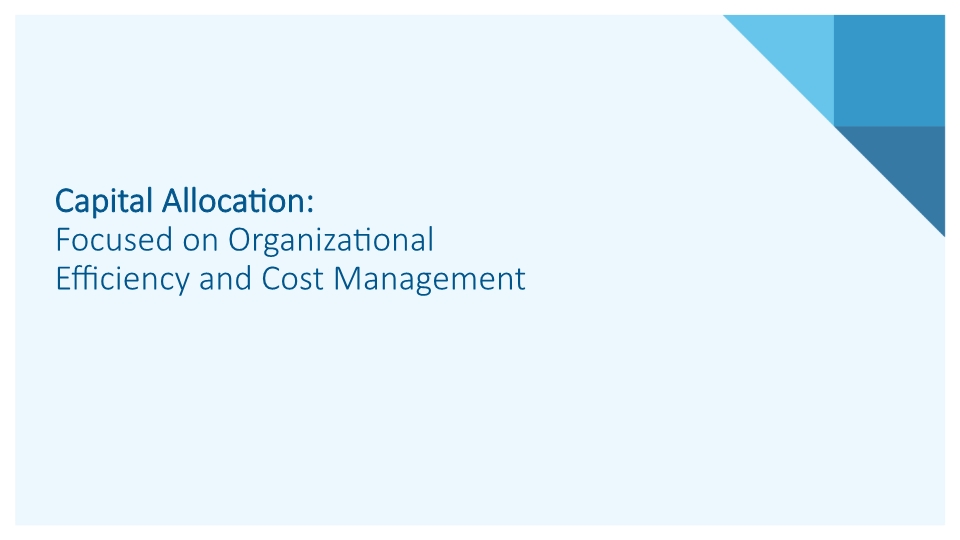
Capital Allocation: Focused on Organizational Efficiency and Cost Management
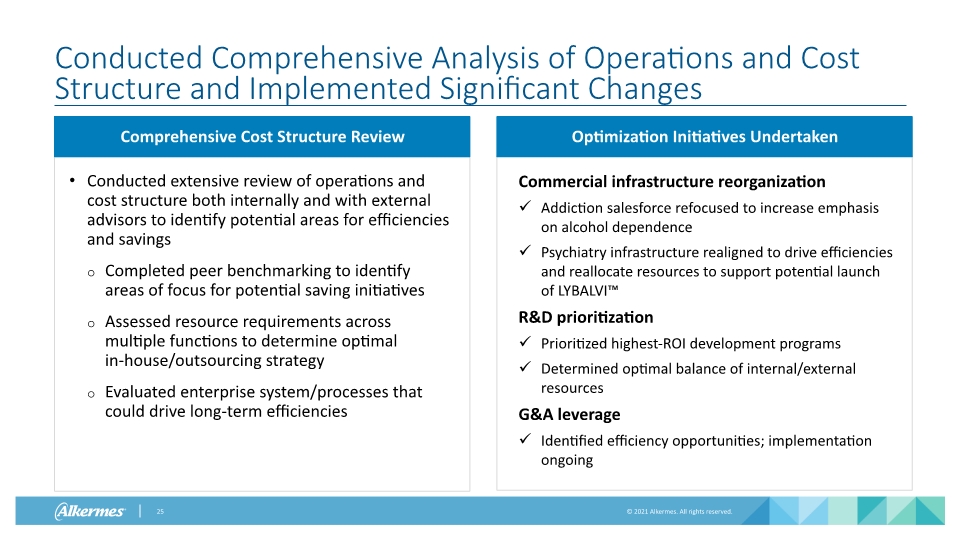
Conducted Comprehensive Analysis of Operations and Cost Structure and Implemented Significant Changes Conducted extensive review of operations and cost structure both internally and with external advisors to identify potential areas for efficiencies and savings Completed peer benchmarking to identify areas of focus for potential saving initiatives Assessed resource requirements across multiple functions to determine optimal in-house/outsourcing strategy Evaluated enterprise system/processes that could drive long-term efficiencies Commercial infrastructure reorganization Addiction salesforce refocused to increase emphasis on alcohol dependence Psychiatry infrastructure realigned to drive efficiencies and reallocate resources to support potential launch of LYBALVI™ R&D prioritization Prioritized highest-ROI development programs Determined optimal balance of internal/external resources G&A leverage Identified efficiency opportunities; implementation ongoing Comprehensive Cost Structure Review Optimization Initiatives Undertaken
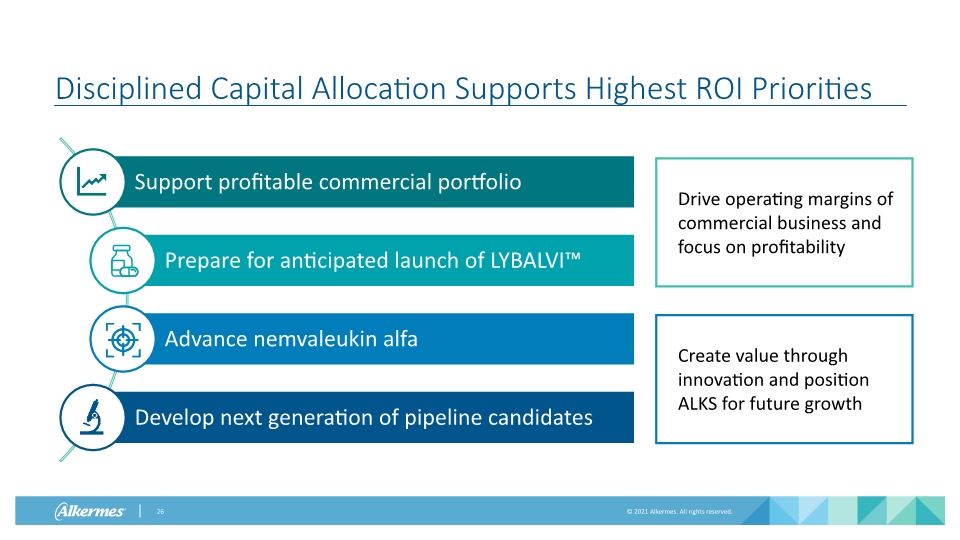
Disciplined Capital Allocation Supports Highest ROI Priorities Drive operating margins of commercial business and focus on profitability Create value through innovation and position ALKS for future growth
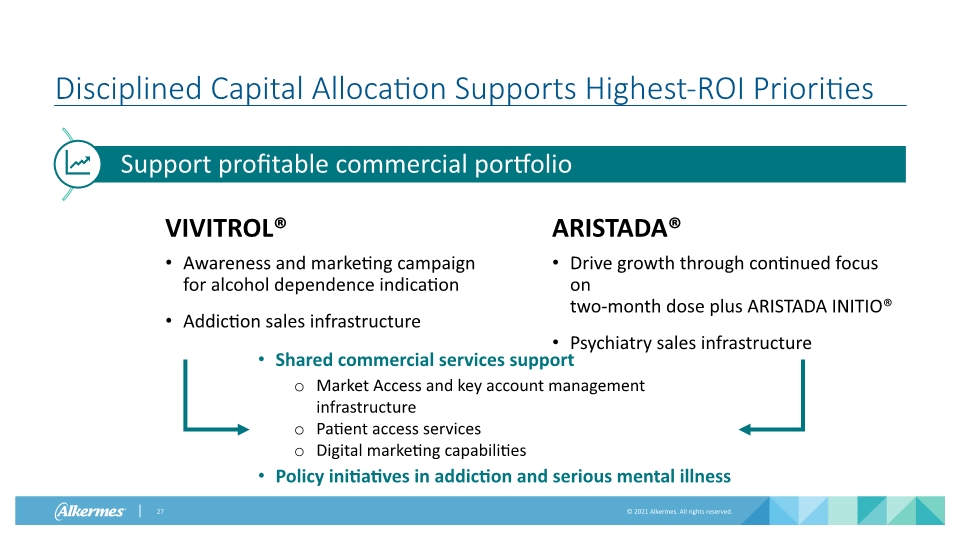
Disciplined Capital Allocation Supports Highest-ROI Priorities VIVITROL® Awareness and marketing campaign for alcohol dependence indication Addiction sales infrastructure ARISTADA® Drive growth through continued focus on two-month dose plus ARISTADA INITIO® Psychiatry sales infrastructure Shared commercial services support Market Access and key account management infrastructure Patient access services Digital marketing capabilities Policy initiatives in addiction and serious mental illness
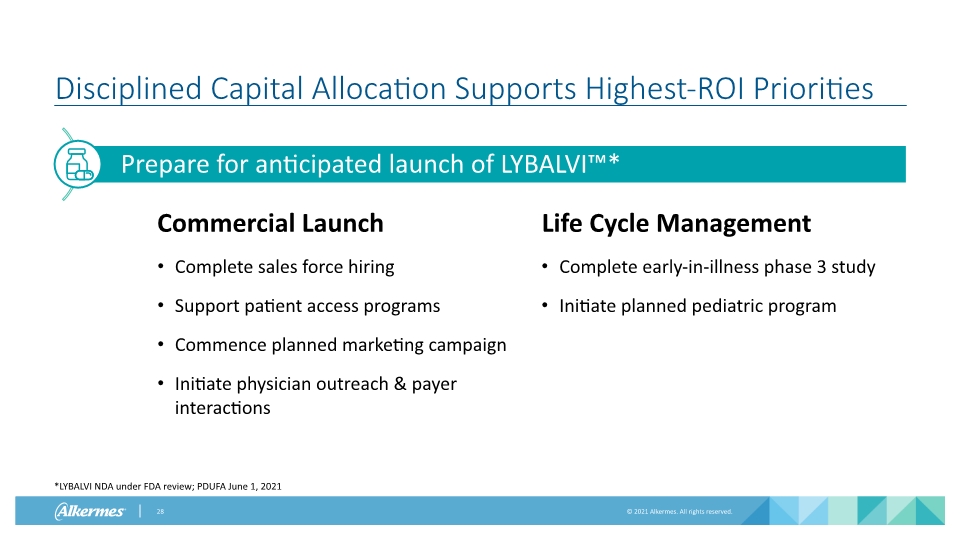
Disciplined Capital Allocation Supports Highest-ROI Priorities Commercial Launch Complete sales force hiring Support patient access programs Commence planned marketing campaign Initiate physician outreach & payer interactions Life Cycle Management Complete early-in-illness phase 3 study Initiate planned pediatric program *LYBALVI NDA under FDA review; PDUFA June 1, 2021
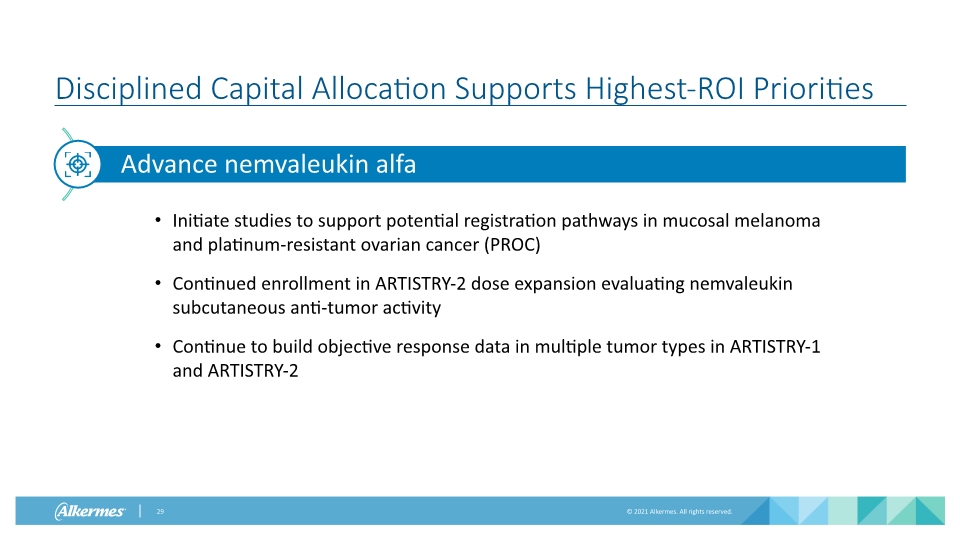
Disciplined Capital Allocation Supports Highest-ROI Priorities Initiate studies to support potential registration pathways in mucosal melanoma and platinum-resistant ovarian cancer (PROC) Continued enrollment in ARTISTRY-2 dose expansion evaluating nemvaleukin subcutaneous anti-tumor activity Continue to build objective response data in multiple tumor types in ARTISTRY-1 and ARTISTRY-2
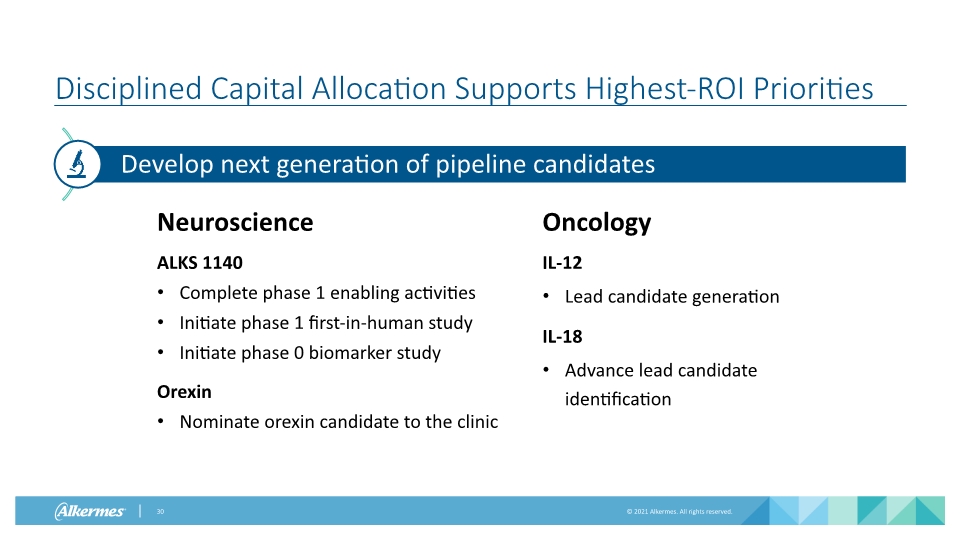
Disciplined Capital Allocation Supports Highest-ROI Priorities Neuroscience ALKS 1140 Complete phase 1 enabling activities Initiate phase 1 first-in-human study Initiate phase 0 biomarker study Orexin Nominate orexin candidate to the clinic Oncology IL-12 Lead candidate generation IL-18 Advance lead candidate identification
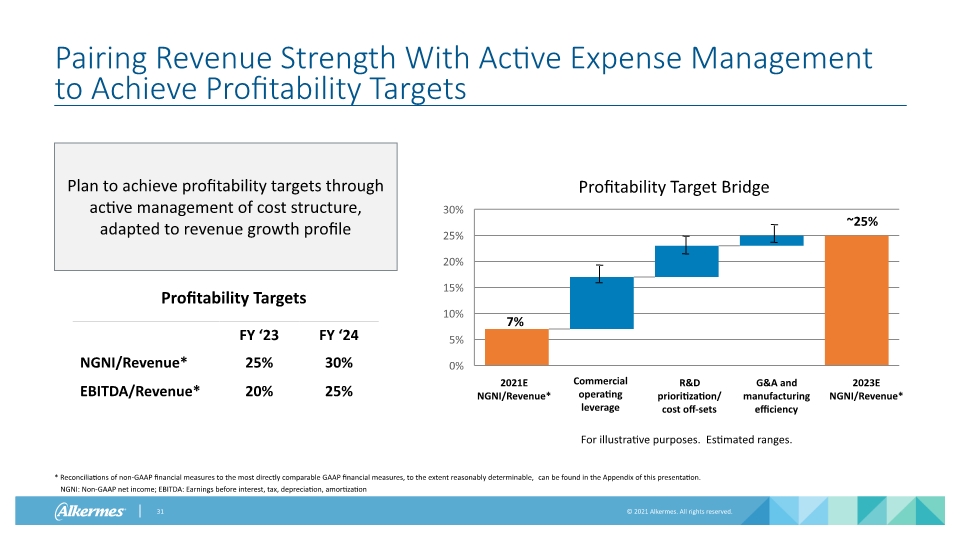
Pairing Revenue Strength With Active Expense Management to Achieve Profitability Targets Plan to achieve profitability targets through active management of cost structure, adapted to revenue growth profile Profitability Targets G&A and manufacturing efficiency R&D prioritization/ cost off-sets Commercial operating leverage ~25% 7% 2021E NGNI/Revenue* 2023E NGNI/Revenue* For illustrative purposes. Estimated ranges. * Reconciliations of non-GAAP financial measures to the most directly comparable GAAP financial measures, to the extent reasonably determinable, can be found in the Appendix of this presentation. NGNI: Non-GAAP net income; EBITDA: Earnings before interest, tax, depreciation, amortization
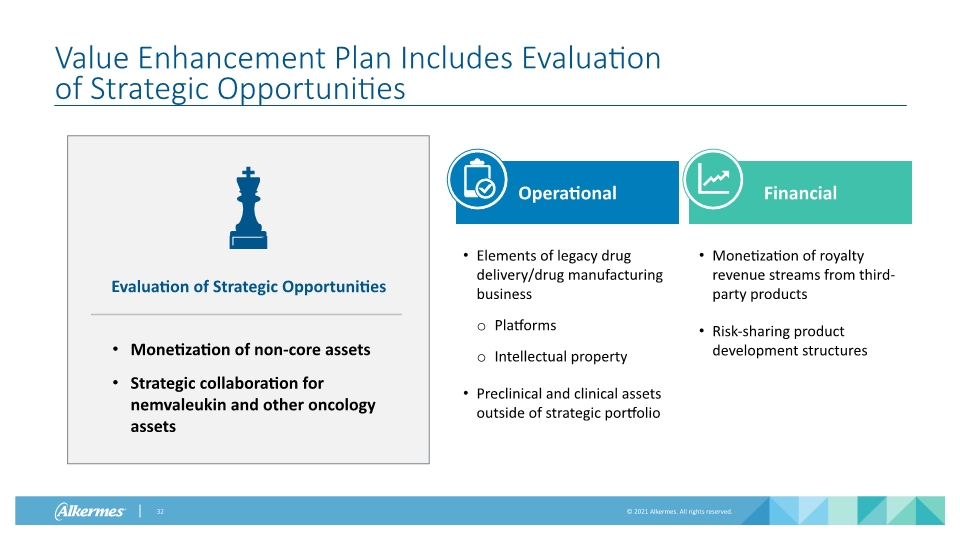
Evaluation of Strategic Opportunities Monetization of non-core assets Strategic collaboration for nemvaleukin and other oncology assets Financial Operational Elements of legacy drug delivery/drug manufacturing business Platforms Intellectual property Preclinical and clinical assets outside of strategic portfolio Monetization of royalty revenue streams from third-party products Risk-sharing product development structures Value Enhancement Plan Includes Evaluation of Strategic Opportunities
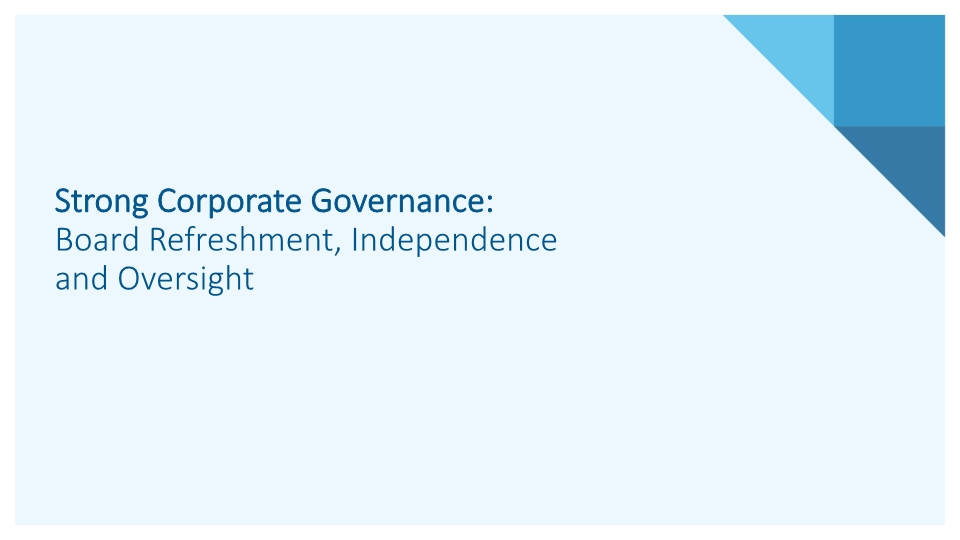
Strong Corporate Governance: Board Refreshment, Independence and Oversight
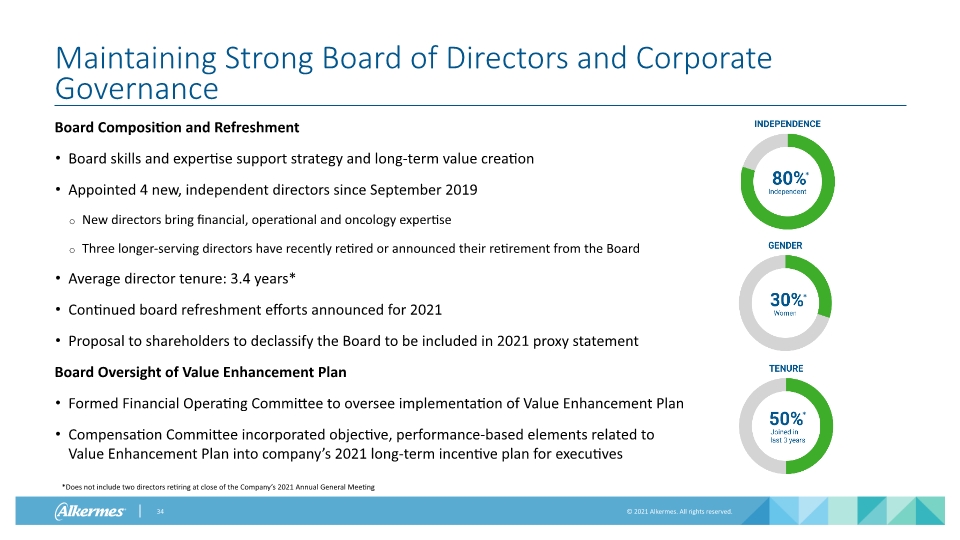
Maintaining Strong Board of Directors and Corporate Governance Board Composition and Refreshment Board skills and expertise support strategy and long-term value creation Appointed 4 new, independent directors since September 2019 New directors bring financial, operational and oncology expertise Three longer-serving directors have recently retired or announced their retirement from the Board Average director tenure: 3.4 years* Continued board refreshment efforts announced for 2021 Proposal to shareholders to declassify the Board to be included in 2021 proxy statement Board Oversight of Value Enhancement Plan Formed Financial Operating Committee to oversee implementation of Value Enhancement Plan Compensation Committee incorporated objective, performance-based elements related to Value Enhancement Plan into company’s 2021 long-term incentive plan for executives *Does not include two directors retiring at close of the Company’s 2021 Annual General Meeting * * *
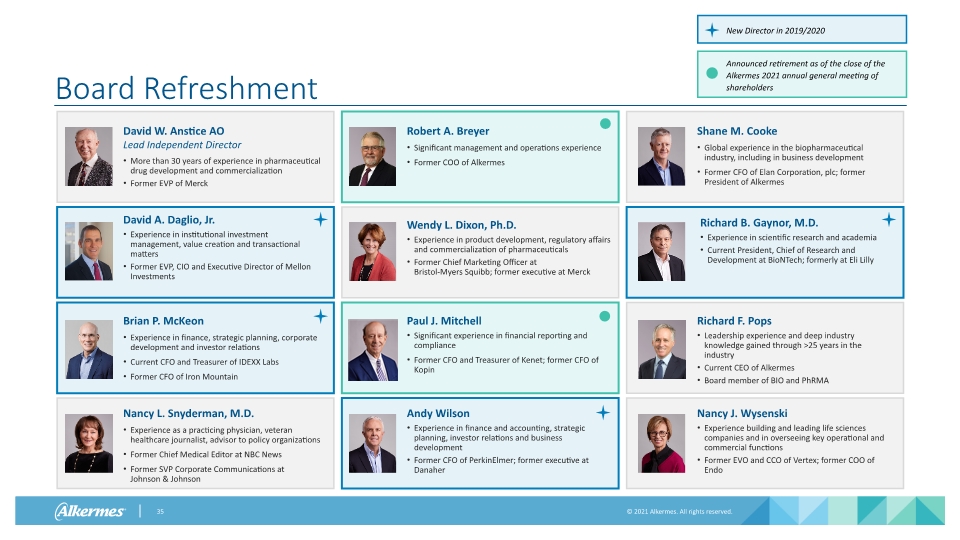
Richard F. Pops Leadership experience and deep industry knowledge gained through >25 years in the industry Current CEO of Alkermes Board member of BIO and PhRMA Andy Wilson Experience in finance and accounting, strategic planning, investor relations and business development Former CFO of PerkinElmer; former executive at Danaher Nancy J. Wysenski Experience building and leading life sciences companies and in overseeing key operational and commercial functions Former EVO and CCO of Vertex; former COO of Endo David W. Anstice AO Lead Independent Director More than 30 years of experience in pharmaceutical drug development and commercialization Former EVP of Merck Wendy L. Dixon, Ph.D. Experience in product development, regulatory affairs and commercialization of pharmaceuticals Former Chief Marketing Officer at Bristol-Myers Squibb; former executive at Merck Shane M. Cooke Global experience in the biopharmaceutical industry, including in business development Former CFO of Elan Corporation, plc; former President of Alkermes David A. Daglio, Jr. Experience in institutional investment management, value creation and transactional matters Former EVP, CIO and Executive Director of Mellon Investments Richard B. Gaynor, M.D. Experience in scientific research and academia Current President, Chief of Research and Development at BioNTech; formerly at Eli Lilly Brian P. McKeon Experience in finance, strategic planning, corporate development and investor relations Current CFO and Treasurer of IDEXX Labs Former CFO of Iron Mountain Nancy L. Snyderman, M.D. Experience as a practicing physician, veteran healthcare journalist, advisor to policy organizations Former Chief Medical Editor at NBC News Former SVP Corporate Communications at Johnson & Johnson New Director in 2019/2020 Robert A. Breyer Significant management and operations experience Former COO of Alkermes Paul J. Mitchell Significant experience in financial reporting and compliance Former CFO and Treasurer of Kenet; former CFO of Kopin Announced retirement as of the close of the Alkermes 2021 annual general meeting of shareholders Board Refreshment
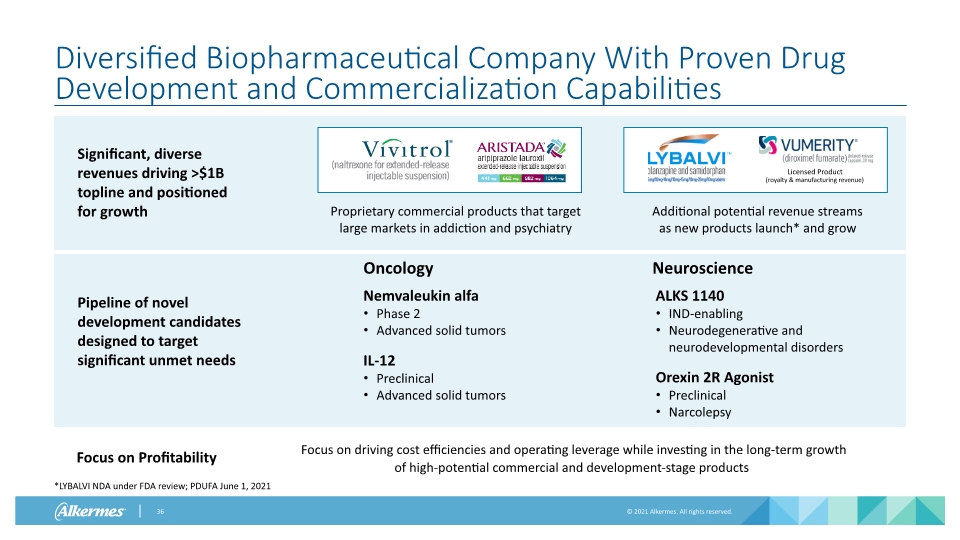
Diversified Biopharmaceutical Company With Proven Drug Development and Commercialization Capabilities Significant, diverse revenues driving >$1B topline and positioned for growth Proprietary commercial products that target large markets in addiction and psychiatry Additional potential revenue streams as new products launch* and grow Licensed Product (royalty & manufacturing revenue) Pipeline of novel development candidates designed to target significant unmet needs ALKS 1140 IND-enabling Neurodegenerative and neurodevelopmental disorders Orexin 2R Agonist Preclinical Narcolepsy Nemvaleukin alfa Phase 2 Advanced solid tumors IL-12 Preclinical Advanced solid tumors Focus on Profitability Oncology Neuroscience Focus on driving cost efficiencies and operating leverage while investing in the long-term growth of high-potential commercial and development-stage products *LYBALVI NDA under FDA review; PDUFA June 1, 2021
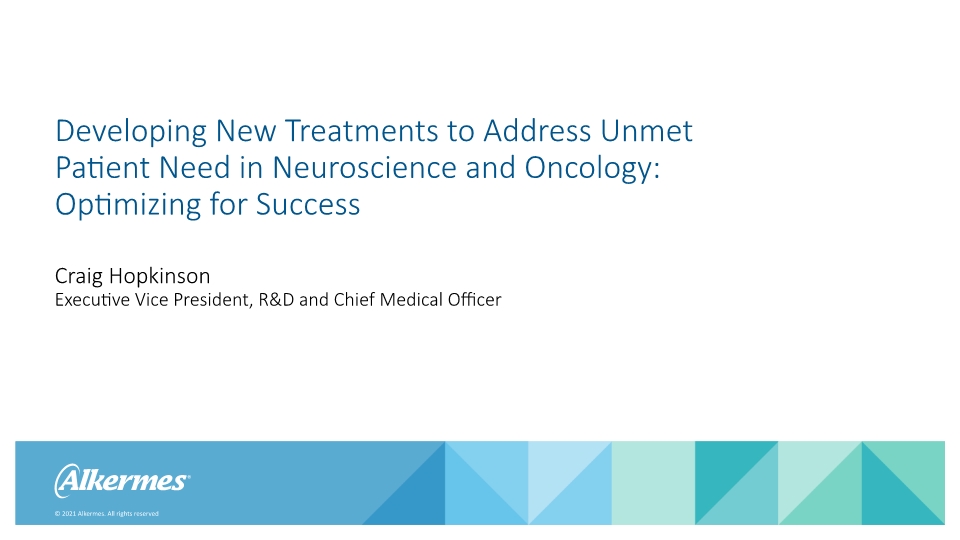
Craig Hopkinson Executive Vice President, R&D and Chief Medical Officer Developing New Treatments to Address Unmet Patient Need in Neuroscience and Oncology: Optimizing for Success
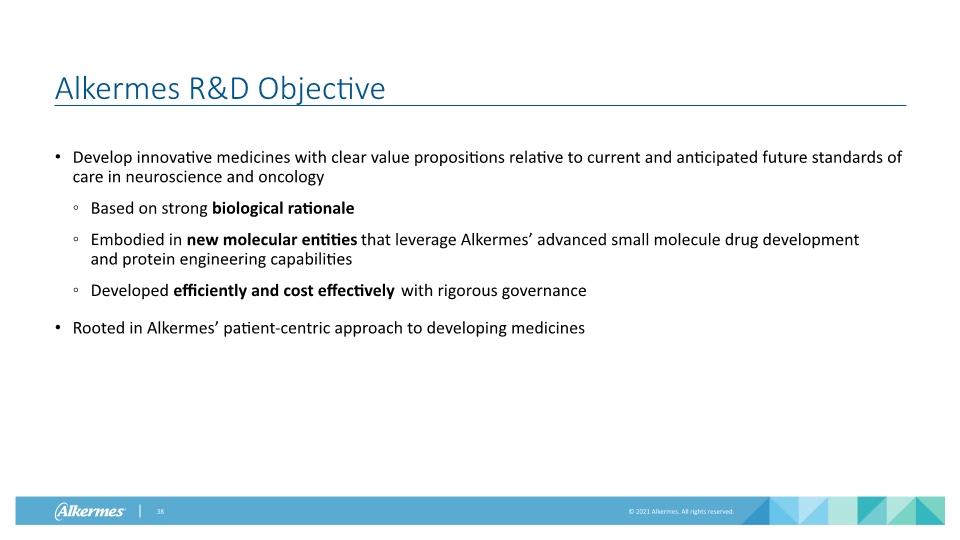
Alkermes R&D Objective Develop innovative medicines with clear value propositions relative to current and anticipated future standards of care in neuroscience and oncology Based on strong biological rationale Embodied in new molecular entities that leverage Alkermes’ advanced small molecule drug development and protein engineering capabilities Developed efficiently and cost effectively with rigorous governance Rooted in Alkermes’ patient-centric approach to developing medicines
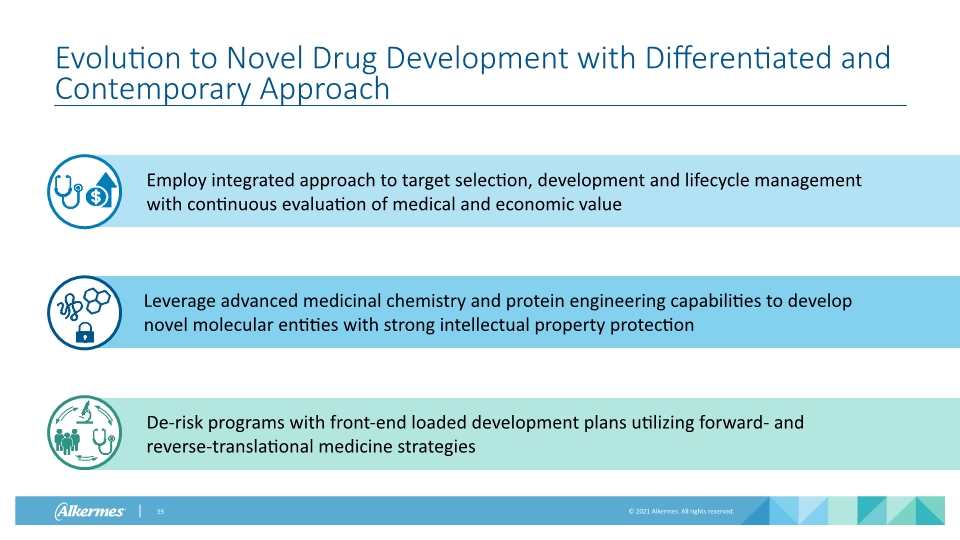
Evolution to Novel Drug Development with Differentiated and Contemporary Approach Leverage advanced medicinal chemistry and protein engineering capabilities to develop novel molecular entities with strong intellectual property protection Employ integrated approach to target selection, development and lifecycle management with continuous evaluation of medical and economic value De-risk programs with front-end loaded development plans utilizing forward- and reverse-translational medicine strategies
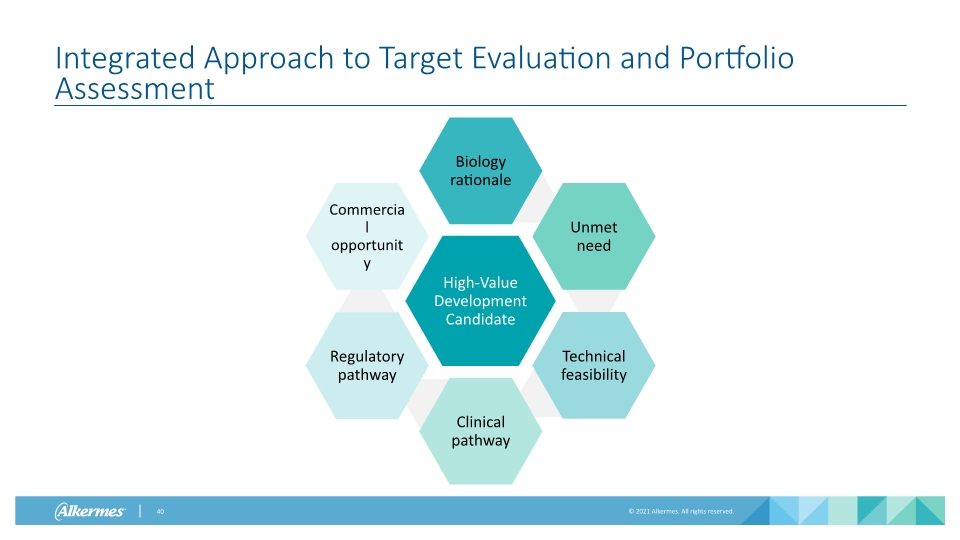
Integrated Approach to Target Evaluation and Portfolio Assessment One line sentence One line sentence One line sentence One Line Sentence One line sentence One line sentence
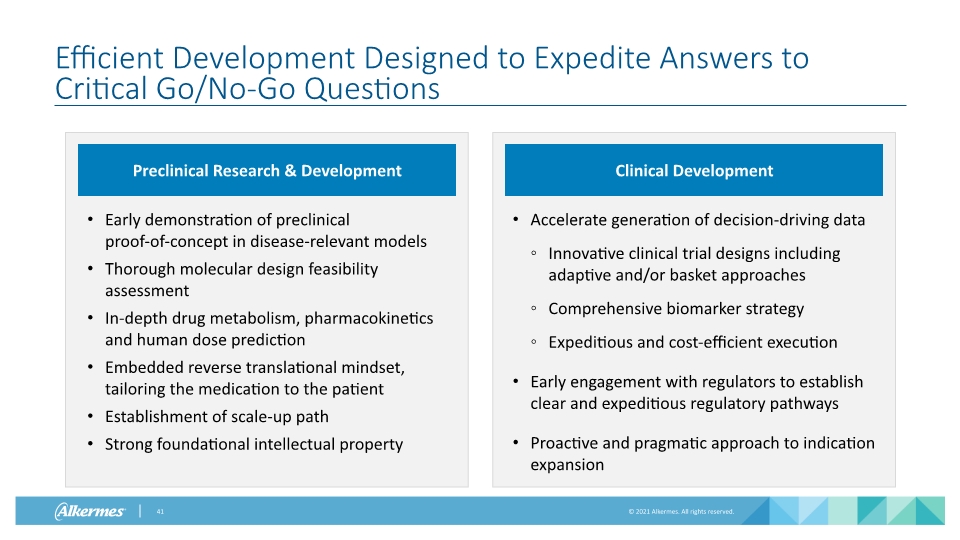
Clinical Development Preclinical Research & Development Efficient Development Designed to Expedite Answers to Critical Go/No-Go Questions Early demonstration of preclinical proof-of-concept in disease-relevant models Thorough molecular design feasibility assessment In-depth drug metabolism, pharmacokinetics and human dose prediction Embedded reverse translational mindset, tailoring the medication to the patient Establishment of scale-up path Strong foundational intellectual property Accelerate generation of decision-driving data Innovative clinical trial designs including adaptive and/or basket approaches Comprehensive biomarker strategy Expeditious and cost-efficient execution Early engagement with regulators to establish clear and expeditious regulatory pathways Proactive and pragmatic approach to indication expansion
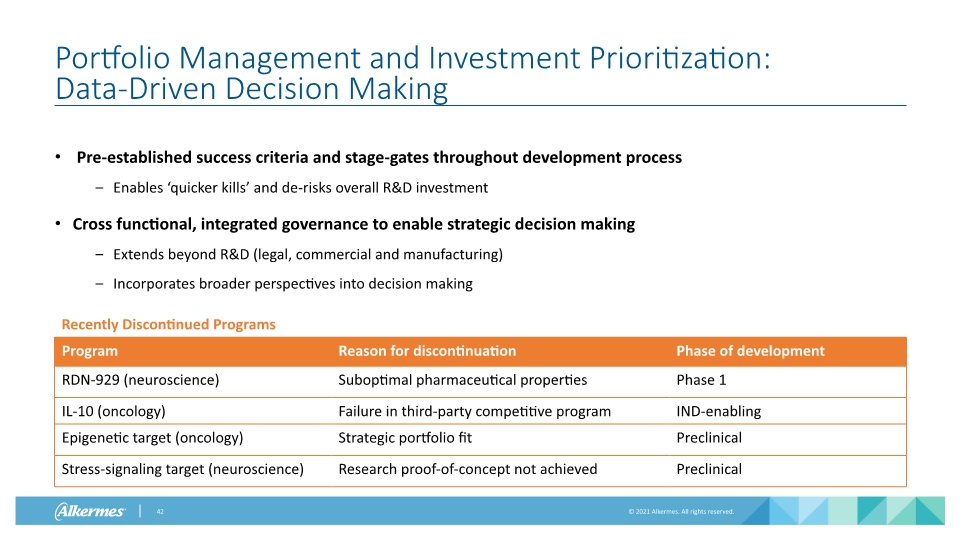
Portfolio Management and Investment Prioritization: Data-Driven Decision Making Pre-established success criteria and stage-gates throughout development process Enables ‘quicker kills’ and de-risks overall R&D investment Cross functional, integrated governance to enable strategic decision making Extends beyond R&D (legal, commercial and manufacturing) Incorporates broader perspectives into decision making Recently Discontinued Programs
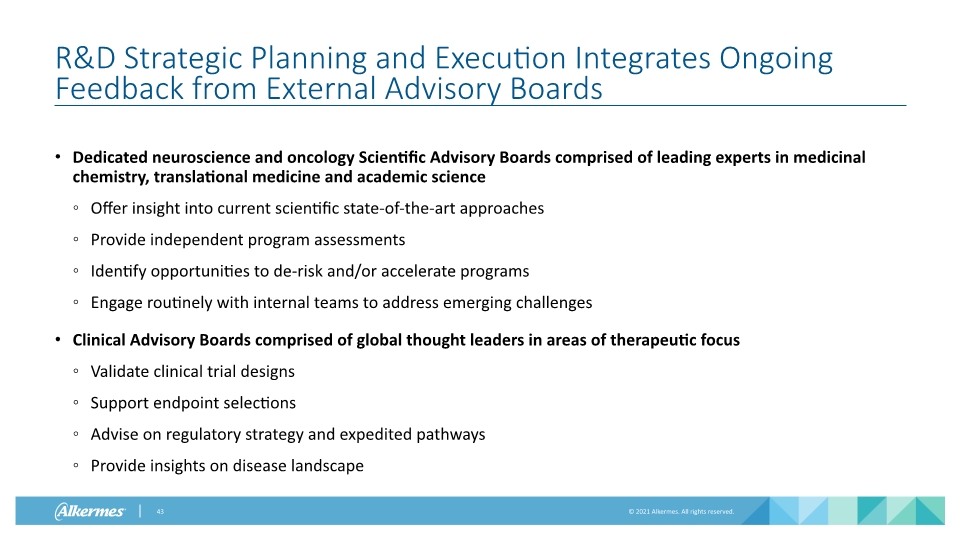
R&D Strategic Planning and Execution Integrates Ongoing Feedback from External Advisory Boards Dedicated neuroscience and oncology Scientific Advisory Boards comprised of leading experts in medicinal chemistry, translational medicine and academic science Offer insight into current scientific state-of-the-art approaches Provide independent program assessments Identify opportunities to de-risk and/or accelerate programs Engage routinely with internal teams to address emerging challenges Clinical Advisory Boards comprised of global thought leaders in areas of therapeutic focus Validate clinical trial designs Support endpoint selections Advise on regulatory strategy and expedited pathways Provide insights on disease landscape
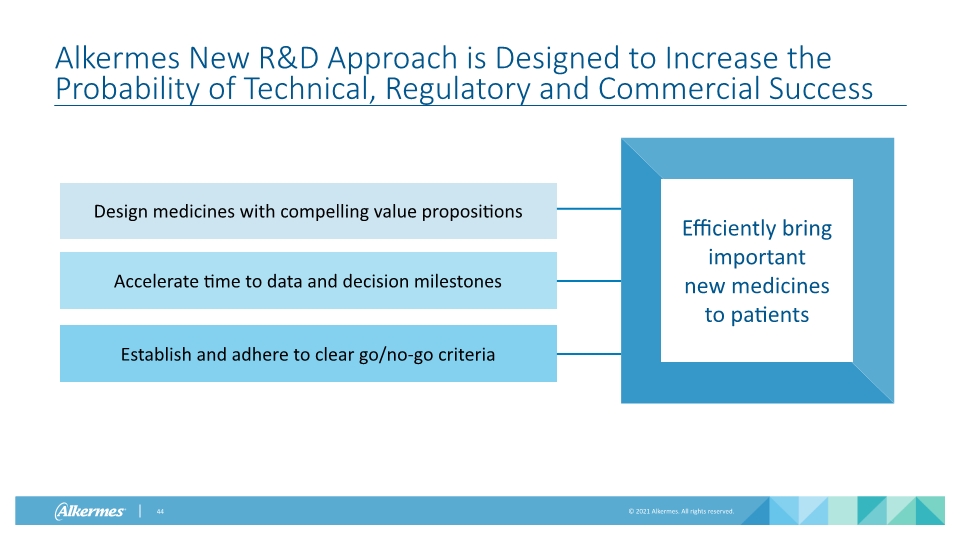
Alkermes New R&D Approach is Designed to Increase the Probability of Technical, Regulatory and Commercial Success Efficiently bring important new medicines to patients Design medicines with compelling value propositions Accelerate time to data and decision milestones Establish and adhere to clear go/no-go criteria
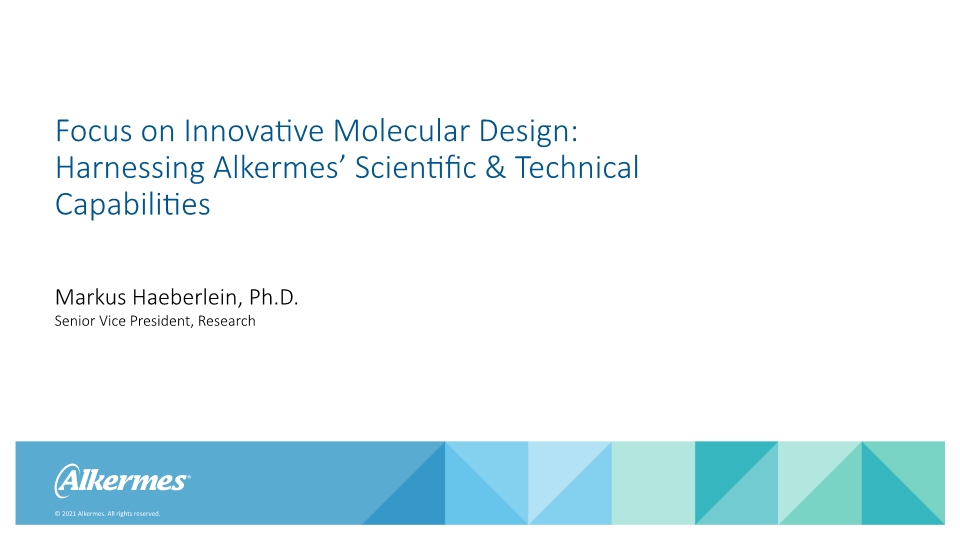
Markus Haeberlein, Ph.D. Focus on Innovative Molecular Design: Harnessing Alkermes’ Scientific & Technical Capabilities Senior Vice President, Research
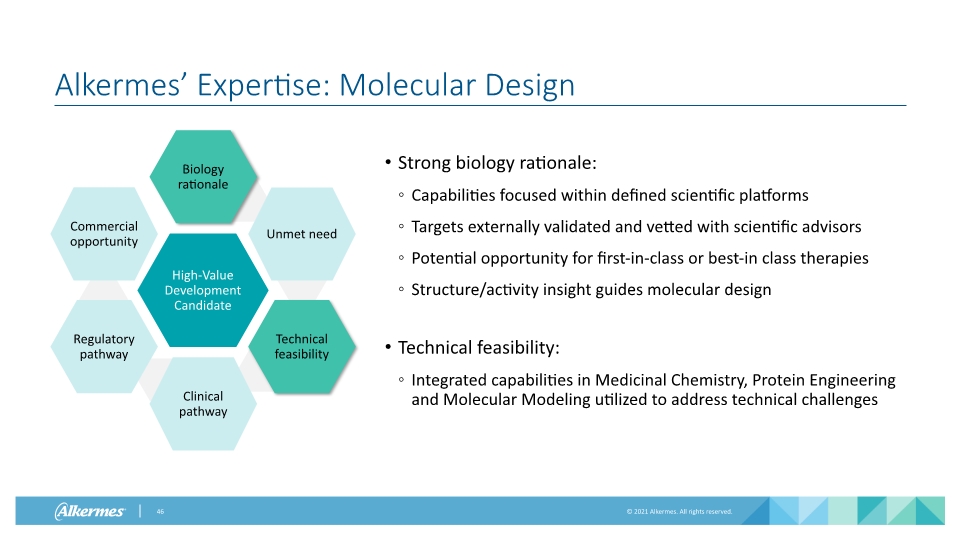
Alkermes’ Expertise: Molecular Design Strong biology rationale: Capabilities focused within defined scientific platforms Targets externally validated and vetted with scientific advisors Potential opportunity for first-in-class or best-in class therapies Structure/activity insight guides molecular design Technical feasibility: Integrated capabilities in Medicinal Chemistry, Protein Engineering and Molecular Modeling utilized to address technical challenges One line sentence One line sentence One line sentence One Line Sentence One line sentence One line sentence
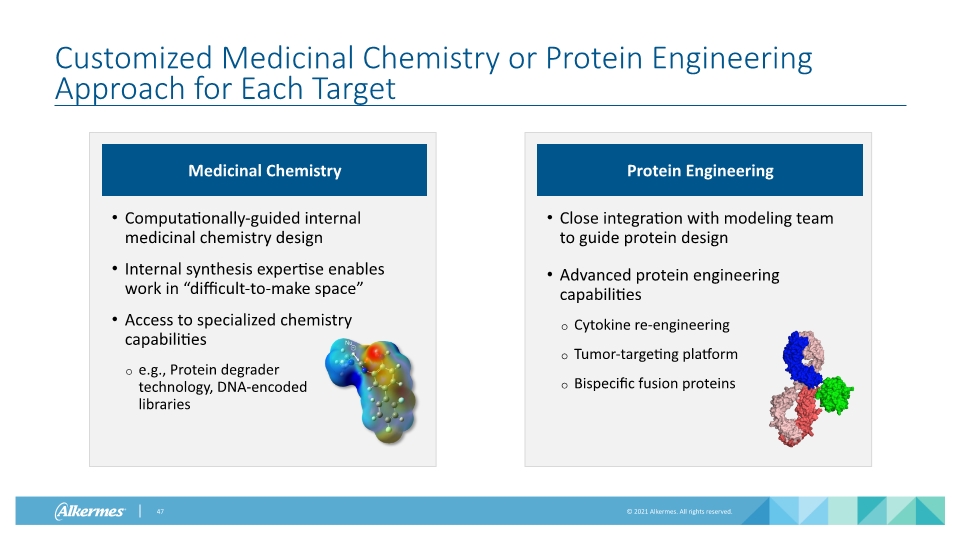
Customized Medicinal Chemistry or Protein Engineering Approach for Each Target
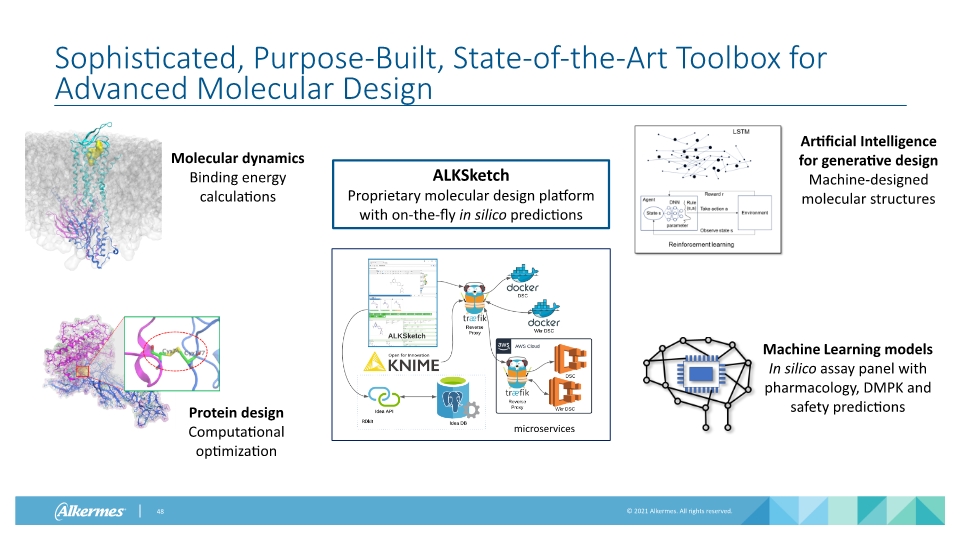
Sophisticated, Purpose-Built, State-of-the-Art Toolbox for Advanced Molecular Design ALKSketch Proprietary molecular design platform with on-the-fly in silico predictions
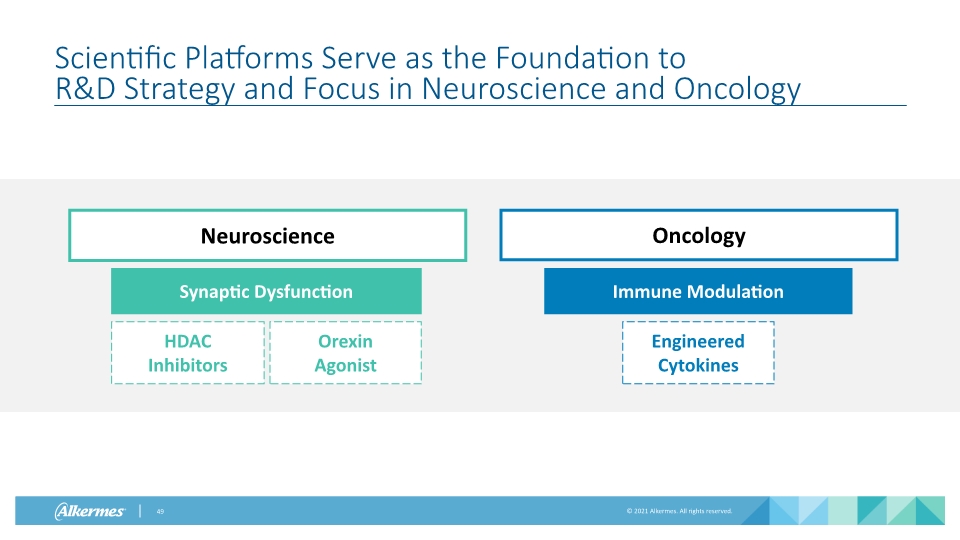
Scientific Platforms Serve as the Foundation to R&D Strategy and Focus in Neuroscience and Oncology Synaptic Dysfunction Immune Modulation Oncology Neuroscience Engineered Cytokines HDAC Inhibitors Orexin Agonist
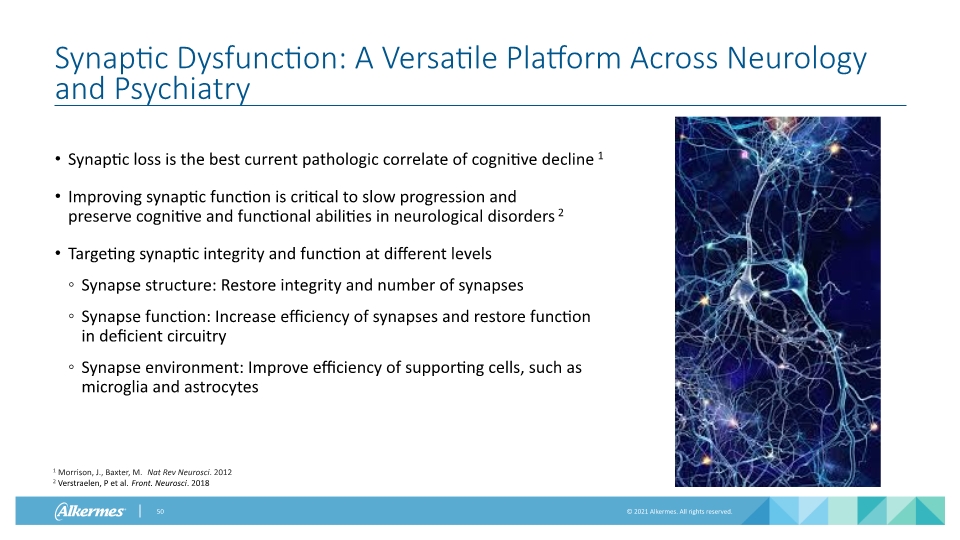
Synaptic Dysfunction: A Versatile Platform Across Neurology and Psychiatry Synaptic loss is the best current pathologic correlate of cognitive decline1 Improving synaptic function is critical to slow progression and preserve cognitive and functional abilities in neurological disorders2 Targeting synaptic integrity and function at different levels Synapse structure: Restore integrity and number of synapses Synapse function: Increase efficiency of synapses and restore function in deficient circuitry Synapse environment: Improve efficiency of supporting cells, such as microglia and astrocytes 1 Morrison, J., Baxter, M. Nat Rev Neurosci. 2012 2 Verstraelen, P et al. Front. Neurosci. 2018
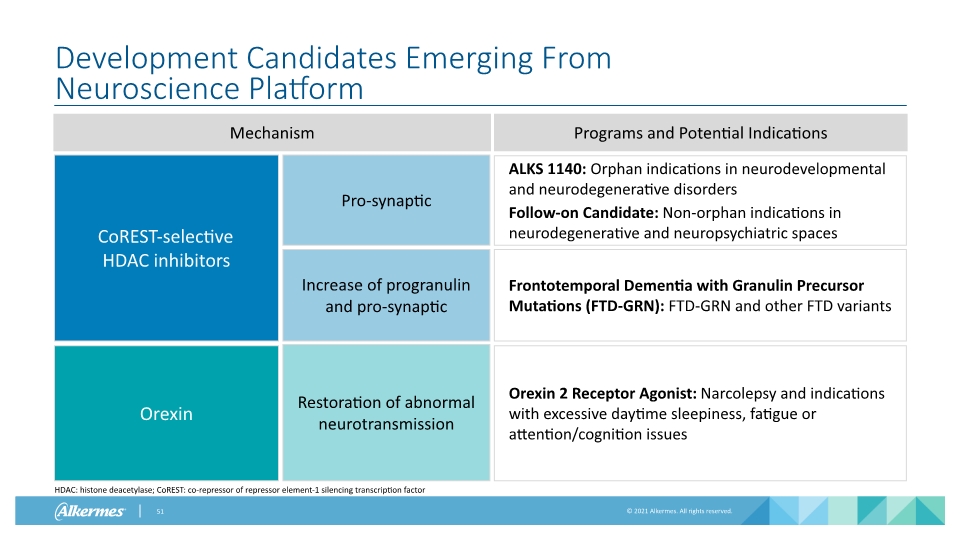
Development Candidates Emerging From Neuroscience Platform HDAC: histone deacetylase; CoREST: co-repressor of repressor element-1 silencing transcription factor

Immune Modulation in Oncology Based on Engineered Cytokines Proinflammatory cytokines have pleiotropic effects and can act on every phase of the cancer immunity cycle1 Alkermes is focusing on cytokine-based therapies designed to: Increase visibility of tumor cells to immune system Increase tumor-killing potential of CD8+ T and NK cells Remove suppressive signals in the tumor microenvironment Modern cytokine-based drugs need a high degree of engineering to: Reduce side effects Improve pharmacokinetics Enhance efficacy NK: natural killer 1 Berraondo, et al. British Journal of Cancer. 2019 Cytokine Mutation Cytokine IgG Bispecific Cytokine ScFv Bispecific Cytokine Fusion Cytokine Fusionbody
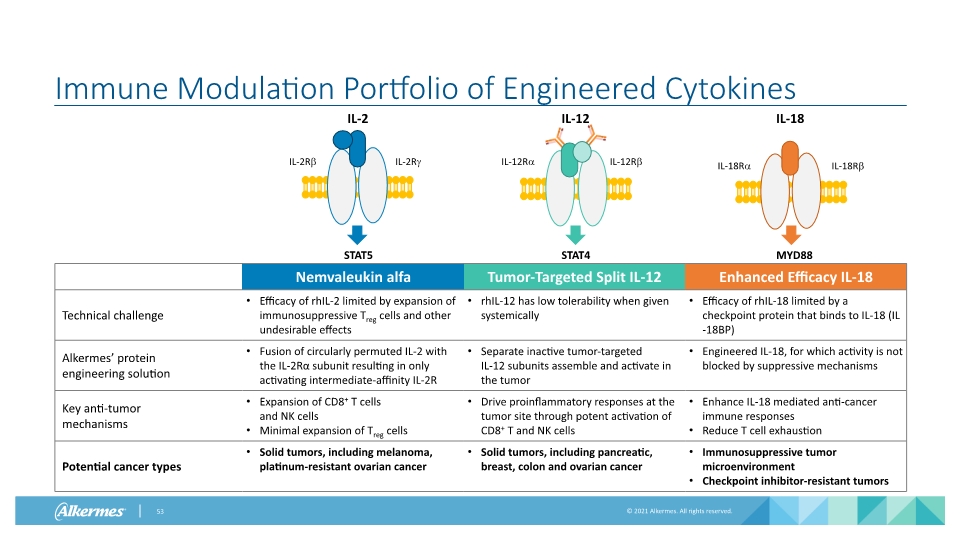
Immune Modulation Portfolio of Engineered Cytokines IL-18R IL-18R MYD88 IL-2Rg IL-2R STAT5 IL-12R IL-12R STAT4 IL-18 IL-2 IL-12
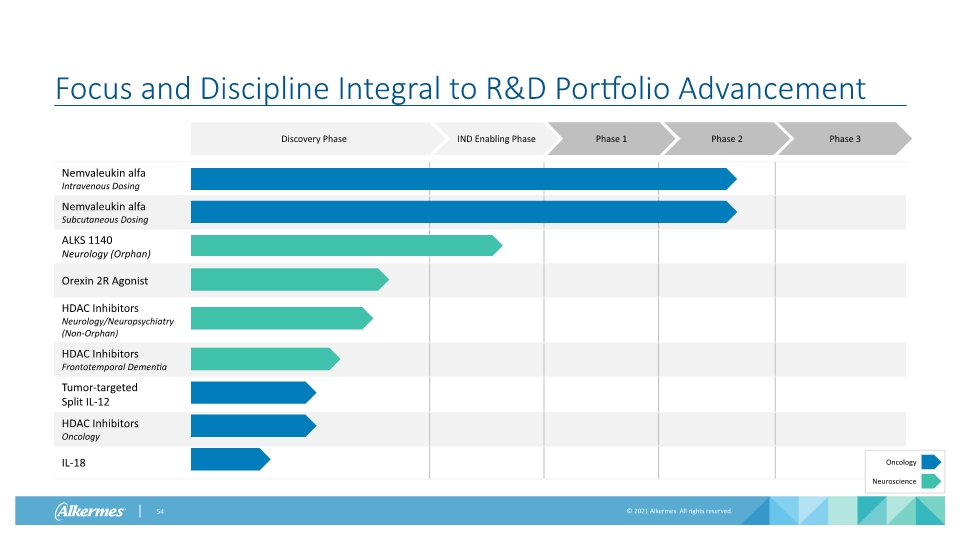
Focus and Discipline Integral to R&D Portfolio Advancement Discovery Phase Phase 1 Phase 2 Phase 3 IND Enabling Phase Oncology Neuroscience
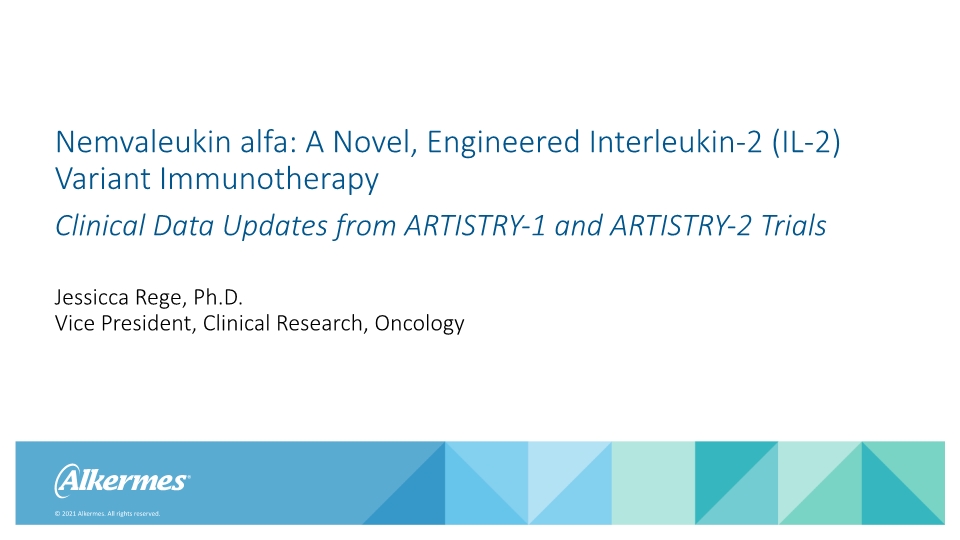
Jessicca Rege, Ph.D. Vice President, Clinical Research, Oncology Nemvaleukin alfa: A Novel, Engineered Interleukin-2 (IL-2) Variant Immunotherapy Clinical Data Updates from ARTISTRY-1 and ARTISTRY-2 Trials
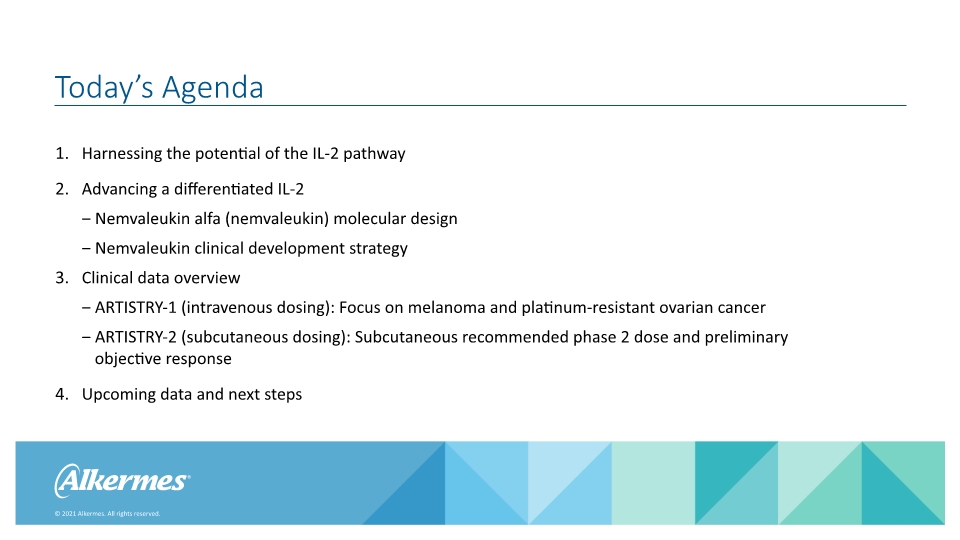
Harnessing the potential of the IL-2 pathway Advancing a differentiated IL-2 ‒ Nemvaleukin alfa (nemvaleukin) molecular design ‒ Nemvaleukin clinical development strategy Clinical data overview ‒ ARTISTRY-1 (intravenous dosing): Focus on melanoma and platinum-resistant ovarian cancer ‒ ARTISTRY-2 (subcutaneous dosing): Subcutaneous recommended phase 2 dose and preliminary objective response Upcoming data and next steps Today’s Agenda
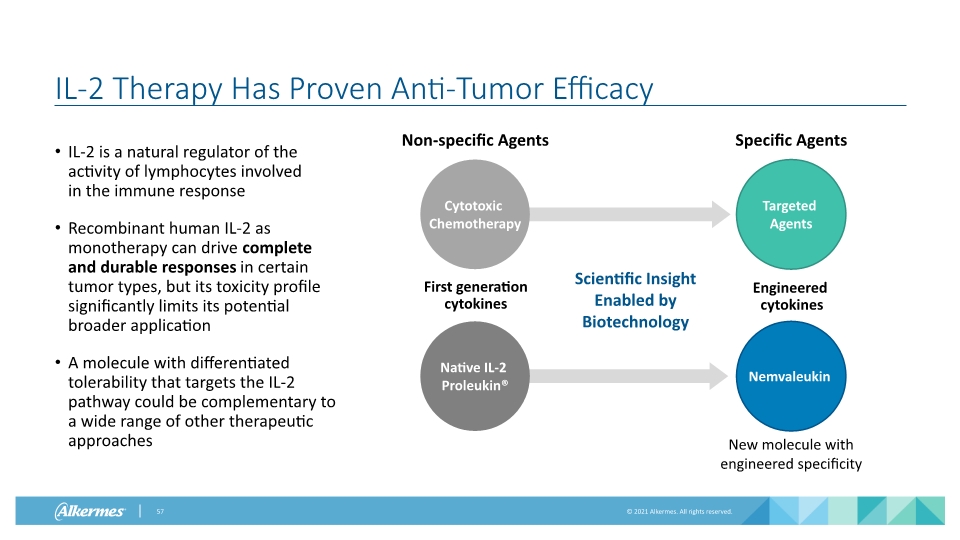
IL-2 Therapy Has Proven Anti-Tumor Efficacy IL-2 is a natural regulator of the activity of lymphocytes involved in the immune response Recombinant human IL-2 as monotherapy can drive complete and durable responses in certain tumor types, but its toxicity profile significantly limits its potential broader application A molecule with differentiated tolerability that targets the IL-2 pathway could be complementary to a wide range of other therapeutic approaches Scientific Insight Enabled by Biotechnology New molecule with engineered specificity Cytotoxic Chemotherapy Non-specific Agents Specific Agents First generation cytokines Engineered cytokines Native IL-2 Proleukin® Targeted Agents Nemvaleukin
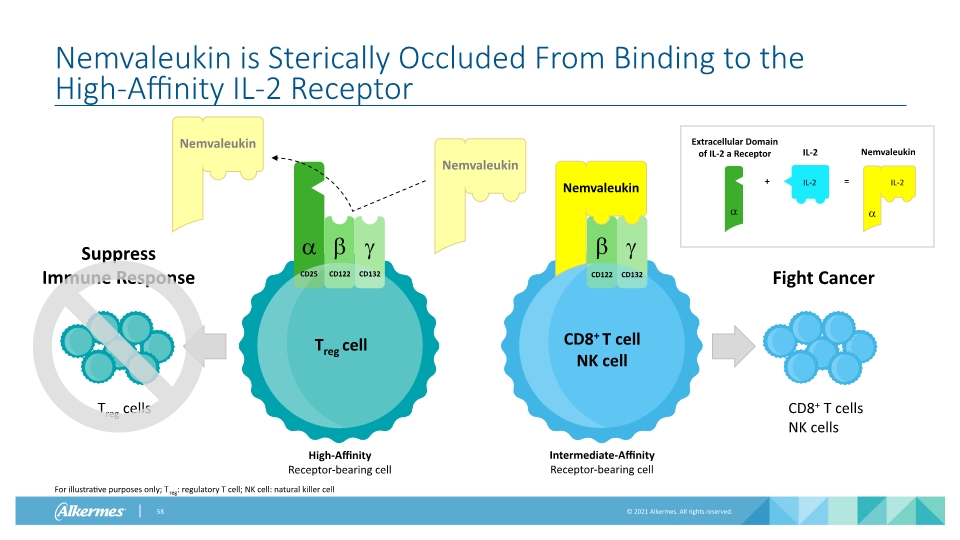
Nemvaleukin is Sterically Occluded From Binding to the High-Affinity IL-2 Receptor b a High-Affinity Receptor-bearing cell b Intermediate-Affinity Receptor-bearing cell CD8+ T cell NK cell CD122 CD132 Treg cell CD25 CD122 CD132 Suppress Immune Response Treg cells For illustrative purposes only; Treg: regulatory T cell; NK cell: natural killer cell Nemvaleukin IL-2 Extracellular Domain of IL-2 a Receptor + =
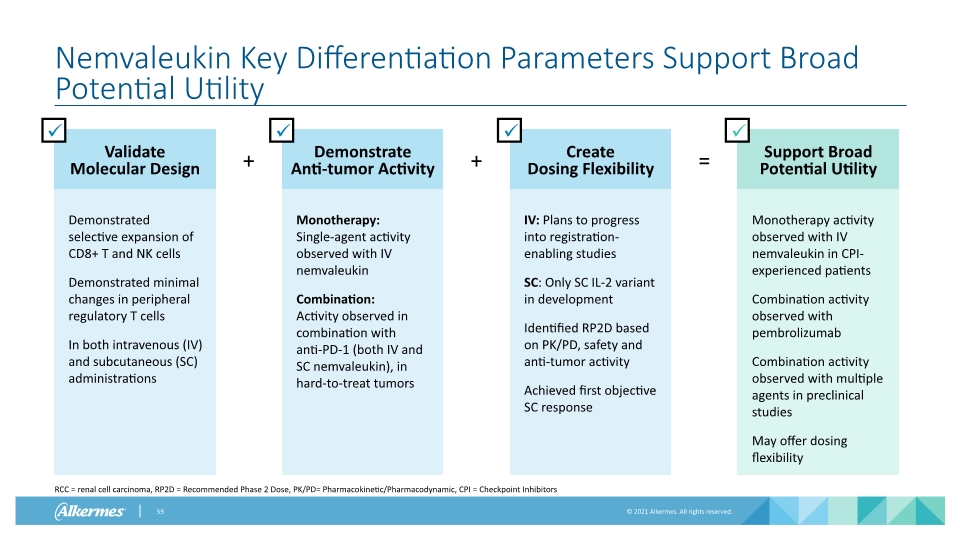
Nemvaleukin Key Differentiation Parameters Support Broad Potential Utility Support Broad Potential Utility = Monotherapy activity observed with IV nemvaleukin in CPI- experienced patients Combination activity observed with pembrolizumab Combination activity observed with multiple agents in preclinical studies May offer dosing flexibility RCC = renal cell carcinoma, RP2D = Recommended Phase 2 Dose, PK/PD= Pharmacokinetic/Pharmacodynamic, CPI = Checkpoint Inhibitors Validate Molecular Design Demonstrate Anti-tumor Activity Create Dosing Flexibility + + Demonstrated selective expansion of CD8+ T and NK cells Demonstrated minimal changes in peripheral regulatory T cells In both intravenous (IV) and subcutaneous (SC) administrations Monotherapy: Single-agent activity observed with IV nemvaleukin Combination: Activity observed in combination with anti-PD-1 (both IV and SC nemvaleukin), in hard-to-treat tumors IV: Plans to progress into registration-enabling studies SC: Only SC IL-2 variant in development Identified RP2D based on PK/PD, safety and anti-tumor activity Achieved first objective SC response
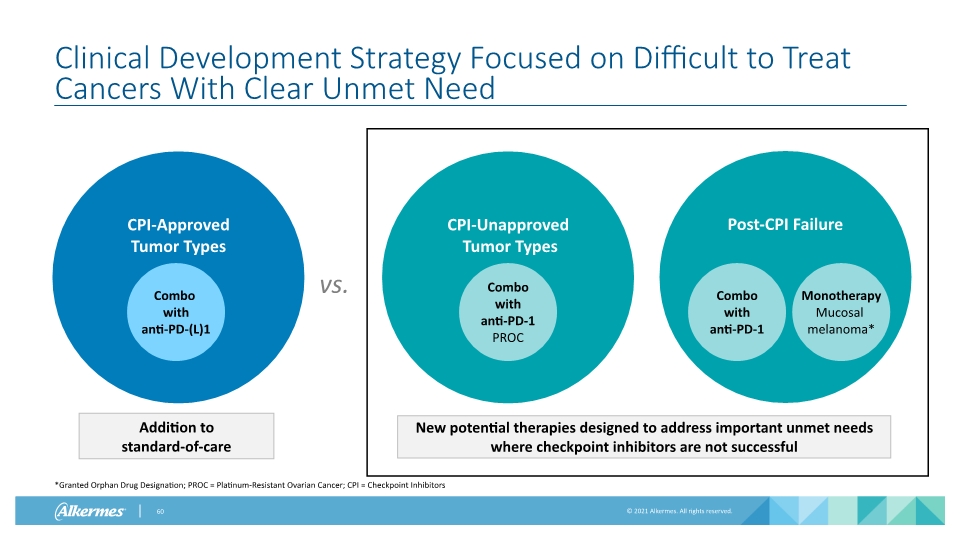
Clinical Development Strategy Focused on Difficult to Treat Cancers With Clear Unmet Need CPI-Unapproved Tumor Types CPI-Approved Tumor Types Combo with anti-PD-(L)1 Combo with anti-PD-1 PROC Addition to standard-of-care vs. New potential therapies designed to address important unmet needs where checkpoint inhibitors are not successful Post-CPI Failure Combo with anti-PD-1 Monotherapy Mucosal melanoma* *Granted Orphan Drug Designation; PROC = Platinum-Resistant Ovarian Cancer; CPI = Checkpoint Inhibitors
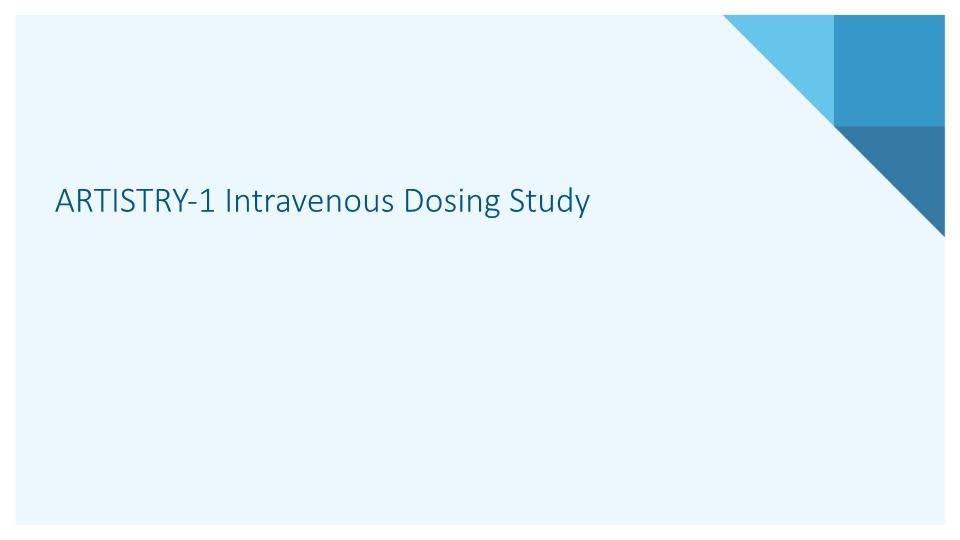
ARTISTRY-1 Intravenous Dosing Study
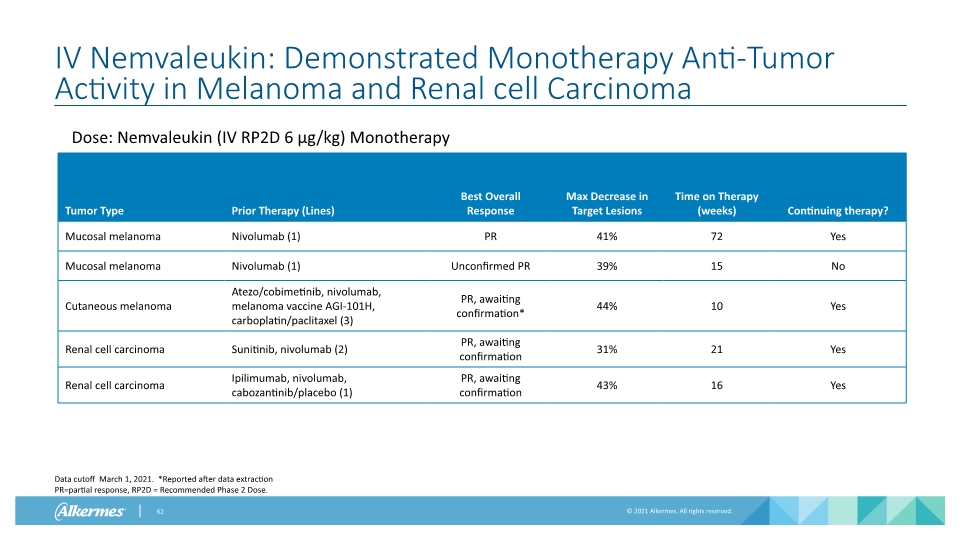
IV Nemvaleukin: Demonstrated Monotherapy Anti-Tumor Activity in Melanoma and Renal cell Carcinoma Data cutoff March 1, 2021. *Reported after data extraction PR=partial response, RP2D = Recommended Phase 2 Dose. Dose: Nemvaleukin (IV RP2D 6 µg/kg) Monotherapy
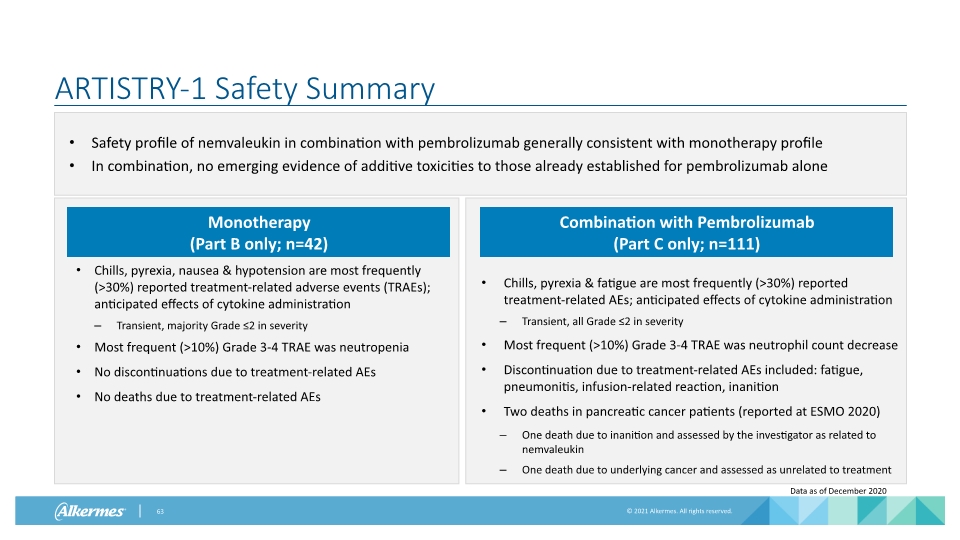
Safety profile of nemvaleukin in combination with pembrolizumab generally consistent with monotherapy profile In combination, no emerging evidence of additive toxicities to those already established for pembrolizumab alone ARTISTRY-1 Safety Summary Chills, pyrexia & fatigue are most frequently (>30%) reported treatment-related AEs; anticipated effects of cytokine administration Transient, all Grade ≤2 in severity Most frequent (>10%) Grade 3-4 TRAE was neutrophil count decrease Discontinuation due to treatment-related AEs included: fatigue, pneumonitis, infusion-related reaction, inanition Two deaths in pancreatic cancer patients (reported at ESMO 2020) One death due to inanition and assessed by the investigator as related to nemvaleukin One death due to underlying cancer and assessed as unrelated to treatment Chills, pyrexia, nausea & hypotension are most frequently (>30%) reported treatment-related adverse events (TRAEs); anticipated effects of cytokine administration Transient, majority Grade ≤2 in severity Most frequent (>10%) Grade 3-4 TRAE was neutropenia No discontinuations due to treatment-related AEs No deaths due to treatment-related AEs Monotherapy (Part B only; n=42) Combination with Pembrolizumab (Part C only; n=111) Data as of December 2020
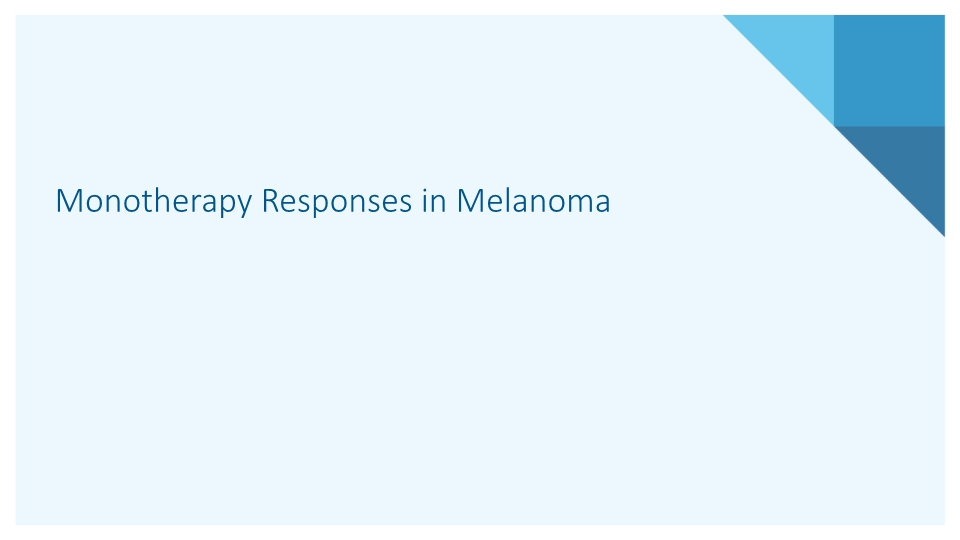
Monotherapy Responses in Melanoma
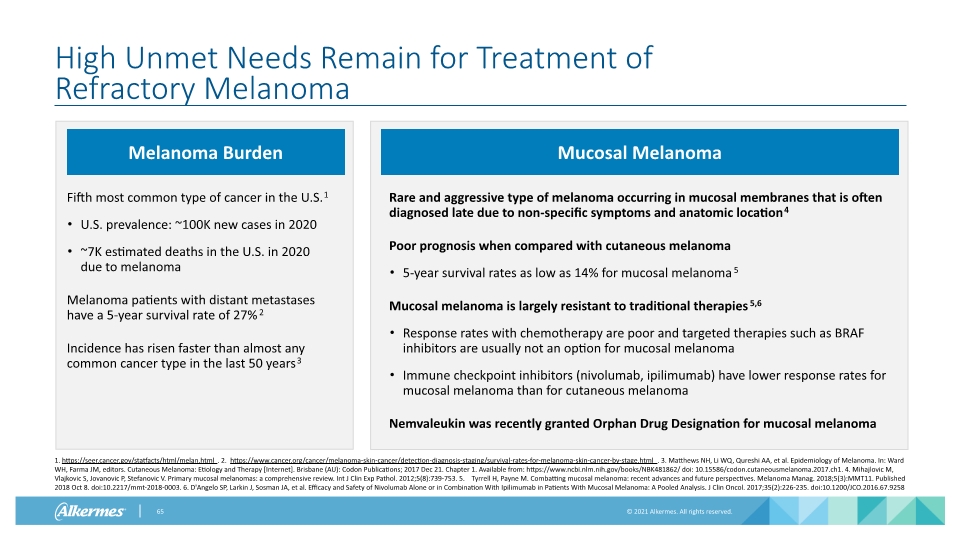
High Unmet Needs Remain for Treatment of Refractory Melanoma Fifth most common type of cancer in the U.S.1 U.S. prevalence: ~100K new cases in 2020 ~7K estimated deaths in the U.S. in 2020 due to melanoma Melanoma patients with distant metastases have a 5-year survival rate of 27%2 Incidence has risen faster than almost any common cancer type in the last 50 years3 Rare and aggressive type of melanoma occurring in mucosal membranes that is often diagnosed late due to non-specific symptoms and anatomic location4 Poor prognosis when compared with cutaneous melanoma 5-year survival rates as low as 14% for mucosal melanoma5 Mucosal melanoma is largely resistant to traditional therapies5,6 Response rates with chemotherapy are poor and targeted therapies such as BRAF inhibitors are usually not an option for mucosal melanoma Immune checkpoint inhibitors (nivolumab, ipilimumab) have lower response rates for mucosal melanoma than for cutaneous melanoma Nemvaleukin was recently granted Orphan Drug Designation for mucosal melanoma Mucosal Melanoma Melanoma Burden 1. https://seer.cancer.gov/statfacts/html/melan.html. 2. https://www.cancer.org/cancer/melanoma-skin-cancer/detection-diagnosis-staging/survival-rates-for-melanoma-skin-cancer-by-stage.html. 3. Matthews NH, Li WQ, Qureshi AA, et al. Epidemiology of Melanoma. In: Ward WH, Farma JM, editors. Cutaneous Melanoma: Etiology and Therapy [Internet]. Brisbane (AU): Codon Publications; 2017 Dec 21. Chapter 1. Available from: https://www.ncbi.nlm.nih.gov/books/NBK481862/ doi: 10.15586/codon.cutaneousmelanoma.2017.ch1. 4. Mihajlovic M, Vlajkovic S, Jovanovic P, Stefanovic V. Primary mucosal melanomas: a comprehensive review. Int J Clin Exp Pathol. 2012;5(8):739-753. 5. Tyrrell H, Payne M. Combatting mucosal melanoma: recent advances and future perspectives. Melanoma Manag. 2018;5(3):MMT11. Published 2018 Oct 8. doi:10.2217/mmt-2018-0003. 6. D'Angelo SP, Larkin J, Sosman JA, et al. Efficacy and Safety of Nivolumab Alone or in Combination With Ipilimumab in Patients With Mucosal Melanoma: A Pooled Analysis. J Clin Oncol. 2017;35(2):226-235. doi:10.1200/JCO.2016.67.9258
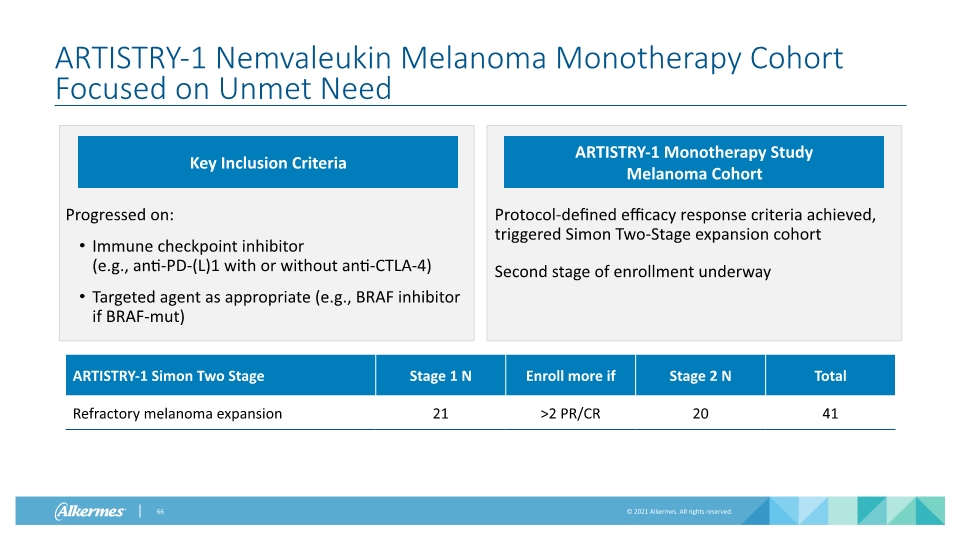
ARTISTRY-1 Monotherapy Study Melanoma Cohort ARTISTRY-1 Nemvaleukin Melanoma Monotherapy Cohort Focused on Unmet Need Progressed on: Immune checkpoint inhibitor (e.g., anti-PD-(L)1 with or without anti-CTLA-4) Targeted agent as appropriate (e.g., BRAF inhibitor if BRAF-mut) Protocol-defined efficacy response criteria achieved, triggered Simon Two-Stage expansion cohort Second stage of enrollment underway Key Inclusion Criteria
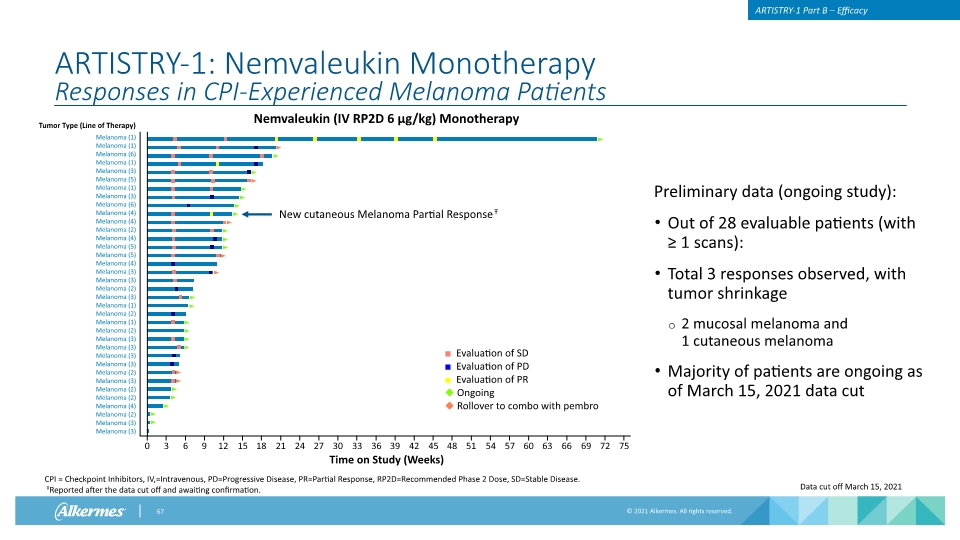
ARTISTRY-1: Nemvaleukin Monotherapy Responses in CPI-Experienced Melanoma Patients Preliminary data (ongoing study): Out of 28 evaluable patients (with ≥ 1 scans): Total 3 responses observed, with tumor shrinkage 2 mucosal melanoma and 1 cutaneous melanoma Majority of patients are ongoing as of March 15, 2021 data cut ARTISTRY-1 Part B – Efficacy Nemvaleukin (IV RP2D 6 µg/kg) Monotherapy Tumor Type (Line of Therapy) Time on Study (Weeks) 0 3 6 9 21 24 27 33 39 42 48 54 57 60 66 69 75 72 63 51 45 36 30 18 15 12 Melanoma (1) Melanoma (1) Melanoma (6) Melanoma (1) Melanoma (3) Melanoma (5) Melanoma (1) Melanoma (3) Melanoma (6) Melanoma (4) Melanoma (4) Melanoma (2) Melanoma (4) Melanoma (5) Melanoma (5) Melanoma (4) Melanoma (3) Melanoma (3) Melanoma (2) Melanoma (3) Melanoma (1) Melanoma (2) Melanoma (1) Melanoma (2) Melanoma (3) Melanoma (3) Melanoma (3) Melanoma (3) Melanoma (2) Melanoma (3) Melanoma (2) Melanoma (2) Melanoma (4) Melanoma (2) Melanoma (3) Melanoma (3) ■ Evaluation of SD ■ Evaluation of PD ■ Evaluation of PR Ongoing Rollover to combo with pembro Data cut off March 15, 2021 New cutaneous Melanoma Partial ResponseŦ CPI = Checkpoint Inhibitors, IV,=Intravenous, PD=Progressive Disease, PR=Partial Response, RP2D=Recommended Phase 2 Dose, SD=Stable Disease. ŦReported after the data cut off and awaiting confirmation.
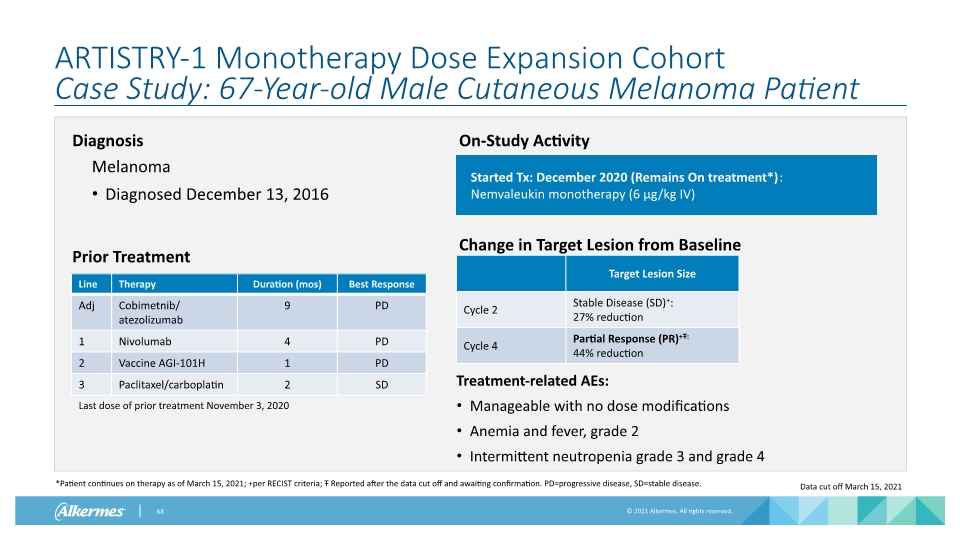
ARTISTRY-1 Monotherapy Dose Expansion Cohort Case Study: 67-Year-old Male Cutaneous Melanoma Patient Started Tx: December 2020 (Remains On treatment*): Nemvaleukin monotherapy (6 µg/kg IV) Treatment-related AEs: Manageable with no dose modifications Anemia and fever, grade 2 Intermittent neutropenia grade 3 and grade 4 Last dose of prior treatment November 3, 2020 On-Study Activity Diagnosis Prior Treatment Melanoma Diagnosed December 13, 2016 Change in Target Lesion from Baseline Data cut off March 15, 2021 *Patient continues on therapy as of March 15, 2021; +per RECIST criteria; Ŧ Reported after the data cut off and awaiting confirmation. PD=progressive disease, SD=stable disease.
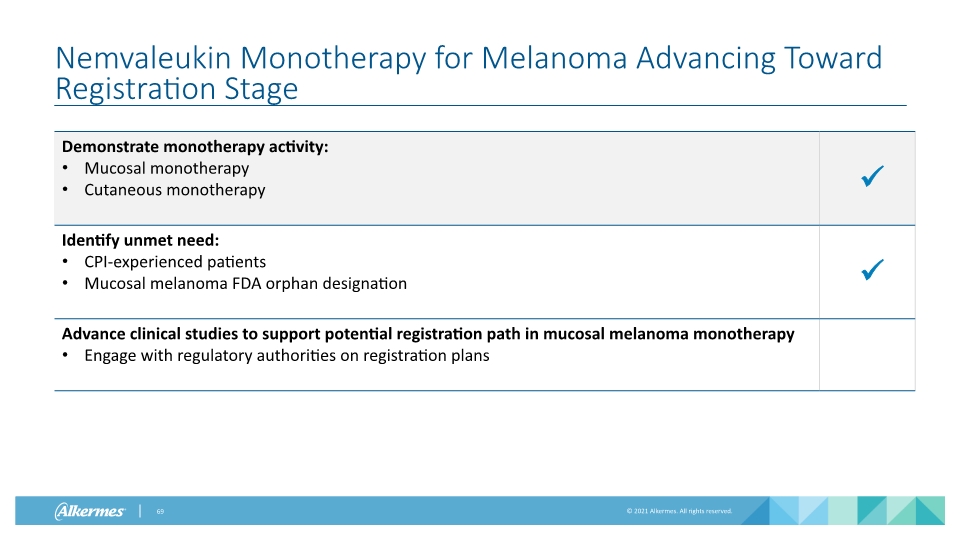
Nemvaleukin Monotherapy for Melanoma Advancing Toward Registration Stage
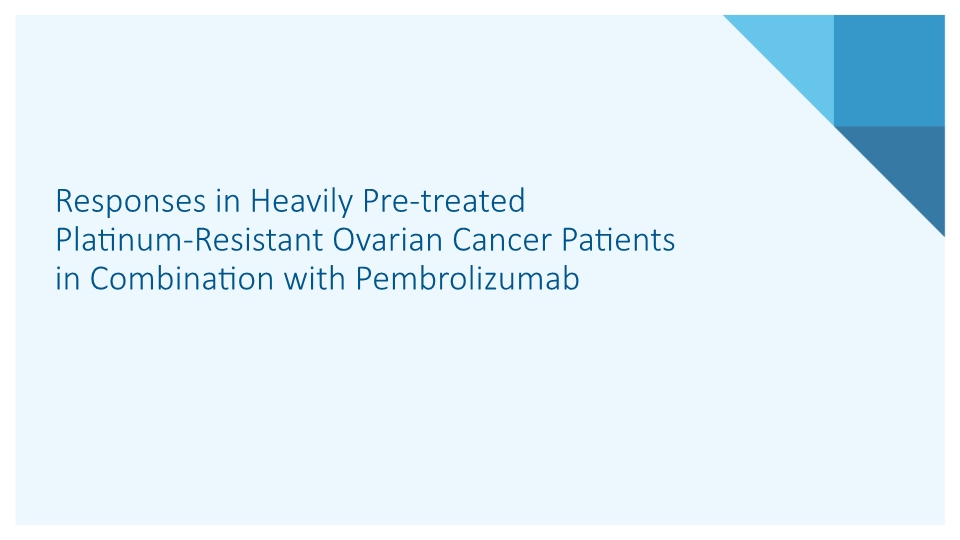
Responses in Heavily Pre-treated Platinum-Resistant Ovarian Cancer Patients in Combination with Pembrolizumab
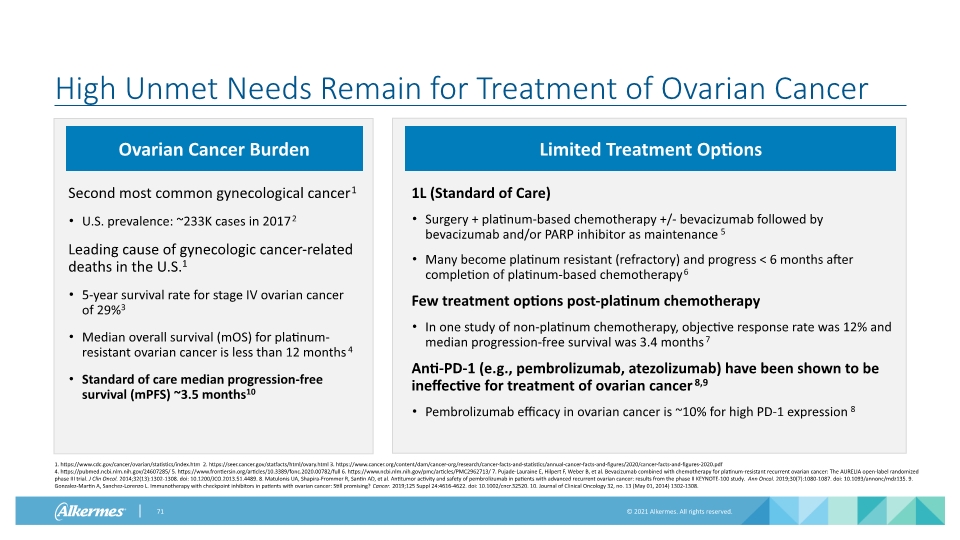
High Unmet Needs Remain for Treatment of Ovarian Cancer Second most common gynecological cancer1 U.S. prevalence: ~233K cases in 20172 Leading cause of gynecologic cancer-related deaths in the U.S.1 5-year survival rate for stage IV ovarian cancer of 29%3 Median overall survival (mOS) for platinum-resistant ovarian cancer is less than 12 months4 Standard of care median progression-free survival (mPFS) ~3.5 months10 1L (Standard of Care) Surgery + platinum-based chemotherapy +/- bevacizumab followed by bevacizumab and/or PARP inhibitor as maintenance5 Many become platinum resistant (refractory) and progress < 6 months after completion of platinum-based chemotherapy6 Few treatment options post-platinum chemotherapy In one study of non-platinum chemotherapy, objective response rate was 12% and median progression-free survival was 3.4 months7 Anti-PD-1 (e.g., pembrolizumab, atezolizumab) have been shown to be ineffective for treatment of ovarian cancer8,9 Pembrolizumab efficacy in ovarian cancer is ~10% for high PD-1 expression8 Limited Treatment Options Ovarian Cancer Burden 1. https://www.cdc.gov/cancer/ovarian/statistics/index.htm 2. https://seer.cancer.gov/statfacts/html/ovary.html 3. https://www.cancer.org/content/dam/cancer-org/research/cancer-facts-and-statistics/annual-cancer-facts-and-figures/2020/cancer-facts-and-figures-2020.pdf 4. https://pubmed.ncbi.nlm.nih.gov/24607285/ 5. https://www.frontiersin.org/articles/10.3389/fonc.2020.00782/full 6. https://www.ncbi.nlm.nih.gov/pmc/articles/PMC2962713/ 7. Pujade-Lauraine E, Hilpert F, Weber B, et al. Bevacizumab combined with chemotherapy for platinum-resistant recurrent ovarian cancer: The AURELIA open-label randomized phase III trial. J Clin Oncol. 2014;32(13):1302-1308. doi: 10.1200/JCO.2013.51.4489. 8. Matulonis UA, Shapira-Frommer R, Santin AD, et al. Antitumor activity and safety of pembrolizumab in patients with advanced recurrent ovarian cancer: results from the phase II KEYNOTE-100 study. Ann Oncol. 2019;30(7):1080-1087. doi: 10.1093/annonc/mdz135. 9. Gonzalez-Martin A, Sanchez-Lorenzo L. Immunotherapy with checkpoint inhibitors in patients with ovarian cancer: Still promising? Cancer. 2019;125 Suppl 24:4616-4622. doi: 10.1002/cncr.32520. 10. Journal of Clinical Oncology 32, no. 13 (May 01, 2014) 1302-1308.
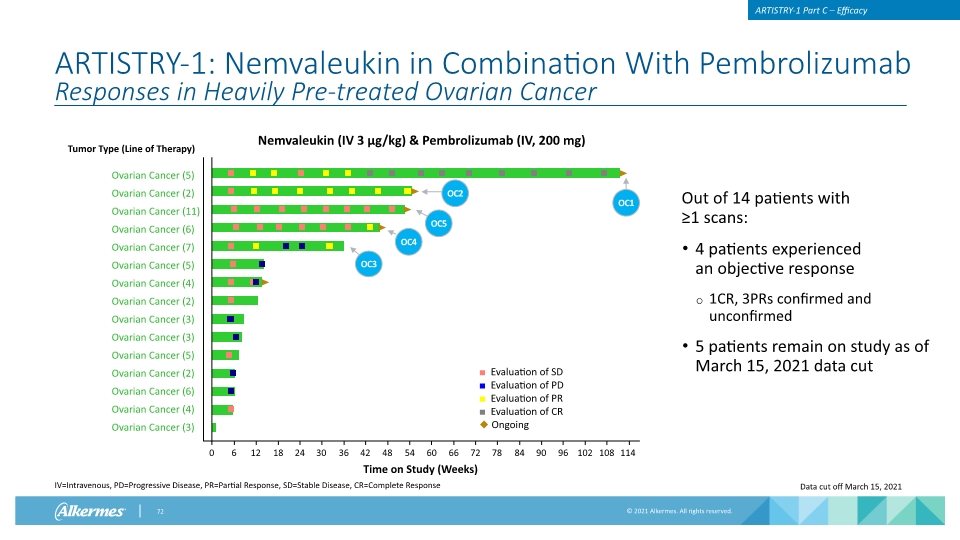
ARTISTRY-1: Nemvaleukin in Combination With Pembrolizumab Responses in Heavily Pre-treated Ovarian Cancer Out of 14 patients with ≥1 scans: 4 patients experienced an objective response 1CR, 3PRs confirmed and unconfirmed 5 patients remain on study as of March 15, 2021 data cut ARTISTRY-1 Part C – Efficacy Nemvaleukin (IV 3 µg/kg) & Pembrolizumab (IV, 200 mg) OC1 Ovarian Cancer (5) Ovarian Cancer (2) Ovarian Cancer (11) Ovarian Cancer (6) Ovarian Cancer (7) Ovarian Cancer (5) Ovarian Cancer (4) Ovarian Cancer (2) Ovarian Cancer (3) Ovarian Cancer (3) Ovarian Cancer (5) Ovarian Cancer (2) Ovarian Cancer (6) Ovarian Cancer (4) Ovarian Cancer (3) Tumor Type (Line of Therapy) 0 6 24 30 36 48 54 60 72 84 90 102 108 114 96 78 66 42 18 12 Time on Study (Weeks) ■ Evaluation of SD ■ Evaluation of PD ■ Evaluation of PR ■ Evaluation of CR Ongoing Data cut off March 15, 2021 IV=Intravenous, PD=Progressive Disease, PR=Partial Response, SD=Stable Disease, CR=Complete Response
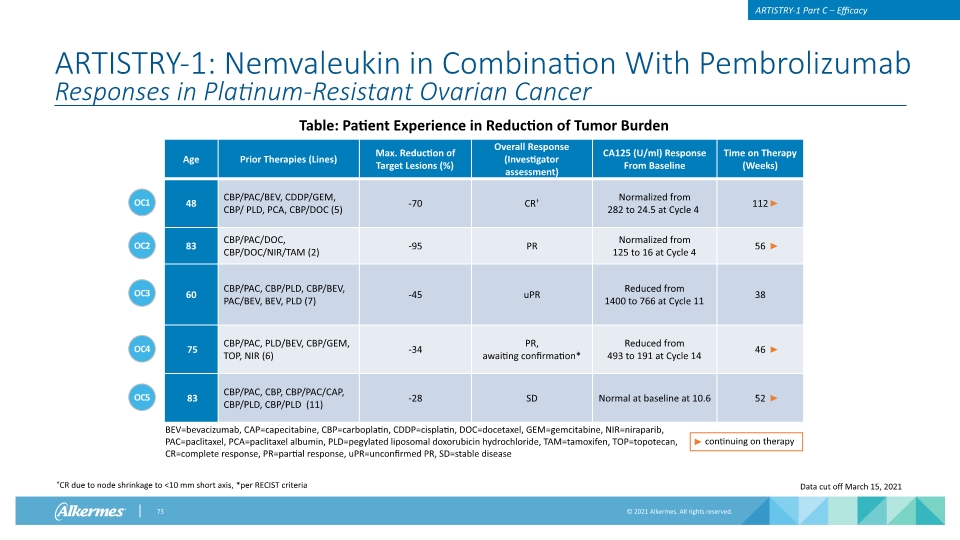
ARTISTRY-1: Nemvaleukin in Combination With Pembrolizumab Responses in Platinum-Resistant Ovarian Cancer ARTISTRY-1 Part C – Efficacy †CR due to node shrinkage to <10 mm short axis, *per RECIST criteria BEV=bevacizumab, CAP=capecitabine, CBP=carboplatin, CDDP=cisplatin, DOC=docetaxel, GEM=gemcitabine, NIR=niraparib, PAC=paclitaxel, PCA=paclitaxel albumin, PLD=pegylated liposomal doxorubicin hydrochloride, TAM=tamoxifen, TOP=topotecan, CR=complete response, PR=partial response, uPR=unconfirmed PR, SD=stable disease Table: Patient Experience in Reduction of Tumor Burden OC1 OC2 OC3 OC4 OC5 Data cut off March 15, 2021
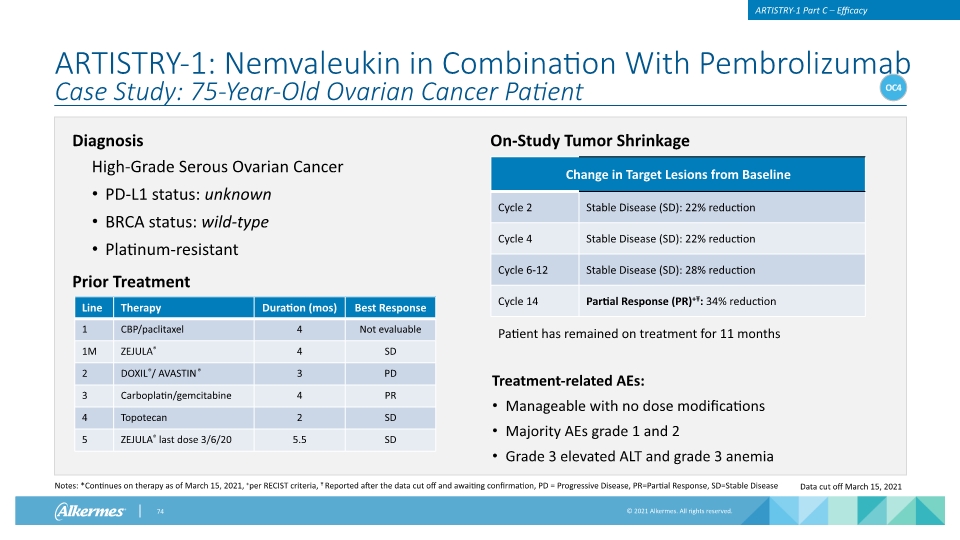
ARTISTRY-1: Nemvaleukin in Combination With Pembrolizumab Case Study: 75-Year-Old Ovarian Cancer Patient High-Grade Serous Ovarian Cancer PD-L1 status: unknown BRCA status: wild-type Platinum-resistant ARTISTRY-1 Part C – Efficacy On-Study Tumor Shrinkage OC4 Diagnosis Prior Treatment Patient has remained on treatment for 11 months Treatment-related AEs: Manageable with no dose modifications Majority AEs grade 1 and 2 Grade 3 elevated ALT and grade 3 anemia Data cut off March 15, 2021 Notes: *Continues on therapy as of March 15, 2021, +per RECIST criteria, Ŧ Reported after the data cut off and awaiting confirmation, PD = Progressive Disease, PR=Partial Response, SD=Stable Disease

Advancing Fast-to-Market Opportunity in Platinum-Resistant Ovarian Cancer (PROC) Ongoing studies designed to accumulate additional data ARTISTRY-1 Intravenous Phase 1/2 ARTISTRY-2 Subcutaneous Phase 1/2 ARTISTRY-3 Tumor Microenvironment Phase 2 ION Head and Neck Phase 2
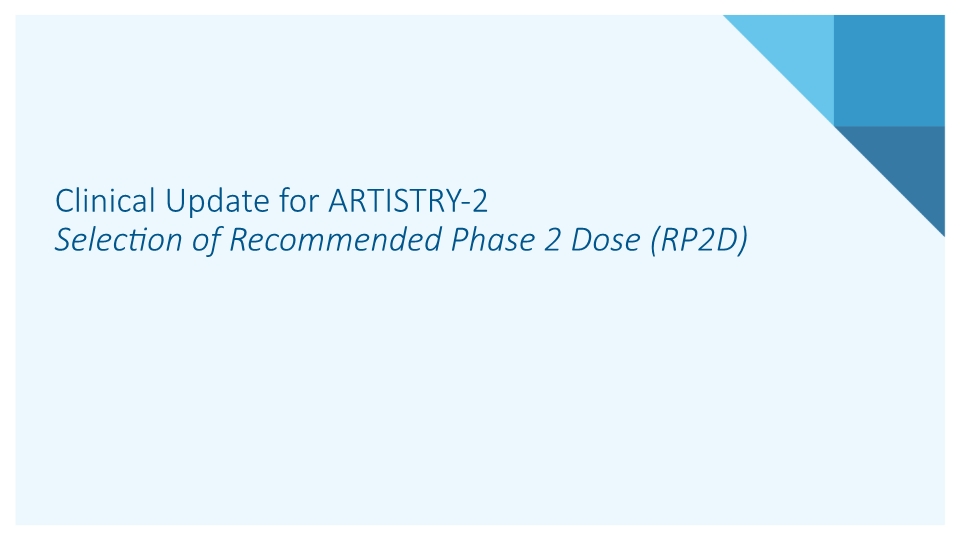
Clinical Update for ARTISTRY-2 Selection of Recommended Phase 2 Dose (RP2D)
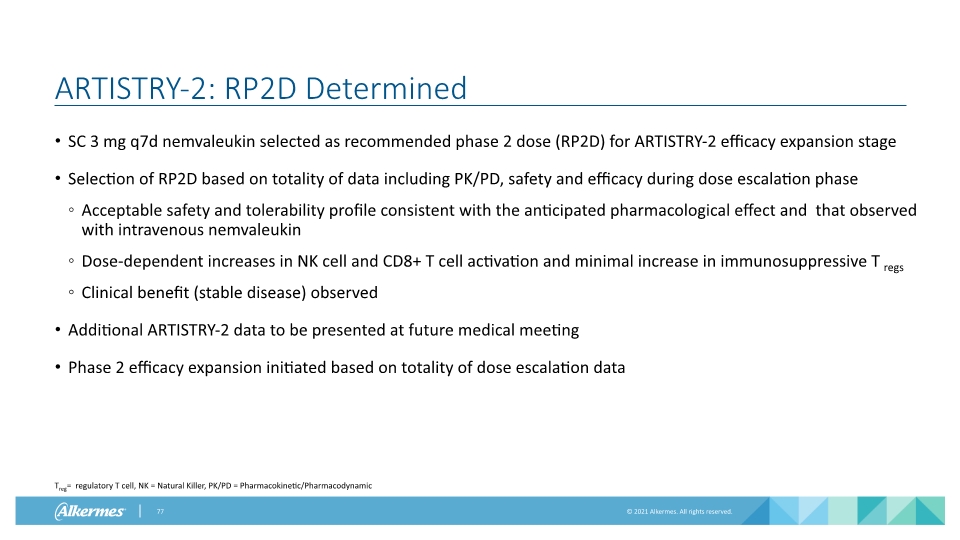
ARTISTRY-2: RP2D Determined SC 3 mg q7d nemvaleukin selected as recommended phase 2 dose (RP2D) for ARTISTRY-2 efficacy expansion stage Selection of RP2D based on totality of data including PK/PD, safety and efficacy during dose escalation phase Acceptable safety and tolerability profile consistent with the anticipated pharmacological effect and that observed with intravenous nemvaleukin Dose-dependent increases in NK cell and CD8+ T cell activation and minimal increase in immunosuppressive Tregs Clinical benefit (stable disease) observed Additional ARTISTRY-2 data to be presented at future medical meeting Phase 2 efficacy expansion initiated based on totality of dose escalation data Treg= regulatory T cell, NK = Natural Killer, PK/PD = Pharmacokinetic/Pharmacodynamic
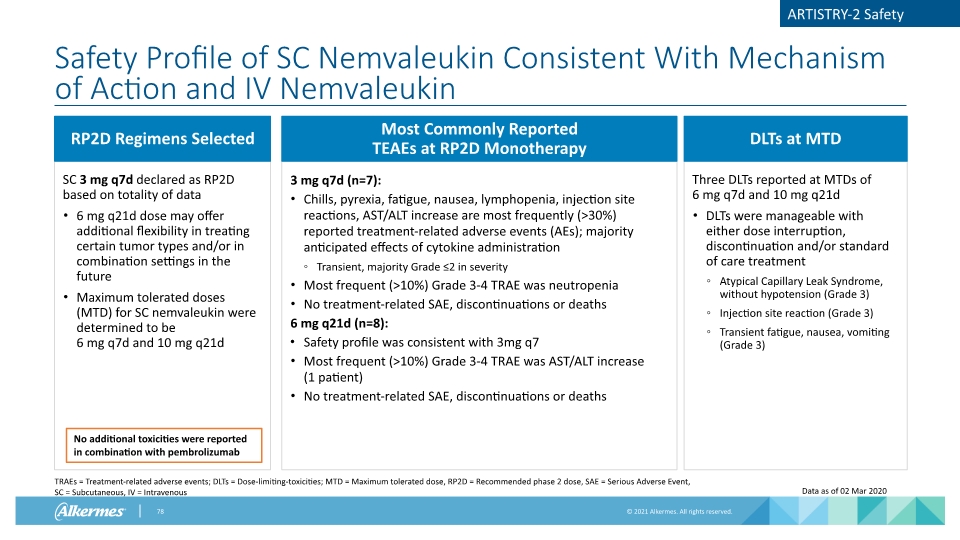
Safety Profile of SC Nemvaleukin Consistent With Mechanism of Action and IV Nemvaleukin SC 3 mg q7d declared as RP2D based on totality of data 6 mg q21d dose may offer additional flexibility in treating certain tumor types and/or in combination settings in the future Maximum tolerated doses (MTD) for SC nemvaleukin were determined to be 6 mg q7d and 10 mg q21d RP2D Regimens Selected Three DLTs reported at MTDs of 6 mg q7d and 10 mg q21d DLTs were manageable with either dose interruption, discontinuation and/or standard of care treatment Atypical Capillary Leak Syndrome, without hypotension (Grade 3) Injection site reaction (Grade 3) Transient fatigue, nausea, vomiting (Grade 3) DLTs at MTD 3 mg q7d (n=7): Chills, pyrexia, fatigue, nausea, lymphopenia, injection site reactions, AST/ALT increase are most frequently (>30%) reported treatment-related adverse events (AEs); majority anticipated effects of cytokine administration Transient, majority Grade ≤2 in severity Most frequent (>10%) Grade 3-4 TRAE was neutropenia No treatment-related SAE, discontinuations or deaths 6 mg q21d (n=8): Safety profile was consistent with 3mg q7 Most frequent (>10%) Grade 3-4 TRAE was AST/ALT increase (1 patient) No treatment-related SAE, discontinuations or deaths Most Commonly Reported TEAEs at RP2D Monotherapy TRAEs = Treatment-related adverse events; DLTs = Dose-limiting-toxicities; MTD = Maximum tolerated dose, RP2D = Recommended phase 2 dose, SAE = Serious Adverse Event, SC = Subcutaneous, IV = Intravenous No additional toxicities were reported in combination with pembrolizumab ARTISTRY-2 Safety Data as of 02 Mar 2020
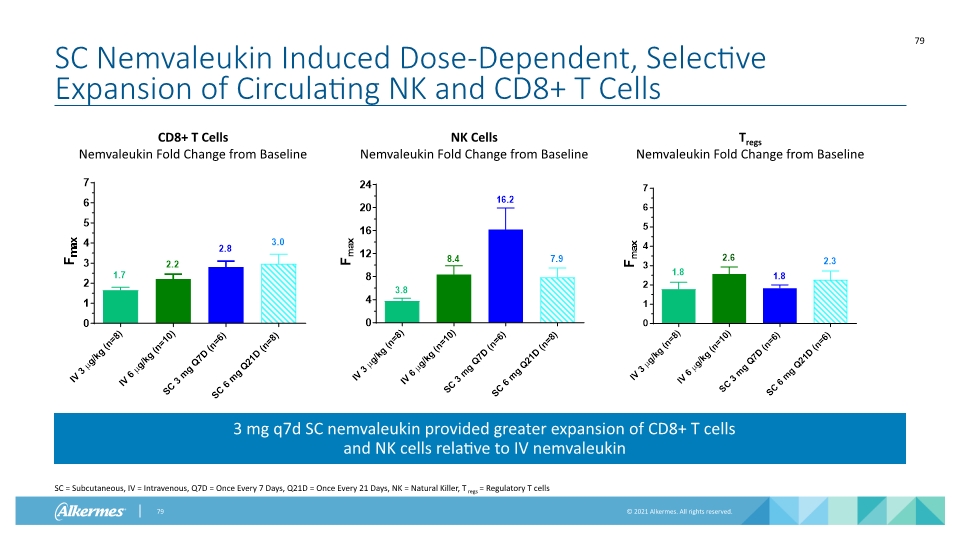
SC Nemvaleukin Induced Dose-Dependent, Selective Expansion of Circulating NK and CD8+ T Cells 3 mg q7d SC nemvaleukin provided greater expansion of CD8+ T cells and NK cells relative to IV nemvaleukin CD8+ T Cells Nemvaleukin Fold Change from Baseline NK Cells Nemvaleukin Fold Change from Baseline Tregs Nemvaleukin Fold Change from Baseline SC = Subcutaneous, IV = Intravenous, Q7D = Once Every 7 Days, Q21D = Once Every 21 Days, NK = Natural Killer, Tregs = Regulatory T cells 79
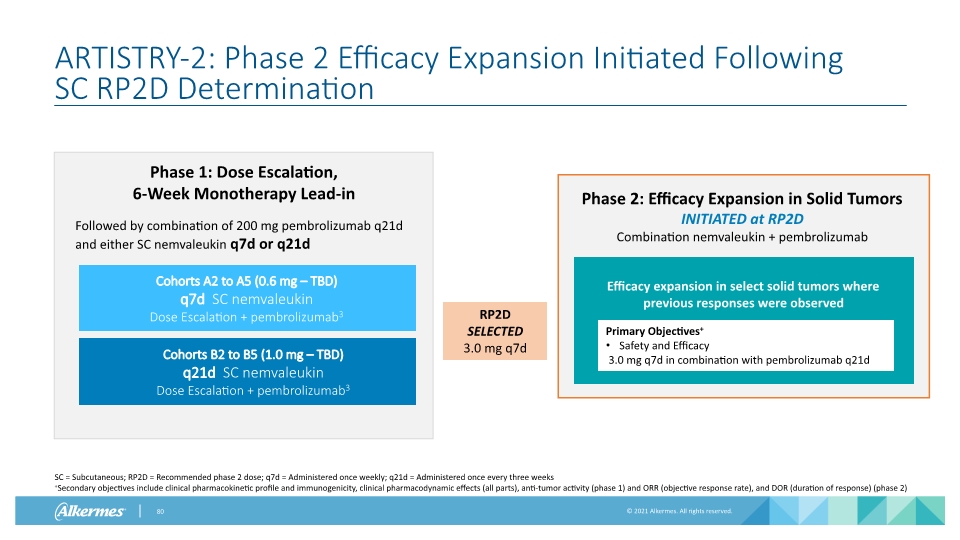
ARTISTRY-2: Phase 2 Efficacy Expansion Initiated Following SC RP2D Determination Phase 2: Efficacy Expansion in Solid Tumors INITIATED at RP2D Combination nemvaleukin + pembrolizumab Efficacy expansion in select solid tumors where previous responses were observed Phase 1: Dose Escalation, 6-Week Monotherapy Lead-in RP2D SELECTED 3.0 mg q7d Primary Objectives+ Safety and Efficacy 3.0 mg q7d in combination with pembrolizumab q21d Followed by combination of 200 mg pembrolizumab q21d and either SC nemvaleukin q7d or q21d SC = Subcutaneous; RP2D = Recommended phase 2 dose; q7d = Administered once weekly; q21d = Administered once every three weeks +Secondary objectives include clinical pharmacokinetic profile and immunogenicity, clinical pharmacodynamic effects (all parts), anti-tumor activity (phase 1) and ORR (objective response rate), and DOR (duration of response) (phase 2) Cohorts A2 to A5 (0.6 mg – TBD) q7d SC nemvaleukin Dose Escalation + pembrolizumab3 Cohorts B2 to B5 (1.0 mg – TBD) q21d SC nemvaleukin Dose Escalation + pembrolizumab3
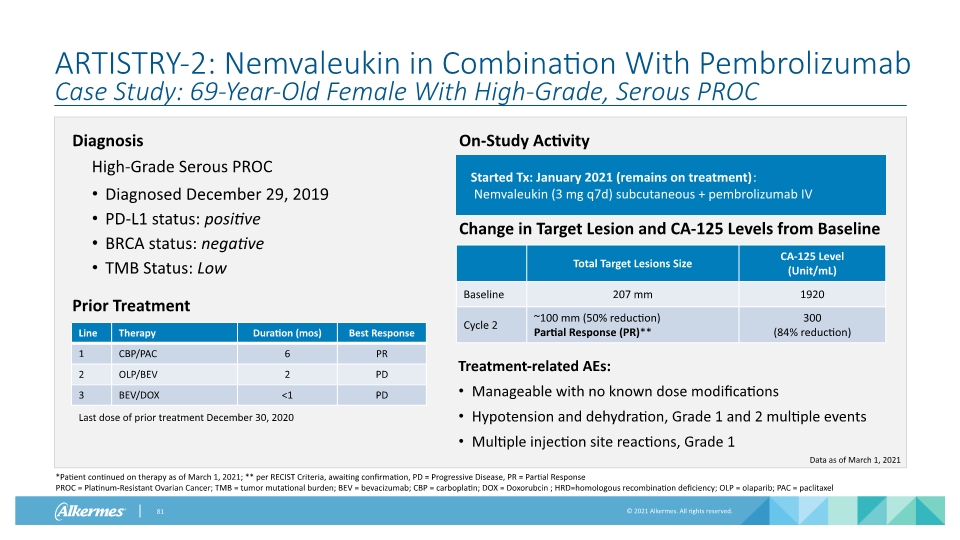
ARTISTRY-2: Nemvaleukin in Combination With Pembrolizumab Case Study: 69-Year-Old Female With High-Grade, Serous PROC Started Tx: January 2021 (remains on treatment): Nemvaleukin (3 mg q7d) subcutaneous + pembrolizumab IV Data as of March 1, 2021 *Patient continued on therapy as of March 1, 2021; ** per RECIST Criteria, awaiting confirmation, PD = Progressive Disease, PR = Partial Response PROC = Platinum-Resistant Ovarian Cancer; TMB = tumor mutational burden; BEV = bevacizumab; CBP = carboplatin; DOX = Doxorubcin ; HRD=homologous recombination deficiency; OLP = olaparib; PAC = paclitaxel Last dose of prior treatment December 30, 2020 On-Study Activity Diagnosis Prior Treatment High-Grade Serous PROC Diagnosed December 29, 2019 PD-L1 status: positive BRCA status: negative TMB Status: Low Change in Target Lesion and CA-125 Levels from Baseline Treatment-related AEs: Manageable with no known dose modifications Hypotension and dehydration, Grade 1 and 2 multiple events Multiple injection site reactions, Grade 1
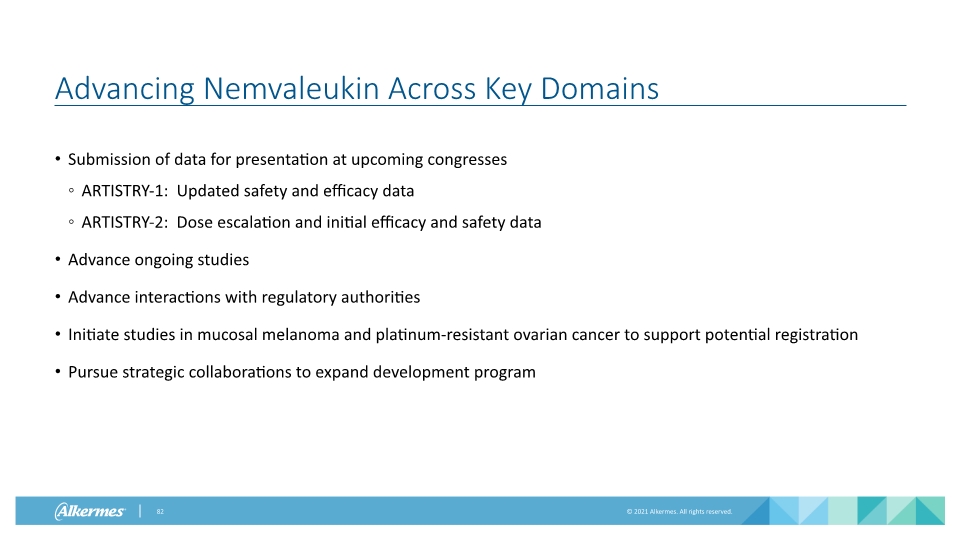
Advancing Nemvaleukin Across Key Domains Submission of data for presentation at upcoming congresses ARTISTRY-1: Updated safety and efficacy data ARTISTRY-2: Dose escalation and initial efficacy and safety data Advance ongoing studies Advance interactions with regulatory authorities Initiate studies in mucosal melanoma and platinum-resistant ovarian cancer to support potential registration Pursue strategic collaborations to expand development program
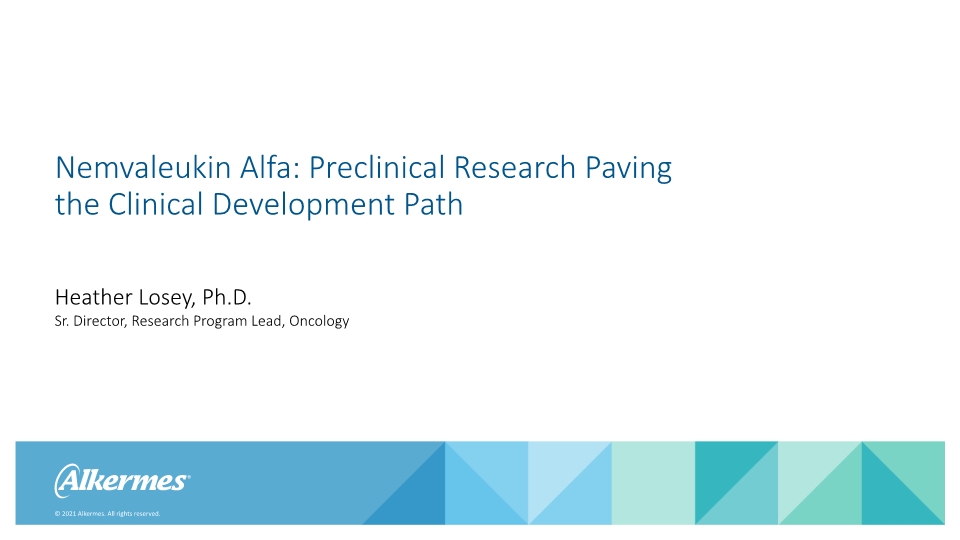
Heather Losey, Ph.D. Nemvaleukin Alfa: Preclinical Research Paving the Clinical Development Path Sr. Director, Research Program Lead, Oncology
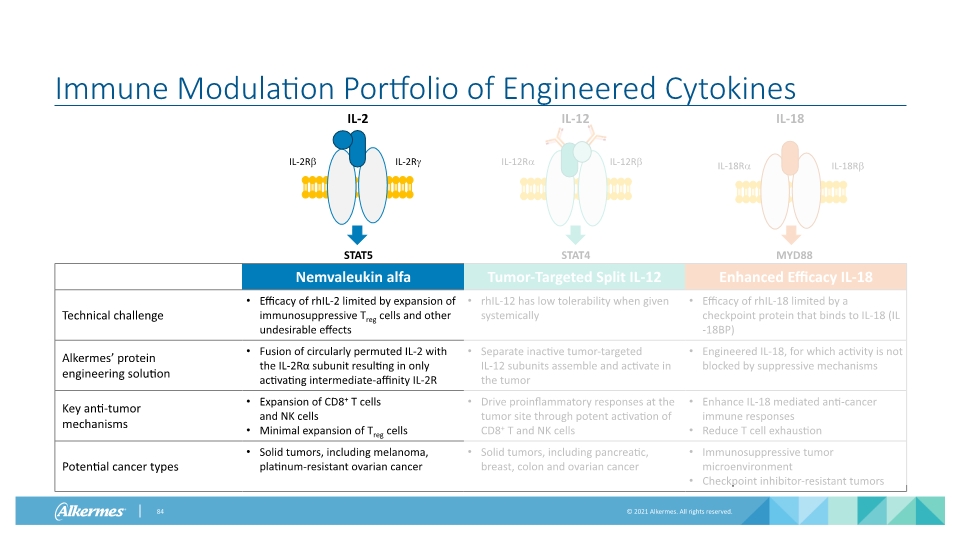
Immune Modulation Portfolio of Engineered Cytokines IL-18R IL-18R MYD88 IL-2Rg IL-2R STAT5 IL-12R IL-12R STAT4 IL-18 IL-2 IL-12
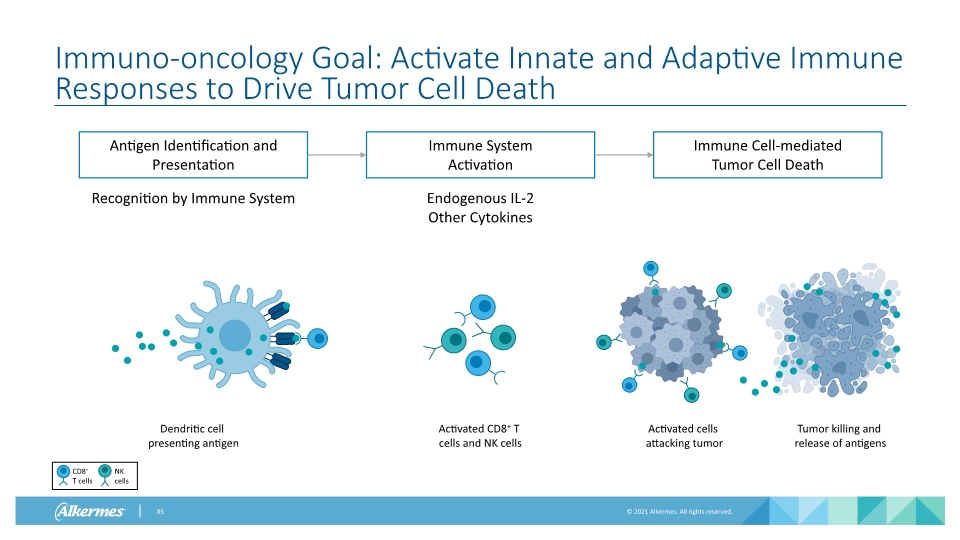
Antigen Identification and Presentation Immune System Activation Immune Cell-mediated Tumor Cell Death Endogenous IL-2 Other Cytokines Recognition by Immune System Immuno-oncology Goal: Activate Innate and Adaptive Immune Responses to Drive Tumor Cell Death Dendritic cell presenting antigen Activated CD8+ T cells and NK cells Activated cells attacking tumor Tumor killing and release of antigens
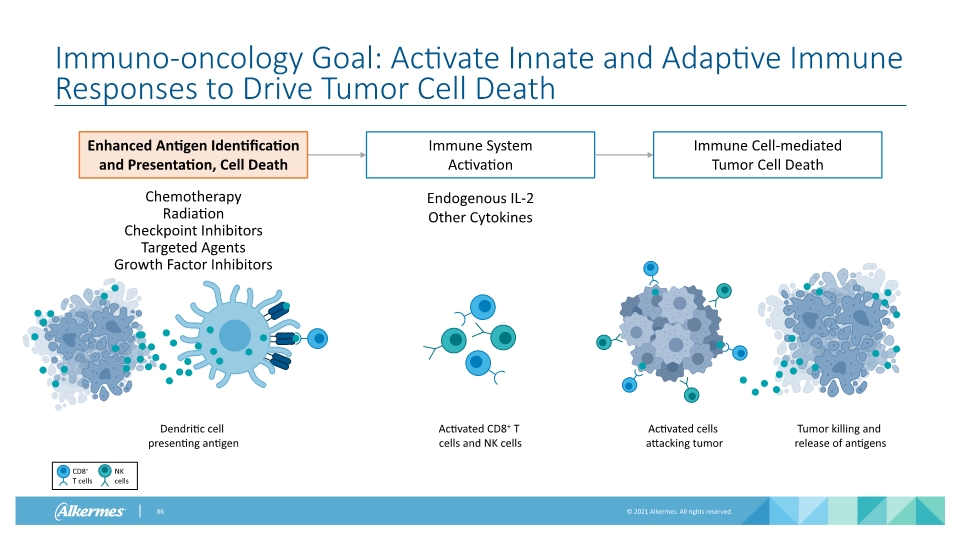
Immuno-oncology Goal: Activate Innate and Adaptive Immune Responses to Drive Tumor Cell Death Enhanced Antigen Identification and Presentation, Cell Death Immune System Activation Immune Cell-mediated Tumor Cell Death Endogenous IL-2 Other Cytokines Chemotherapy Radiation Checkpoint Inhibitors Targeted Agents Growth Factor Inhibitors Dendritic cell presenting antigen Activated CD8+ T cells and NK cells Activated cells attacking tumor Tumor killing and release of antigens
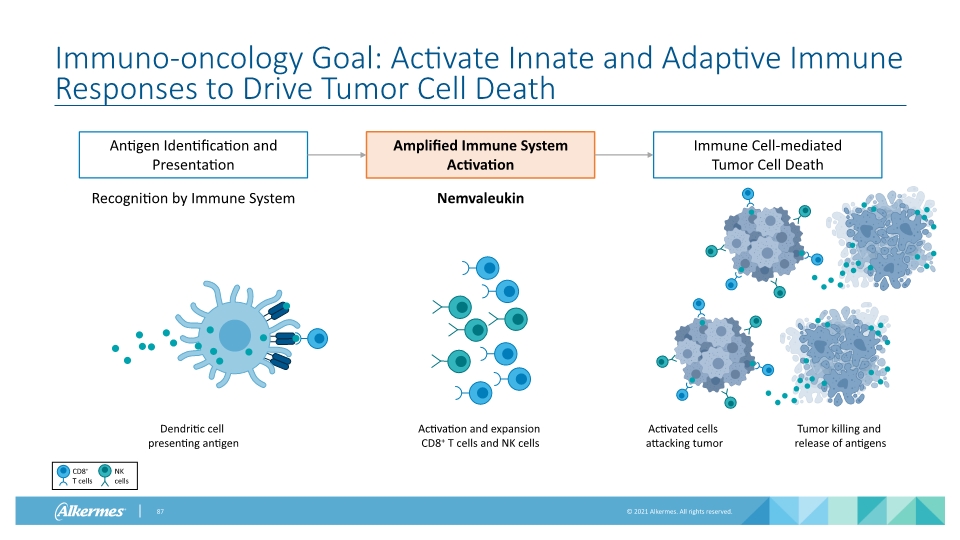
Immuno-oncology Goal: Activate Innate and Adaptive Immune Responses to Drive Tumor Cell Death Antigen Identification and Presentation Amplified Immune System Activation Immune Cell-mediated Tumor Cell Death Nemvaleukin Recognition by Immune System Dendritic cell presenting antigen Activation and expansion CD8+ T cells and NK cells Activated cells attacking tumor Tumor killing and release of antigens
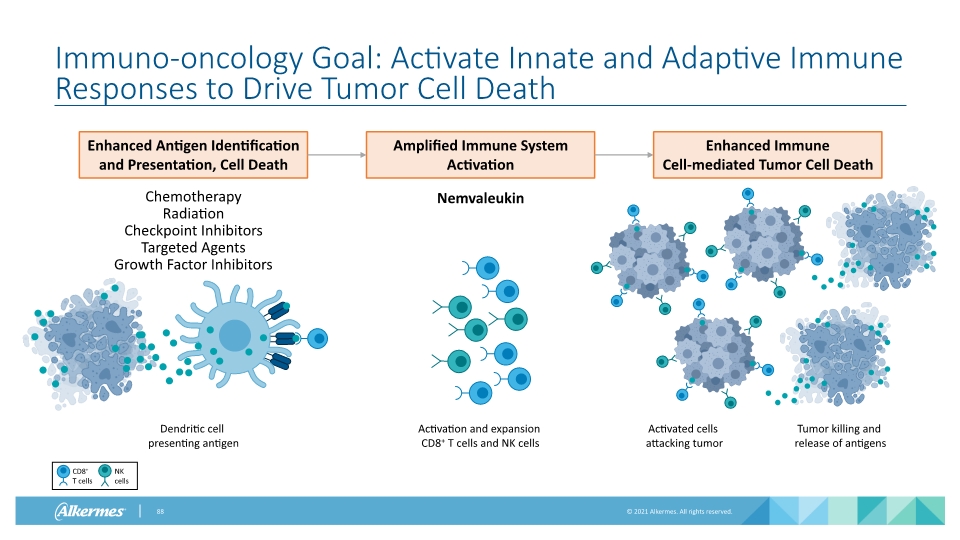
Immuno-oncology Goal: Activate Innate and Adaptive Immune Responses to Drive Tumor Cell Death Enhanced Antigen Identification and Presentation, Cell Death Amplified Immune System Activation Enhanced Immune Cell-mediated Tumor Cell Death Chemotherapy Radiation Checkpoint Inhibitors Targeted Agents Growth Factor Inhibitors Nemvaleukin Dendritic cell presenting antigen Activation and expansion CD8+ T cells and NK cells Activated cells attacking tumor Tumor killing and release of antigens
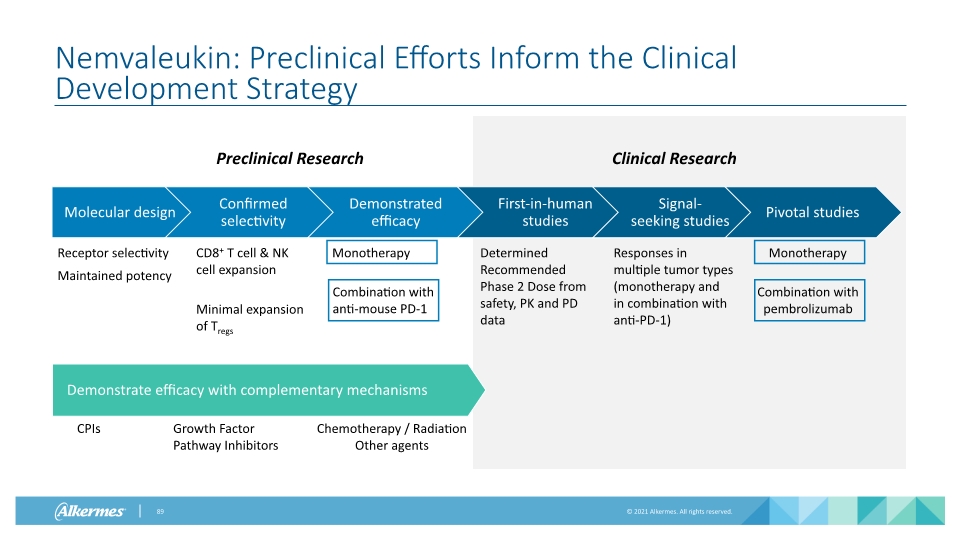
Nemvaleukin: Preclinical Efforts Inform the Clinical Development Strategy Receptor selectivity Maintained potency CD8+ T cell & NK cell expansion Minimal expansion of Tregs Responses in multiple tumor types (monotherapy and in combination with anti-PD-1) Preclinical Research Monotherapy Combination with pembrolizumab Monotherapy Combination with anti-mouse PD-1 Determined Recommended Phase 2 Dose from safety, PK and PD data Clinical Research Demonstrate efficacy with complementary mechanisms Growth Factor Pathway Inhibitors CPIs Chemotherapy / Radiation Other agents
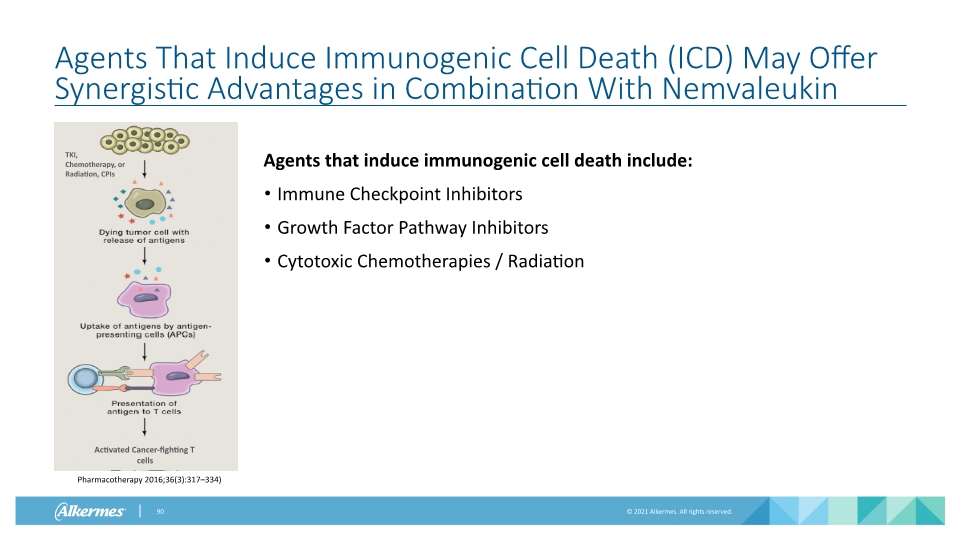
Agents That Induce Immunogenic Cell Death (ICD) May Offer Synergistic Advantages in Combination With Nemvaleukin Agents that induce immunogenic cell death include: Immune Checkpoint Inhibitors Growth Factor Pathway Inhibitors Cytotoxic Chemotherapies / Radiation
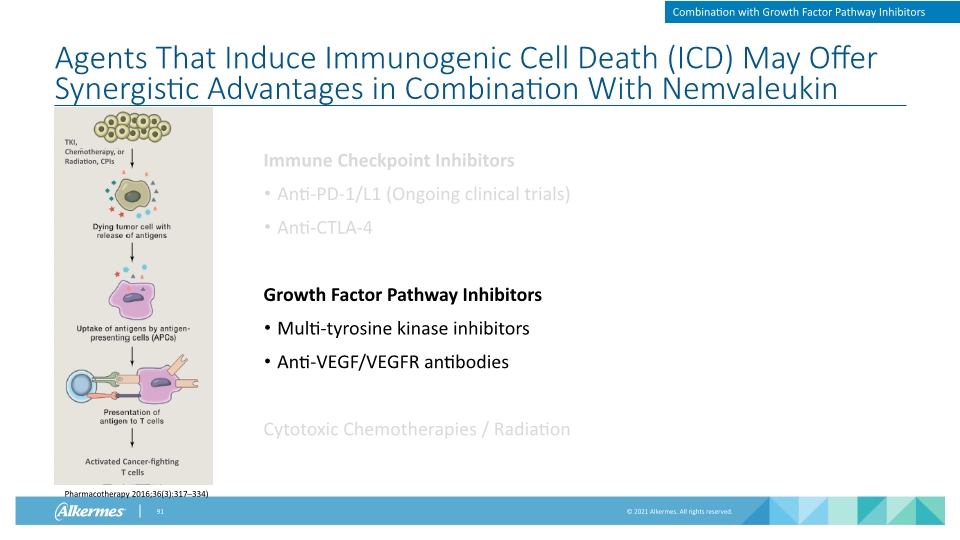
Agents That Induce Immunogenic Cell Death (ICD) May Offer Synergistic Advantages in Combination With Nemvaleukin Immune Checkpoint Inhibitors Anti-PD-1/L1 (Ongoing clinical trials) Anti-CTLA-4 Growth Factor Pathway Inhibitors Multi-tyrosine kinase inhibitors Anti-VEGF/VEGFR antibodies Cytotoxic Chemotherapies / Radiation Combination with Growth Factor Pathway Inhibitors
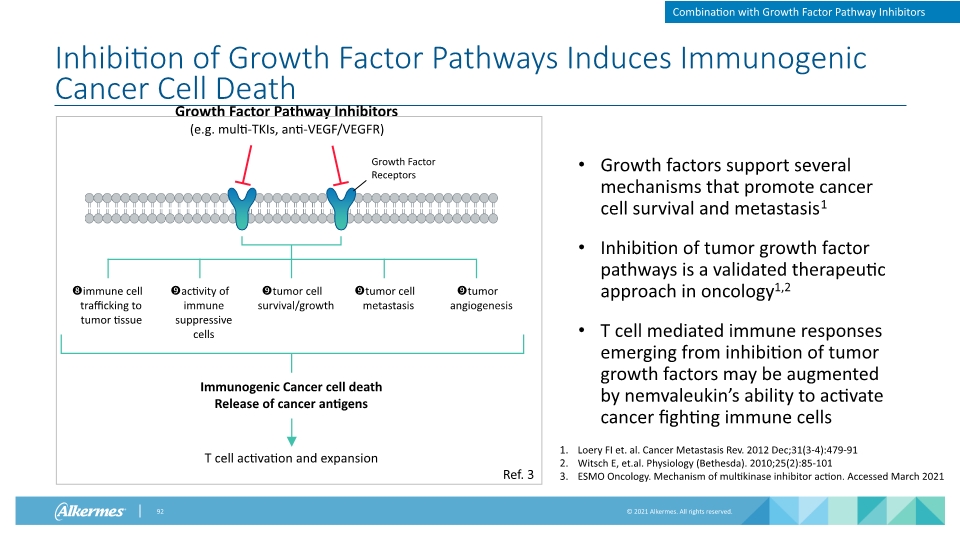
Inhibition of Growth Factor Pathways Induces Immunogenic Cancer Cell Death Growth factors support several mechanisms that promote cancer cell survival and metastasis1 Inhibition of tumor growth factor pathways is a validated therapeutic approach in oncology1,2 T cell mediated immune responses emerging from inhibition of tumor growth factors may be augmented by nemvaleukin’s ability to activate cancer fighting immune cells Combination with Growth Factor Pathway Inhibitors Loery FI et. al. Cancer Metastasis Rev. 2012 Dec;31(3-4):479-91 Witsch E, et.al. Physiology (Bethesda). 2010;25(2):85-101 ESMO Oncology. Mechanism of multikinase inhibitor action. Accessed March 2021 Ref. 3
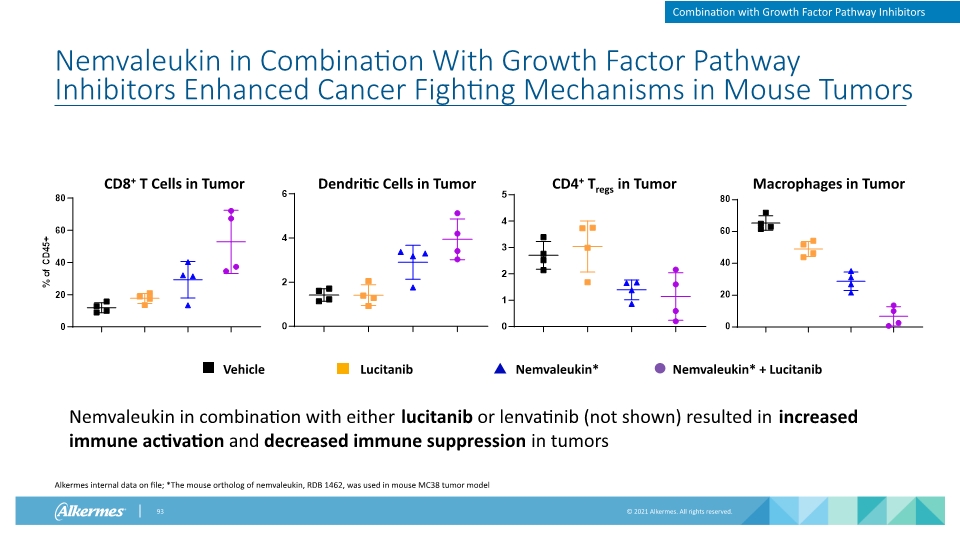
Nemvaleukin in Combination With Growth Factor Pathway Inhibitors Enhanced Cancer Fighting Mechanisms in Mouse Tumors Alkermes internal data on file; *The mouse ortholog of nemvaleukin, RDB 1462, was used in mouse MC38 tumor model Combination with Growth Factor Pathway Inhibitors Nemvaleukin in combination with either lucitanib or lenvatinib (not shown) resulted in increased immune activation and decreased immune suppression in tumors
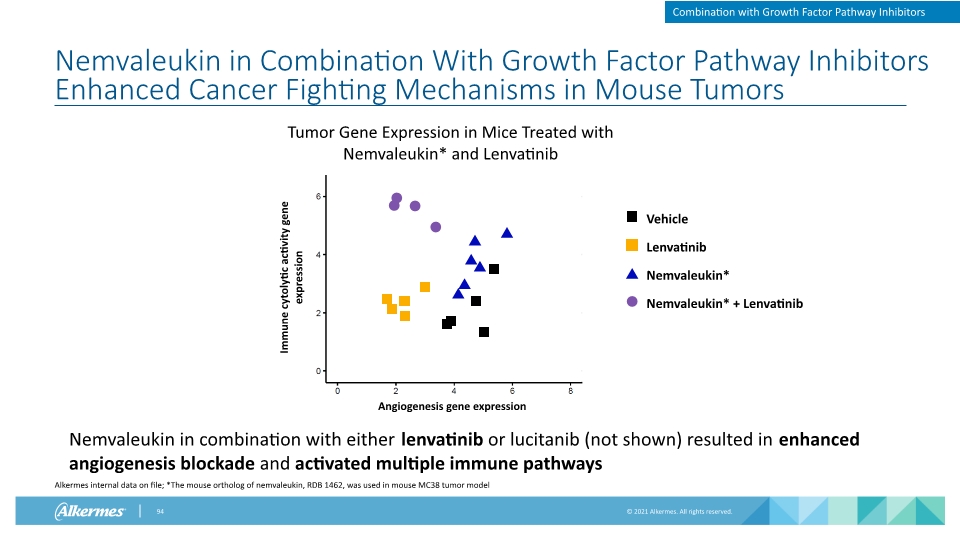
Nemvaleukin in Combination With Growth Factor Pathway Inhibitors Enhanced Cancer Fighting Mechanisms in Mouse Tumors Combination with Growth Factor Pathway Inhibitors Angiogenesis gene expression Immune cytolytic activity gene expression Tumor Gene Expression in Mice Treated with Nemvaleukin* and Lenvatinib Nemvaleukin in combination with either lenvatinib or lucitanib (not shown) resulted in enhanced angiogenesis blockade and activated multiple immune pathways Alkermes internal data on file; *The mouse ortholog of nemvaleukin, RDB 1462, was used in mouse MC38 tumor model
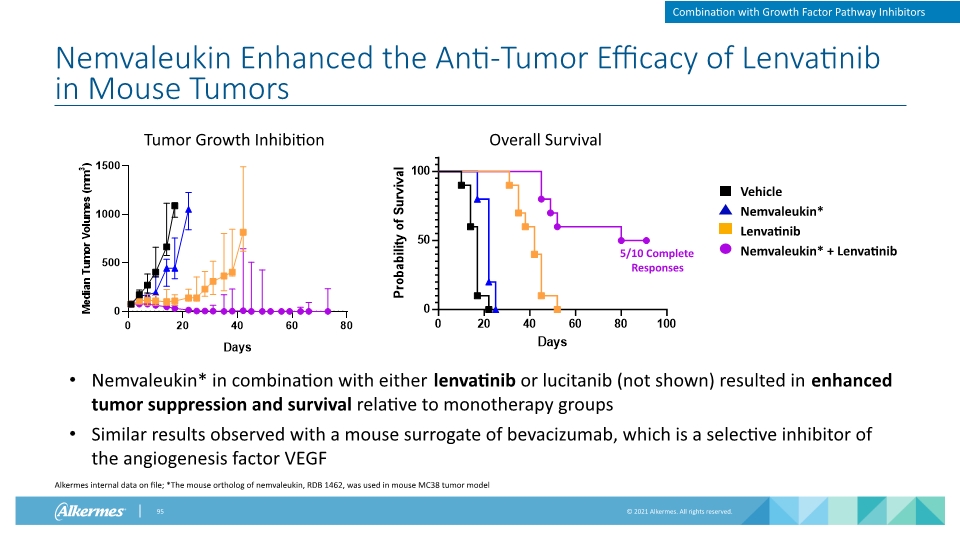
Nemvaleukin Enhanced the Anti-Tumor Efficacy of Lenvatinib in Mouse Tumors Combination with Growth Factor Pathway Inhibitors Nemvaleukin* in combination with either lenvatinib or lucitanib (not shown) resulted in enhanced tumor suppression and survival relative to monotherapy groups Similar results observed with a mouse surrogate of bevacizumab, which is a selective inhibitor of the angiogenesis factor VEGF 5/10 Complete Responses Tumor Growth Inhibition Overall Survival Alkermes internal data on file; *The mouse ortholog of nemvaleukin, RDB 1462, was used in mouse MC38 tumor model
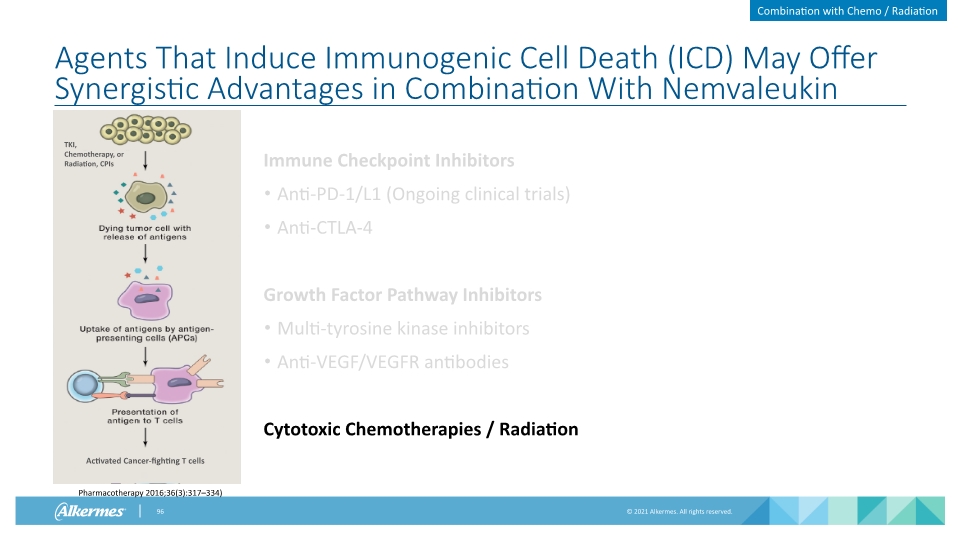
Agents That Induce Immunogenic Cell Death (ICD) May Offer Synergistic Advantages in Combination With Nemvaleukin Immune Checkpoint Inhibitors Anti-PD-1/L1 (Ongoing clinical trials) Anti-CTLA-4 Growth Factor Pathway Inhibitors Multi-tyrosine kinase inhibitors Anti-VEGF/VEGFR antibodies Cytotoxic Chemotherapies / Radiation Combination with Chemo / Radiation
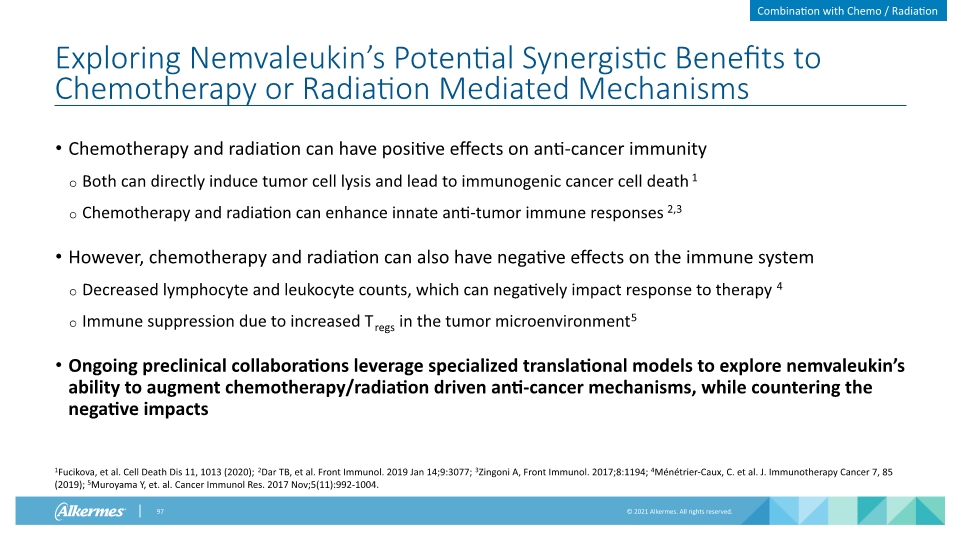
Exploring Nemvaleukin’s Potential Synergistic Benefits to Chemotherapy or Radiation Mediated Mechanisms Chemotherapy and radiation can have positive effects on anti-cancer immunity Both can directly induce tumor cell lysis and lead to immunogenic cancer cell death1 Chemotherapy and radiation can enhance innate anti-tumor immune responses2,3 However, chemotherapy and radiation can also have negative effects on the immune system Decreased lymphocyte and leukocyte counts, which can negatively impact response to therapy4 Immune suppression due to increased Tregs in the tumor microenvironment5 Ongoing preclinical collaborations leverage specialized translational models to explore nemvaleukin’s ability to augment chemotherapy/radiation driven anti-cancer mechanisms, while countering the negative impacts Combination with Chemo / Radiation 1Fucikova, et al. Cell Death Dis 11, 1013 (2020); 2Dar TB, et al. Front Immunol. 2019 Jan 14;9:3077; 3Zingoni A, Front Immunol. 2017;8:1194; 4Ménétrier-Caux, C. et al. J. Immunotherapy Cancer 7, 85 (2019); 5Muroyama Y, et. al. Cancer Immunol Res. 2017 Nov;5(11):992-1004.
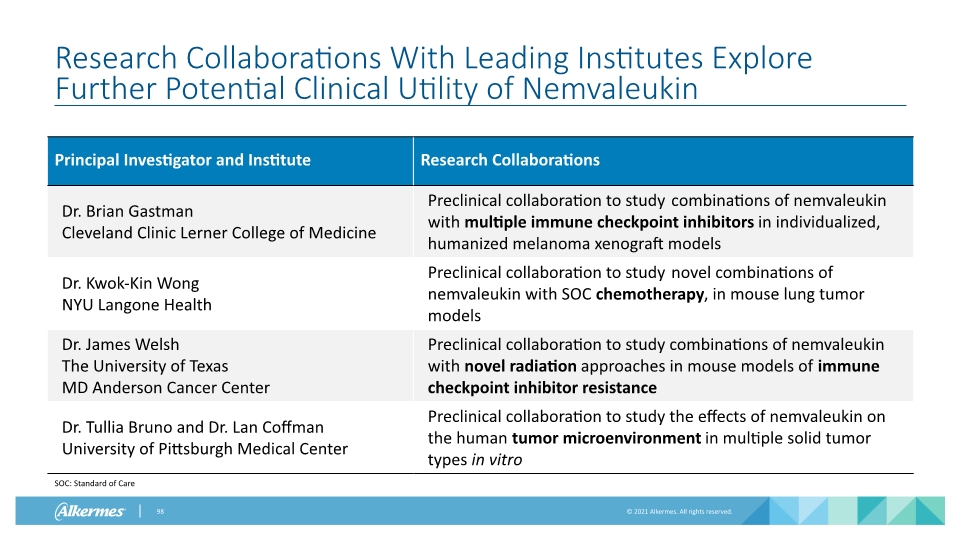
Research Collaborations With Leading Institutes Explore Further Potential Clinical Utility of Nemvaleukin SOC: Standard of Care
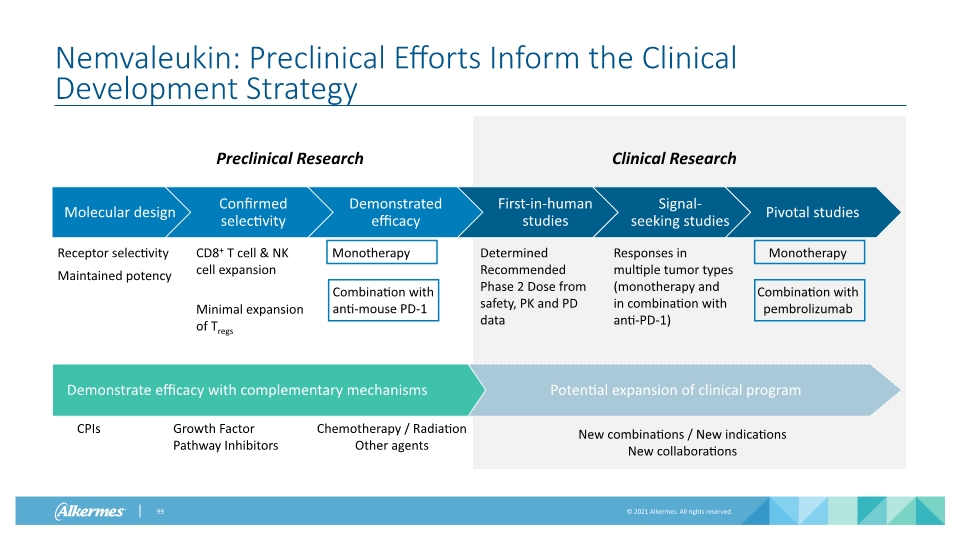
Nemvaleukin: Preclinical Efforts Inform the Clinical Development Strategy Receptor selectivity Maintained potency CD8+ T cell & NK cell expansion Minimal expansion of Tregs Responses in multiple tumor types (monotherapy and in combination with anti-PD-1) Preclinical Research Monotherapy Combination with pembrolizumab Monotherapy Combination with anti-mouse PD-1 Determined Recommended Phase 2 Dose from safety, PK and PD data Clinical Research New combinations / New indications New collaborations Growth Factor Pathway Inhibitors CPIs Chemotherapy / Radiation Other agents
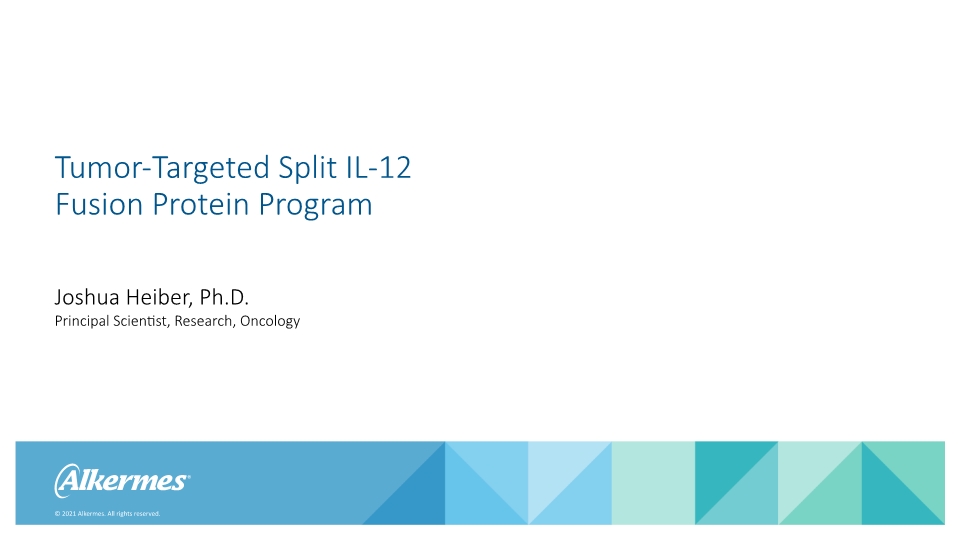
Joshua Heiber, Ph.D. Tumor-Targeted Split IL-12 Fusion Protein Program Principal Scientist, Research, Oncology
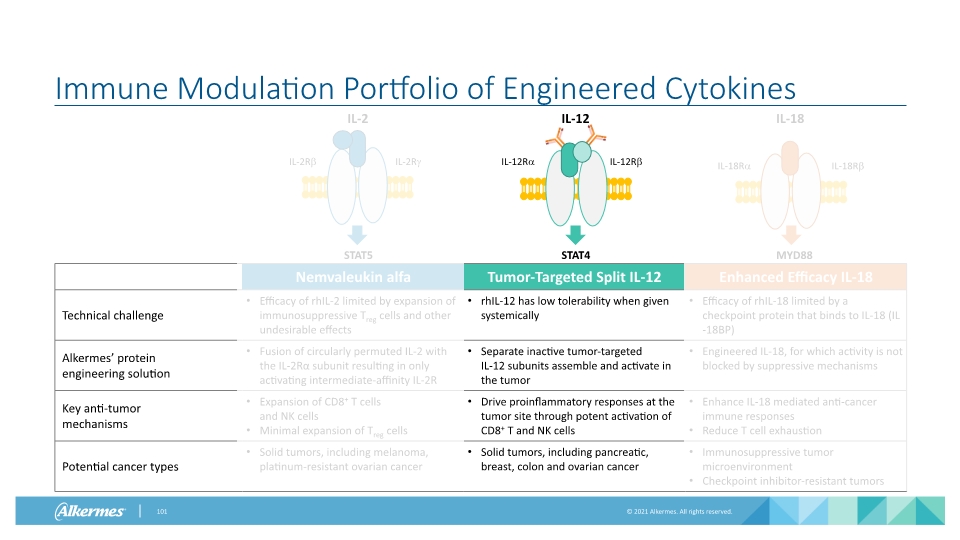
Immune Modulation Portfolio of Engineered Cytokines IL-18R IL-18R MYD88 IL-2Rg IL-2R STAT5 IL-12R IL-12R STAT4 IL-18 IL-2 IL-12
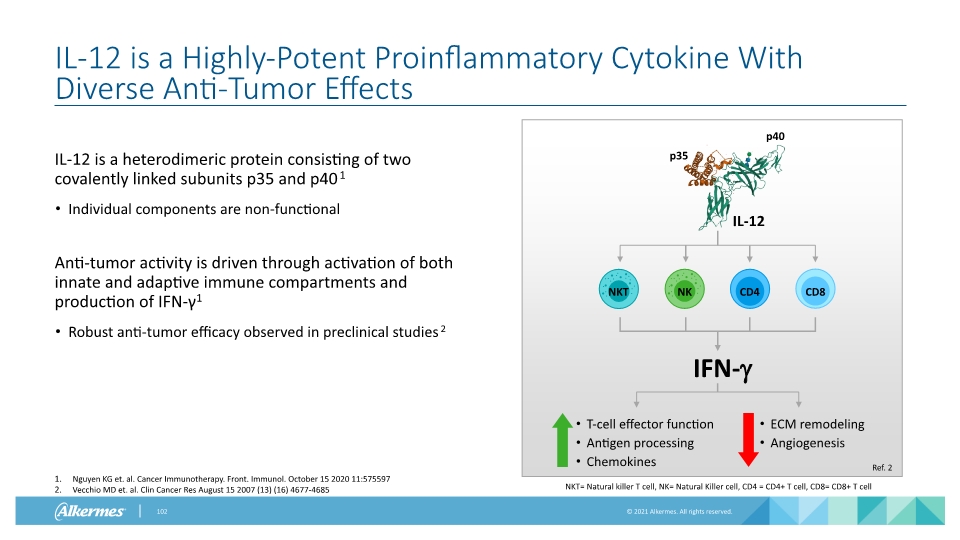
IL-12 is a Highly-Potent Proinflammatory Cytokine With Diverse Anti-Tumor Effects IL-12 is a heterodimeric protein consisting of two covalently linked subunits p35 and p401 Individual components are non-functional Anti-tumor activity is driven through activation of both innate and adaptive immune compartments and production of IFN-γ1 Robust anti-tumor efficacy observed in preclinical studies2 Nguyen KG et. al. Cancer Immunotherapy. Front. Immunol. October 15 2020 11:575597 Vecchio MD et. al. Clin Cancer Res August 15 2007 (13) (16) 4677-4685 Ref. 2 NKT= Natural killer T cell, NK= Natural Killer cell, CD4 = CD4+ T cell, CD8= CD8+ T cell
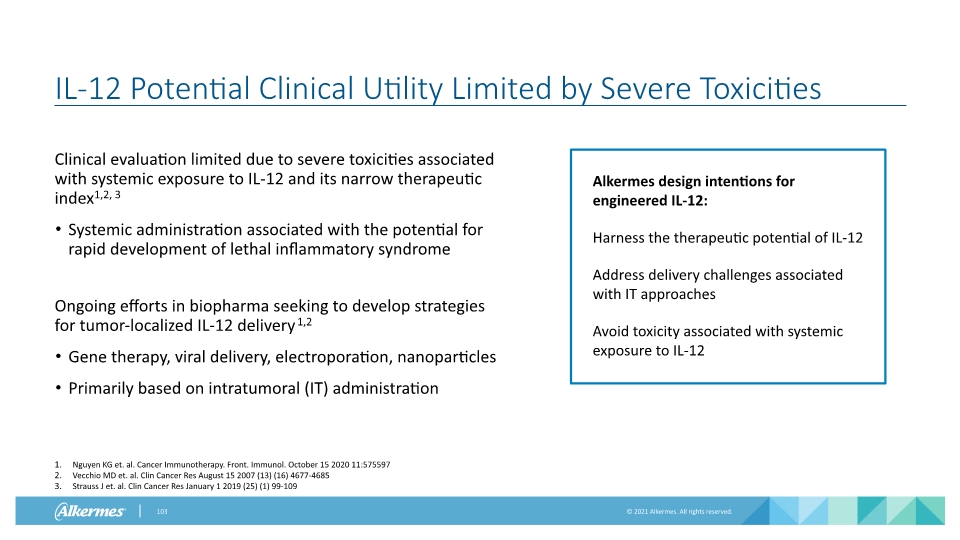
IL-12 Potential Clinical Utility Limited by Severe Toxicities Clinical evaluation limited due to severe toxicities associated with systemic exposure to IL-12 and its narrow therapeutic index1,2, 3 Systemic administration associated with the potential for rapid development of lethal inflammatory syndrome Ongoing efforts in biopharma seeking to develop strategies for tumor-localized IL-12 delivery1,2 Gene therapy, viral delivery, electroporation, nanoparticles Primarily based on intratumoral (IT) administration Alkermes design intentions for engineered IL-12: Harness the therapeutic potential of IL-12 Address delivery challenges associated with IT approaches Avoid toxicity associated with systemic exposure to IL-12 Nguyen KG et. al. Cancer Immunotherapy. Front. Immunol. October 15 2020 11:575597 Vecchio MD et. al. Clin Cancer Res August 15 2007 (13) (16) 4677-4685 Strauss J et. al. Clin Cancer Res January 1 2019 (25) (1) 99-109
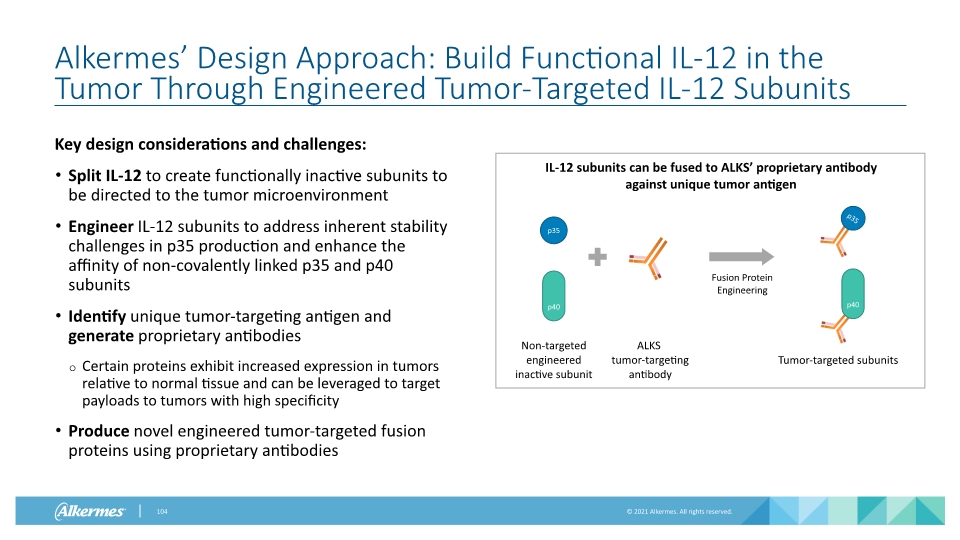
Alkermes’ Design Approach: Build Functional IL-12 in the Tumor Through Engineered Tumor-Targeted IL-12 Subunits Key design considerations and challenges: Split IL-12 to create functionally inactive subunits to be directed to the tumor microenvironment Engineer IL-12 subunits to address inherent stability challenges in p35 production and enhance the affinity of non-covalently linked p35 and p40 subunits Identify unique tumor-targeting antigen and generate proprietary antibodies Certain proteins exhibit increased expression in tumors relative to normal tissue and can be leveraged to target payloads to tumors with high specificity Produce novel engineered tumor-targeted fusion proteins using proprietary antibodies Non-targeted engineered inactive subunit Tumor-targeted subunits ALKS tumor-targeting antibody Fusion Protein Engineering IL-12 subunits can be fused to ALKS’ proprietary antibody against unique tumor antigen p35 p40
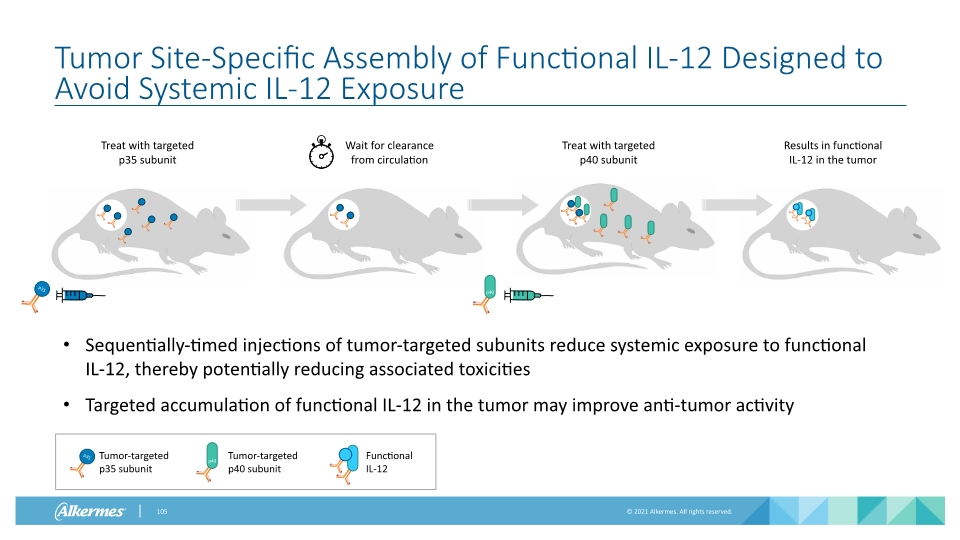
Tumor Site-Specific Assembly of Functional IL-12 Designed to Avoid Systemic IL-12 Exposure Tumor-targeted p35 subunit Tumor-targeted p40 subunit Functional IL-12 Sequentially-timed injections of tumor-targeted subunits reduce systemic exposure to functional IL-12, thereby potentially reducing associated toxicities Targeted accumulation of functional IL-12 in the tumor may improve anti-tumor activity Treat with targeted p35 subunit Wait for clearance from circulation Treat with targeted p40 subunit Results in functional IL-12 in the tumor
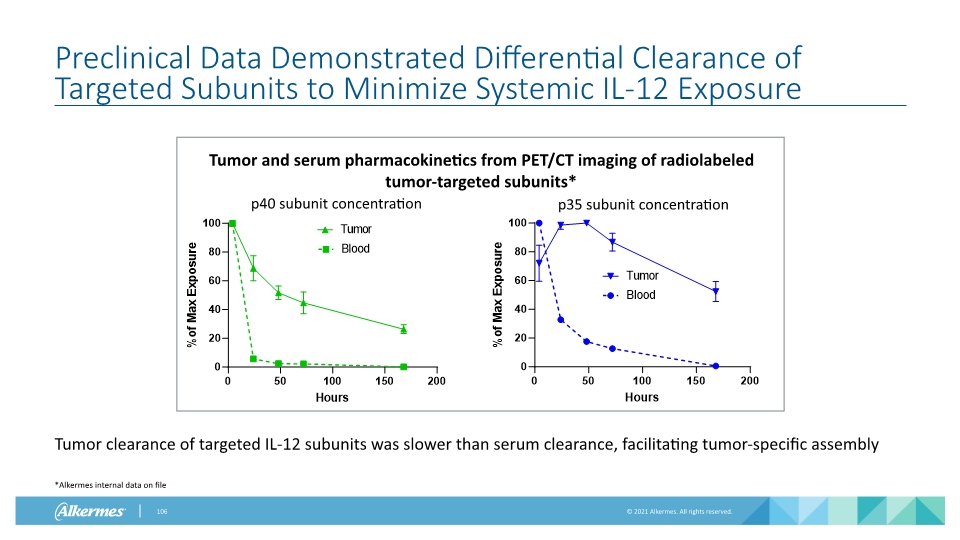
Preclinical Data Demonstrated Differential Clearance of Targeted Subunits to Minimize Systemic IL-12 Exposure Tumor clearance of targeted IL-12 subunits was slower than serum clearance, facilitating tumor-specific assembly Tumor and serum pharmacokinetics from PET/CT imaging of radiolabeled tumor-targeted subunits* *Alkermes internal data on file
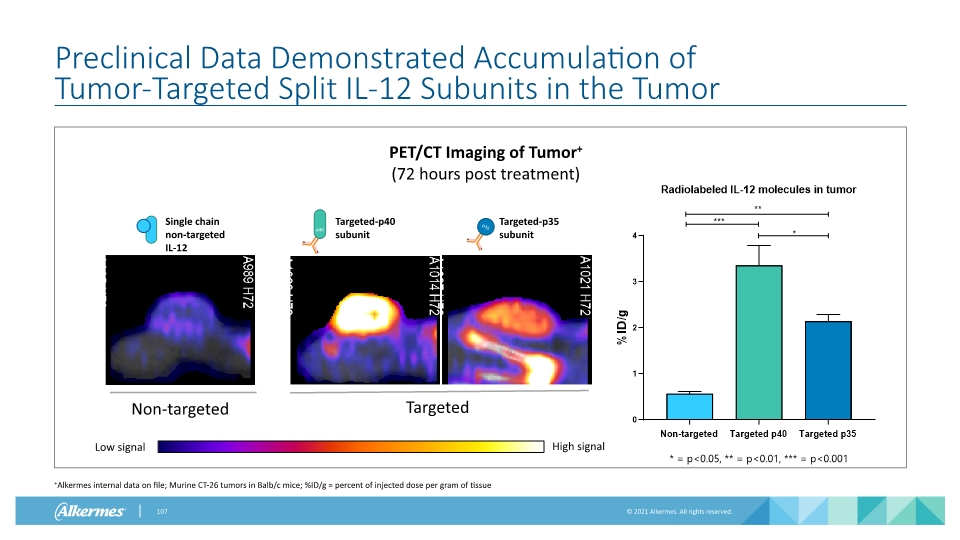
Preclinical Data Demonstrated Accumulation of Tumor-Targeted Split IL-12 Subunits in the Tumor +Alkermes internal data on file; Murine CT-26 tumors in Balb/c mice; %ID/g = percent of injected dose per gram of tissue * = p<0.05, ** = p<0.01, *** = p<0.001
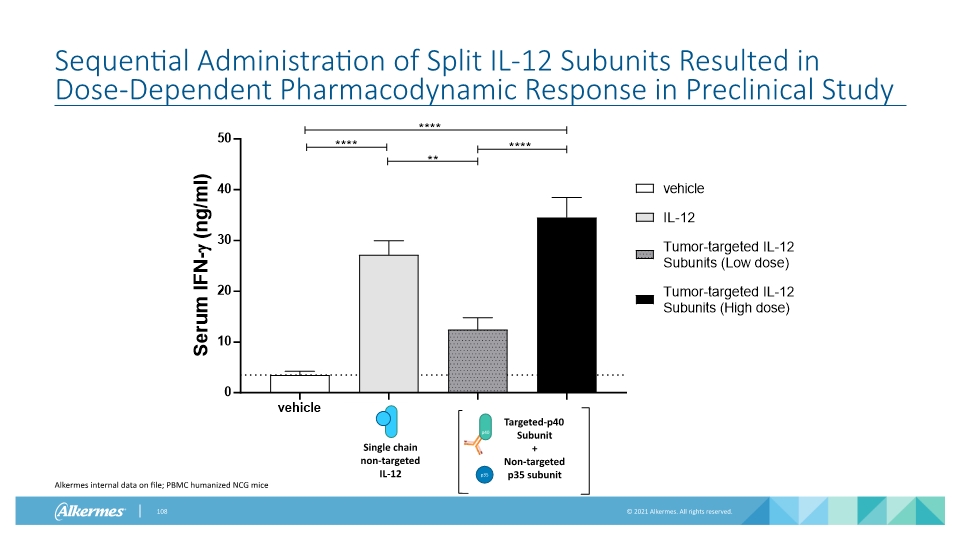
Sequential Administration of Split IL-12 Subunits Resulted in Dose-Dependent Pharmacodynamic Response in Preclinical Study Alkermes internal data on file; PBMC humanized NCG mice
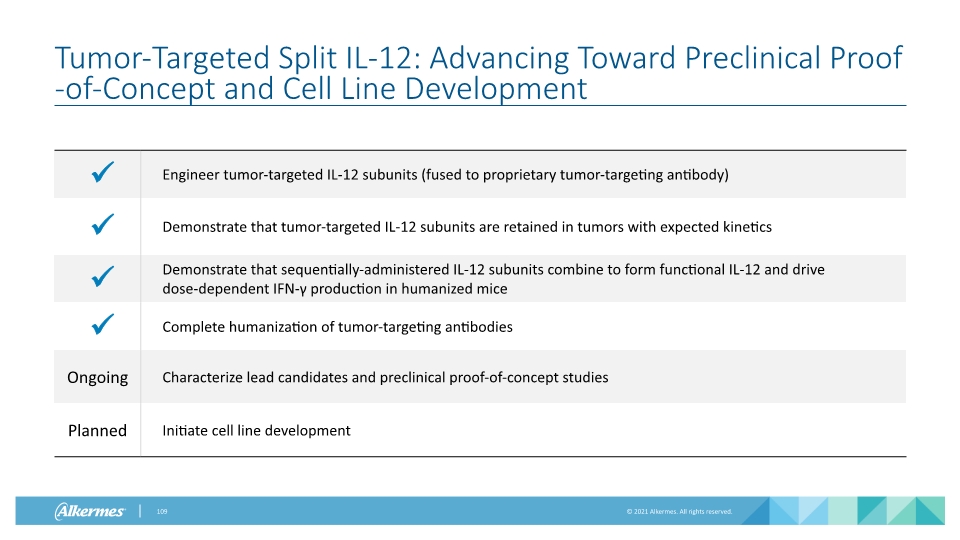
Tumor-Targeted Split IL-12: Advancing Toward Preclinical Proof-of-Concept and Cell Line Development

Neuroscience
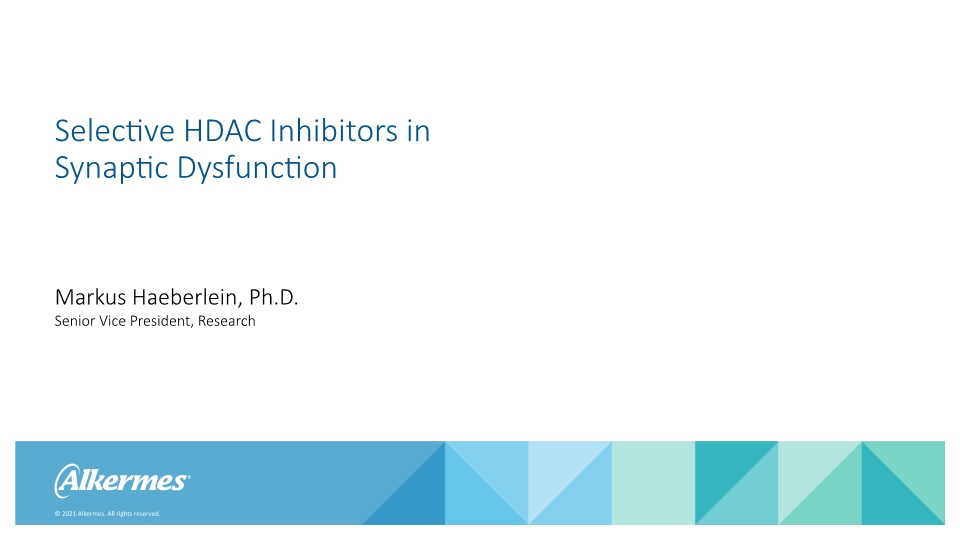
Selective HDAC Inhibitors in Synaptic Dysfunction Markus Haeberlein, Ph.D. Senior Vice President, Research
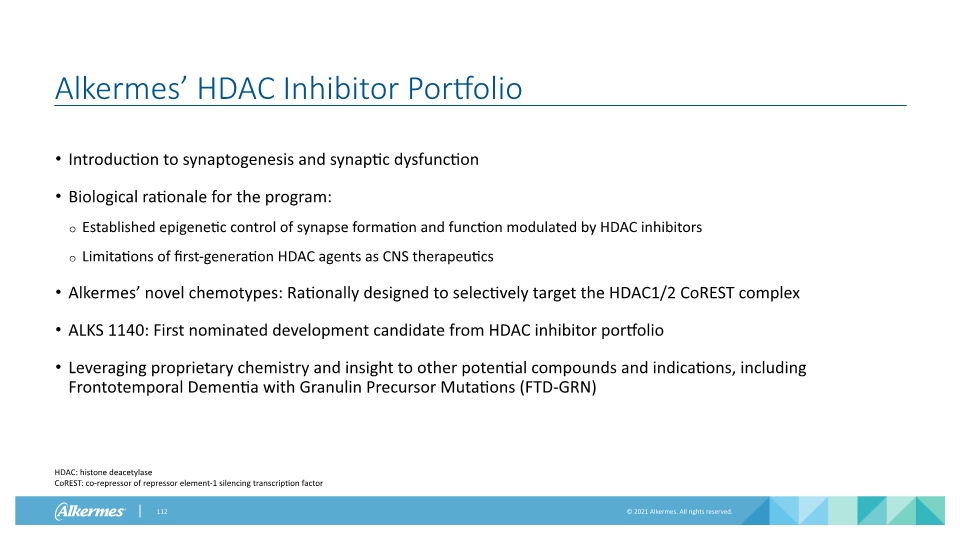
Alkermes’ HDAC Inhibitor Portfolio Introduction to synaptogenesis and synaptic dysfunction Biological rationale for the program: Established epigenetic control of synapse formation and function modulated by HDAC inhibitors Limitations of first-generation HDAC agents as CNS therapeutics Alkermes’ novel chemotypes: Rationally designed to selectively target the HDAC1/2 CoREST complex ALKS 1140: First nominated development candidate from HDAC inhibitor portfolio Leveraging proprietary chemistry and insight to other potential compounds and indications, including Frontotemporal Dementia with Granulin Precursor Mutations (FTD-GRN) HDAC: histone deacetylase CoREST: co-repressor of repressor element-1 silencing transcription factor

Synapses Play a Vital Role in Brain Function, Learning and Memory presynaptic axon dendritic spine dendrite synapse: points of communication between neurons presynaptic axon axon synaptogenesis: formation of synapses occurring throughout a healthy person's lifespan
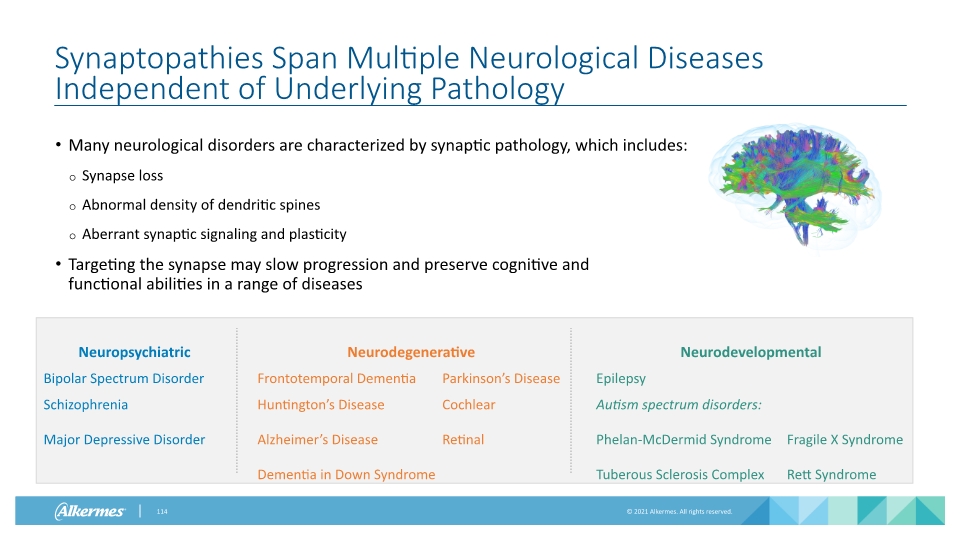
Synaptopathies Span Multiple Neurological Diseases Independent of Underlying Pathology Many neurological disorders are characterized by synaptic pathology, which includes: Synapse loss Abnormal density of dendritic spines Aberrant synaptic signaling and plasticity Targeting the synapse may slow progression and preserve cognitive and functional abilities in a range of diseases
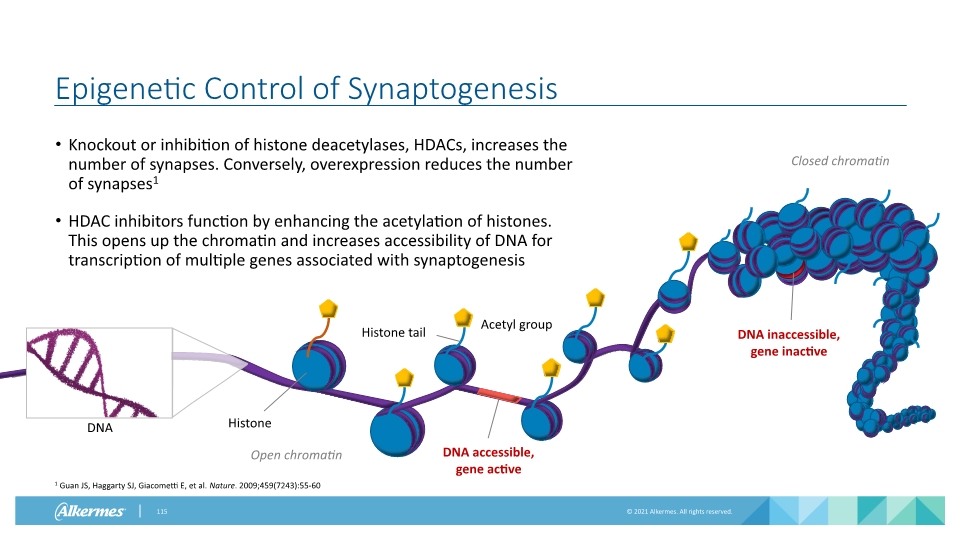
Epigenetic Control of Synaptogenesis Knockout or inhibition of histone deacetylases, HDACs, increases the number of synapses. Conversely, overexpression reduces the number of synapses1 HDAC inhibitors function by enhancing the acetylation of histones. This opens up the chromatin and increases accessibility of DNA for transcription of multiple genes associated with synaptogenesis Closed chromatin 1 Guan JS, Haggarty SJ, Giacometti E, et al. Nature. 2009;459(7243):55-60
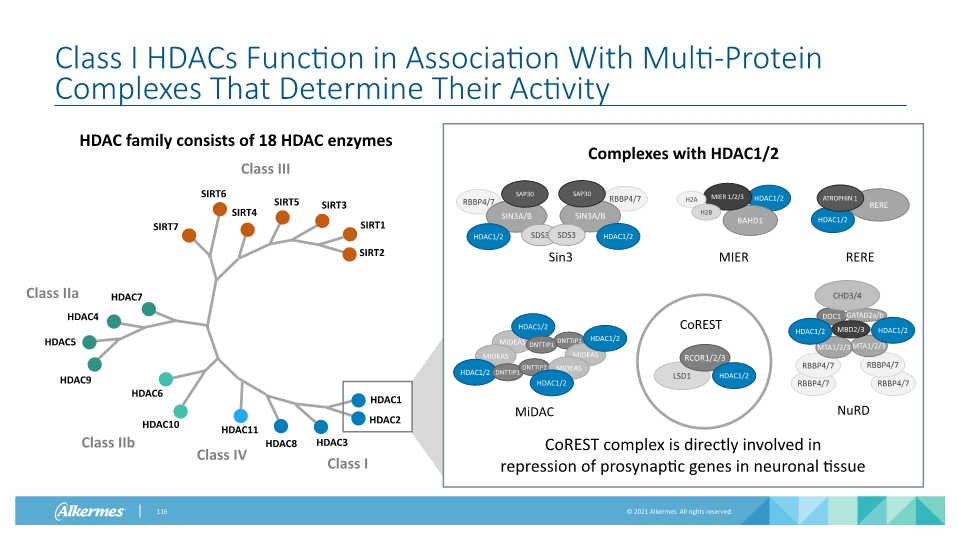
DOC1 RBBP4/7 RBBP4/7 RBBP4/7 RBBP4/7 Class I HDACs Function in Association With Multi-Protein Complexes That Determine Their Activity HDAC family consists of 18 HDAC enzymes Complexes with HDAC1/2 CoREST complex is directly involved in repression of prosynaptic genes in neuronal tissue Sin3 RERE MIER NuRD CoREST GATAD2a/b CHD3/4 MTA1/2/3 RBBP4/7 MTA1/2/3 MBD2/3 HDAC1/2 HDAC1/2 HDAC1 HDAC2 HDAC3 HDAC8 HDAC11 HDAC10 HDAC6 HDAC9 HDAC5 HDAC4 HDAC7 SIRT7 SIRT6 SIRT4 SIRT5 SIRT3 SIRT1 SIRT2 Class III Class IIa Class IIb Class IV Class I
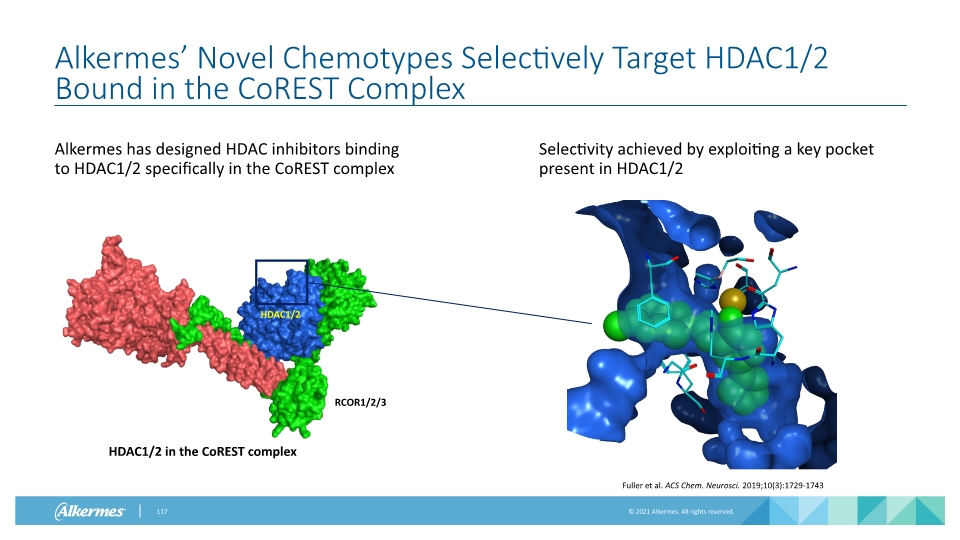
Alkermes’ Novel Chemotypes Selectively Target HDAC1/2 Bound in the CoREST Complex Alkermes has designed HDAC inhibitors binding to HDAC1/2 specifically in the CoREST complex Selectivity achieved by exploiting a key pocket present in HDAC1/2 HDAC1/2 in the CoREST complex HDAC1/2 RCOR1/2/3 Fuller et al. ACS Chem. Neurosci. 2019;10(3):1729-1743
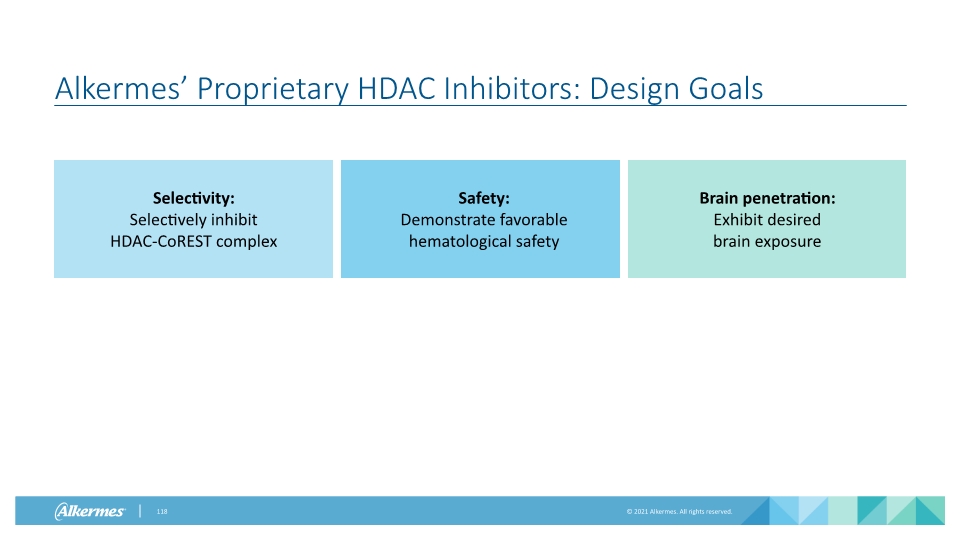
Alkermes’ Proprietary HDAC Inhibitors: Design Goals
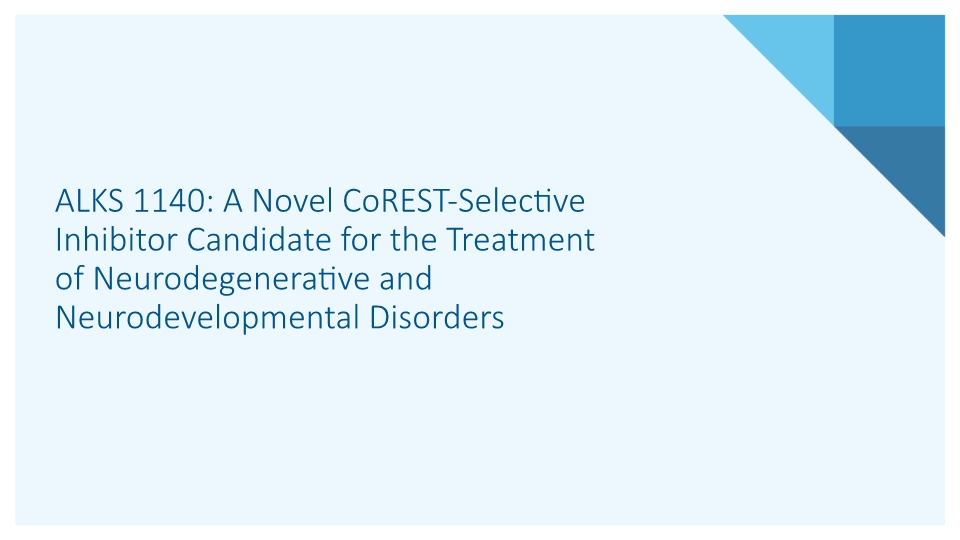
ALKS 1140: A Novel CoREST-Selective Inhibitor Candidate for the Treatment of Neurodegenerative and Neurodevelopmental Disorders
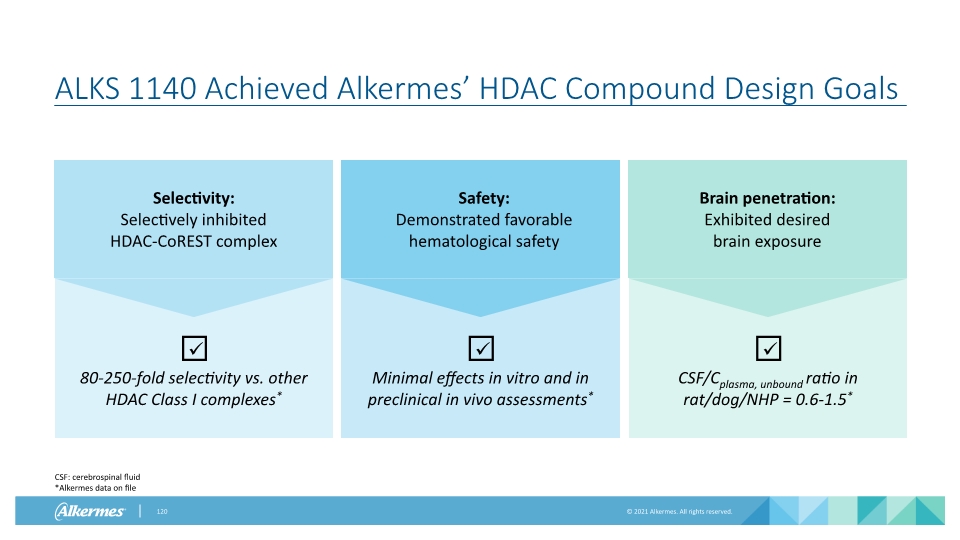
ALKS 1140 Achieved Alkermes’ HDAC Compound Design Goals CSF: cerebrospinal fluid *Alkermes data on file CSF/Cplasma, unbound ratio in rat/dog/NHP = 0.6-1.5* Minimal effects in vitro and in preclinical in vivo assessments* 80-250-fold selectivity vs. other HDAC Class I complexes* Brain penetration: Exhibited desired brain exposure Safety: Demonstrated favorable hematological safety Selectivity: Selectively inhibited HDAC-CoREST complex
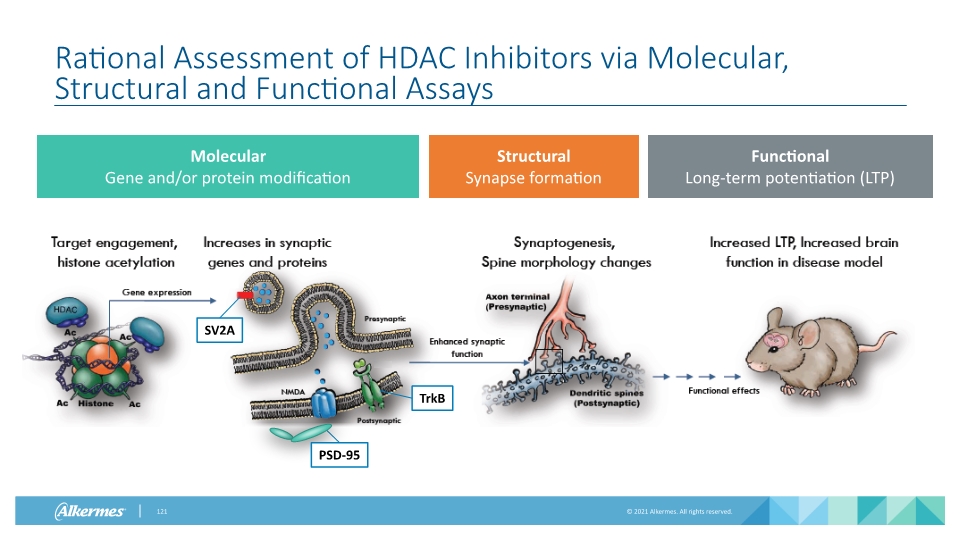
Rational Assessment of HDAC Inhibitors via Molecular, Structural and Functional Assays Molecular Gene and/or protein modification Structural Synapse formation Functional Long-term potentiation (LTP)
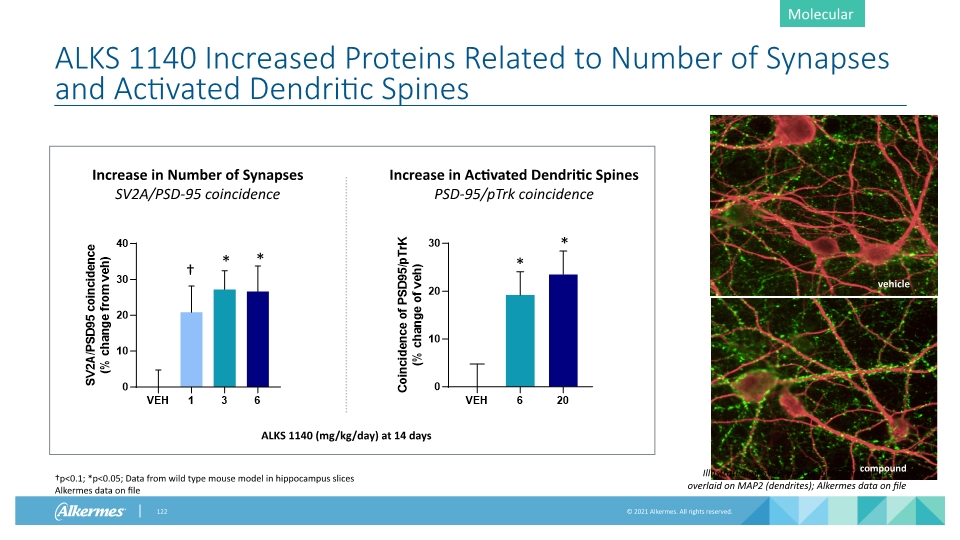
ALKS 1140 Increased Proteins Related to Number of Synapses and Activated Dendritic Spines Increase in Number of Synapses SV2A/PSD-95 coincidence Increase in Activated Dendritic Spines PSD-95/pTrk coincidence Molecular Illustration of SV2A puncta (green) in culture overlaid on MAP2 (dendrites); Alkermes data on file * * * * † †p<0.1; *p<0.05; Data from wild type mouse model in hippocampus slices Alkermes data on file ALKS 1140 (mg/kg/day) at 14 days
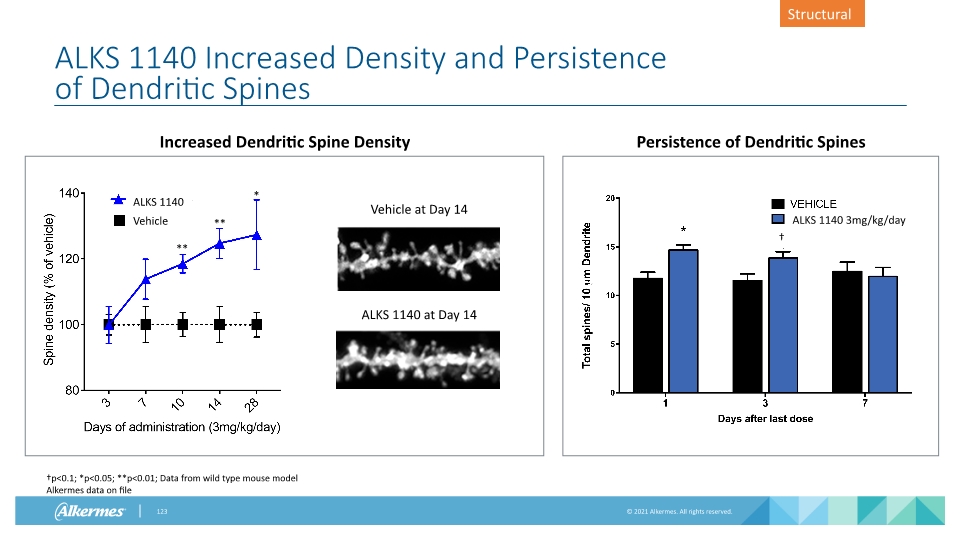
ALKS 1140 at Day 14 ALKS 1140 Increased Density and Persistence of Dendritic Spines ALKS 1140 ALKS 1140 3mg/kg/day Increased Dendritic Spine Density Persistence of Dendritic Spines Vehicle at Day 14 Vehicle Structural †p<0.1; *p<0.05; **p<0.01; Data from wild type mouse model Alkermes data on file † ** ** *
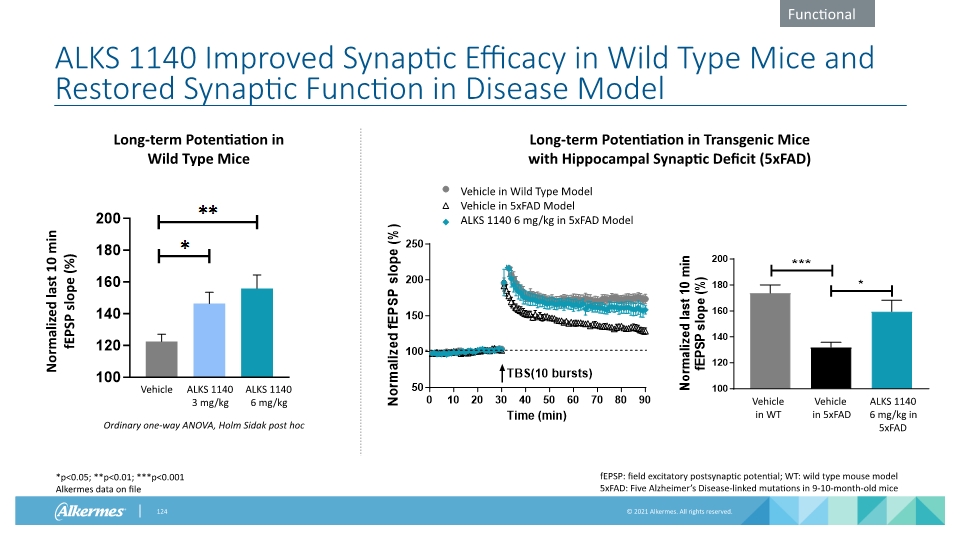
ALKS 1140 Improved Synaptic Efficacy in Wild Type Mice and Restored Synaptic Function in Disease Model Ordinary one-way ANOVA, Holm Sidak post hoc Normalized last 10 min fEPSP slope (%) Long-term Potentiation in Wild Type Mice Long-term Potentiation in Transgenic Mice with Hippocampal Synaptic Deficit (5xFAD) *p<0.05; **p<0.01; ***p<0.001 Alkermes data on file Functional fEPSP: field excitatory postsynaptic potential; WT: wild type mouse model 5xFAD: Five Alzheimer’s Disease-linked mutations in 9-10-month-old mice ALKS 1140 3 mg/kg ALKS 1140 6 mg/kg Vehicle Vehicle in Wild Type Model Vehicle in 5xFAD Model ALKS 1140 6 mg/kg in 5xFAD Model Vehicle in 5xFAD ALKS 1140 6 mg/kg in 5xFAD Vehicle in WT
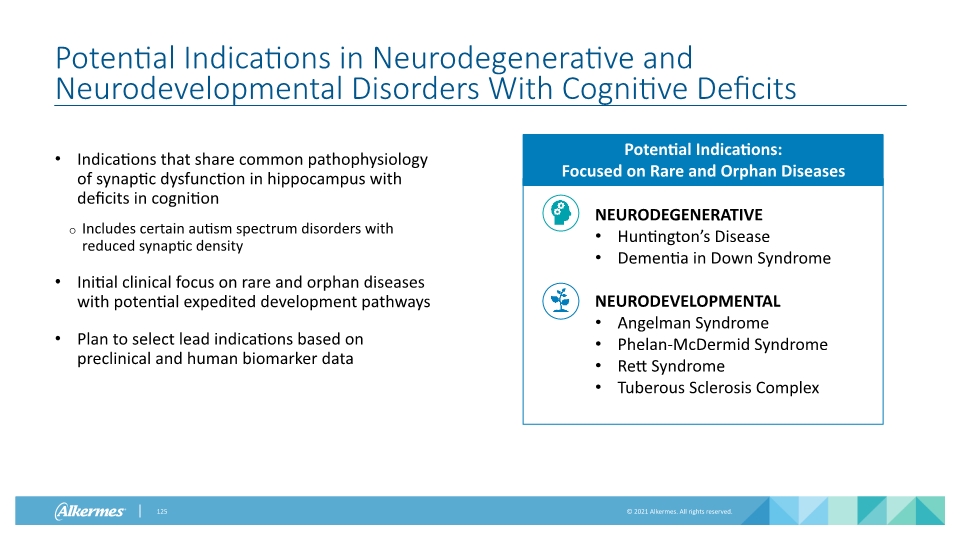
Potential Indications in Neurodegenerative and Neurodevelopmental Disorders With Cognitive Deficits Indications that share common pathophysiology of synaptic dysfunction in hippocampus with deficits in cognition Includes certain autism spectrum disorders with reduced synaptic density Initial clinical focus on rare and orphan diseases with potential expedited development pathways Plan to select lead indications based on preclinical and human biomarker data NEURODEGENERATIVE Huntington’s Disease Dementia in Down Syndrome NEURODEVELOPMENTAL Angelman Syndrome Phelan-McDermid Syndrome Rett Syndrome Tuberous Sclerosis Complex Potential Indications: Focused on Rare and Orphan Diseases
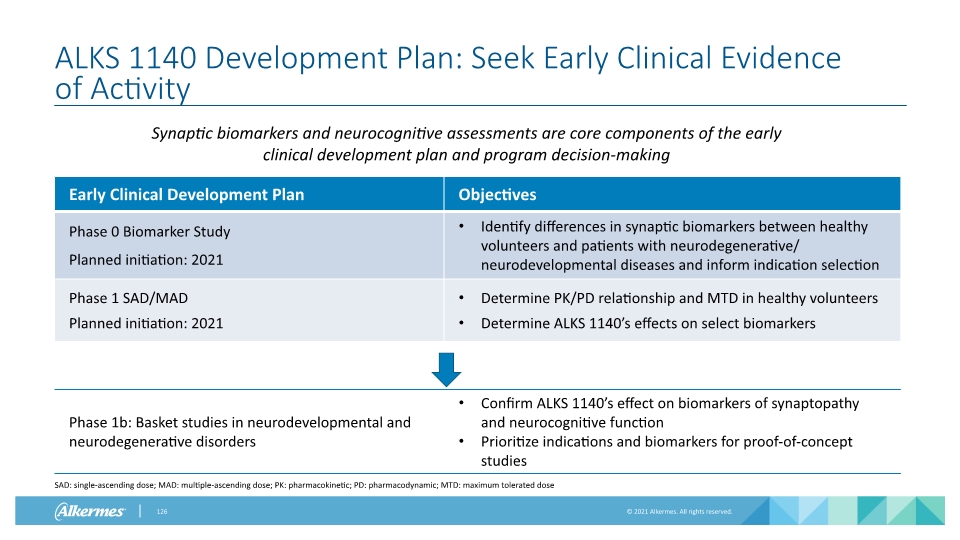
ALKS 1140 Development Plan: Seek Early Clinical Evidence of Activity Synaptic biomarkers and neurocognitive assessments are core components of the early clinical development plan and program decision-making SAD: single-ascending dose; MAD: multiple-ascending dose; PK: pharmacokinetic; PD: pharmacodynamic; MTD: maximum tolerated dose
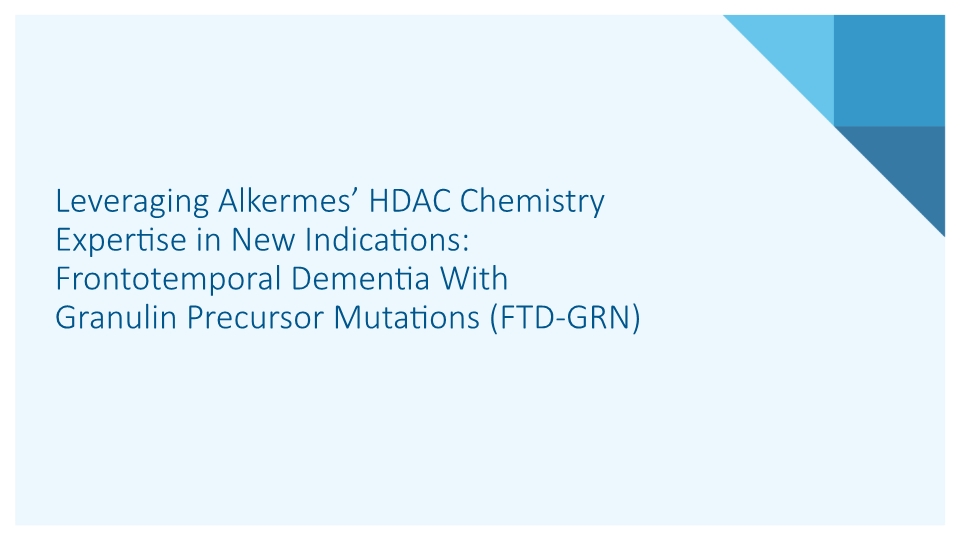
Leveraging Alkermes’ HDAC Chemistry Expertise in New Indications: Frontotemporal Dementia With Granulin Precursor Mutations (FTD-GRN)
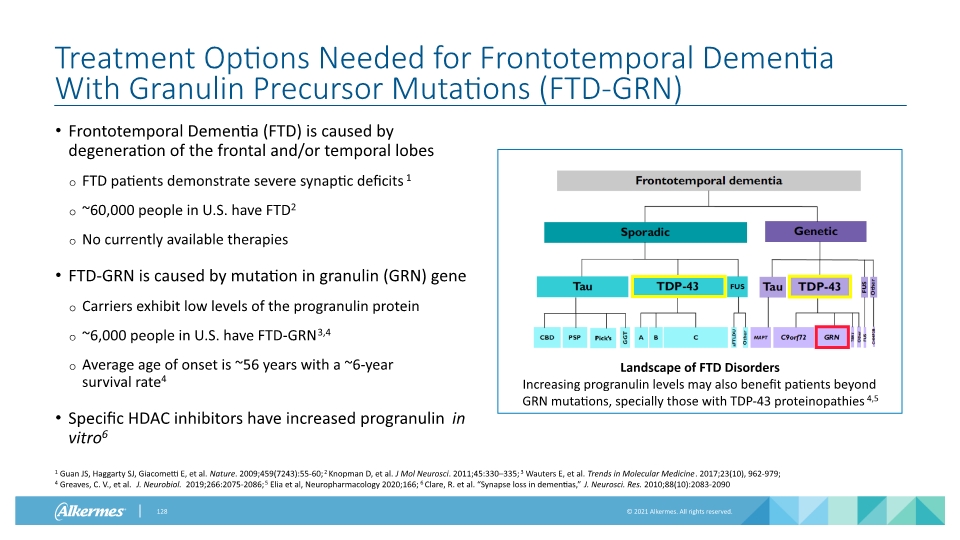
Treatment Options Needed for Frontotemporal Dementia With Granulin Precursor Mutations (FTD-GRN) Frontotemporal Dementia (FTD) is caused by degeneration of the frontal and/or temporal lobes FTD patients demonstrate severe synaptic deficits1 ~60,000 people in U.S. have FTD2 No currently available therapies FTD-GRN is caused by mutation in granulin (GRN) gene Carriers exhibit low levels of the progranulin protein ~6,000 people in U.S. have FTD-GRN3,4 Average age of onset is ~56 years with a ~6-year survival rate4 Specific HDAC inhibitors have increased progranulin in vitro6 1 Guan JS, Haggarty SJ, Giacometti E, et al. Nature. 2009;459(7243):55-60; 2 Knopman D, et al. J Mol Neurosci. 2011;45:330–335; 3 Wauters E, et al. Trends in Molecular Medicine. 2017;23(10), 962-979; 4 Greaves, C. V., et al. J. Neurobiol. 2019;266:2075-2086; 5 Elia et al, Neuropharmacology 2020;166; 6 Clare, R. et al. “Synapse loss in dementias,” J. Neurosci. Res. 2010;88(10):2083-2090 Landscape of FTD Disorders Increasing progranulin levels may also benefit patients beyond GRN mutations, specially those with TDP-43 proteinopathies4,5
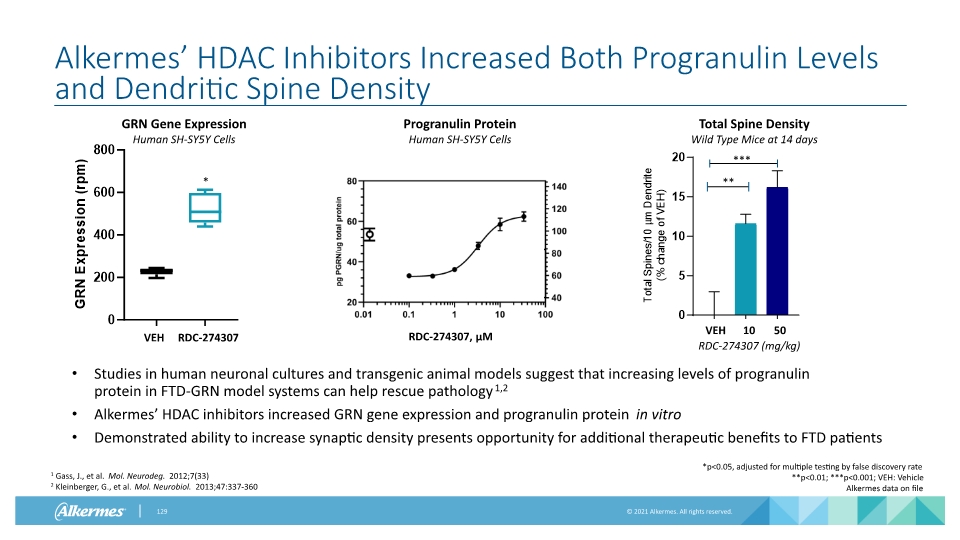
Alkermes’ HDAC Inhibitors Increased Both Progranulin Levels and Dendritic Spine Density GRN Gene Expression Human SH-SY5Y Cells 1 Gass, J., et al. Mol. Neurodeg. 2012;7(33) 2 Kleinberger, G., et al. Mol. Neurobiol. 2013;47:337-360 Progranulin Protein Human SH-SY5Y Cells Total Spine Density Wild Type Mice at 14 days RDC-274307 Studies in human neuronal cultures and transgenic animal models suggest that increasing levels of progranulin protein in FTD-GRN model systems can help rescue pathology1,2 Alkermes’ HDAC inhibitors increased GRN gene expression and progranulin protein in vitro Demonstrated ability to increase synaptic density presents opportunity for additional therapeutic benefits to FTD patients VEH RDC-274307 (mg/kg) VEH 10 50 RDC-274307 *p<0.05, adjusted for multiple testing by false discovery rate **p<0.01; ***p<0.001; VEH: Vehicle Alkermes data on file * ** ***
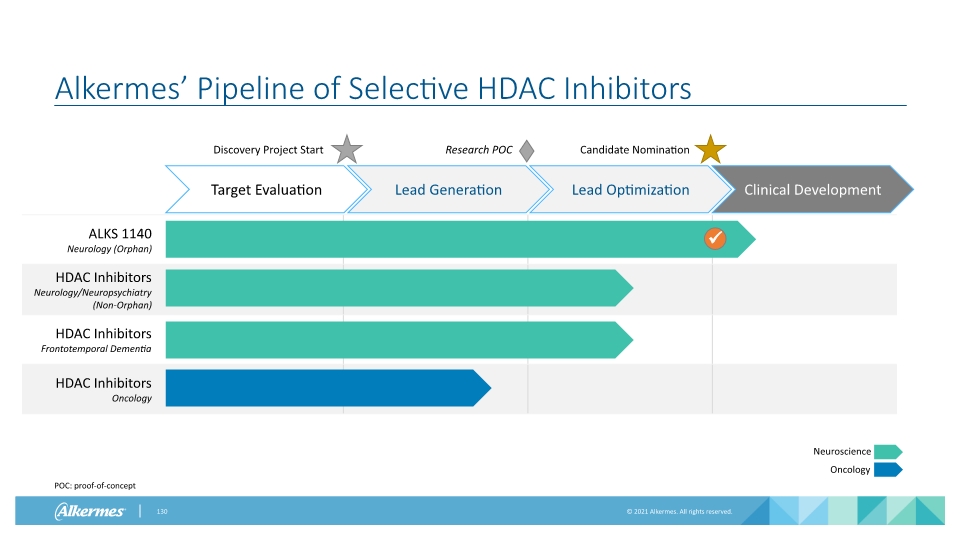
Alkermes’ Pipeline of Selective HDAC Inhibitors Target Evaluation Lead Generation Lead Optimization Clinical Development Discovery Project Start Candidate Nomination Research POC Oncology Neuroscience POC: proof-of-concept
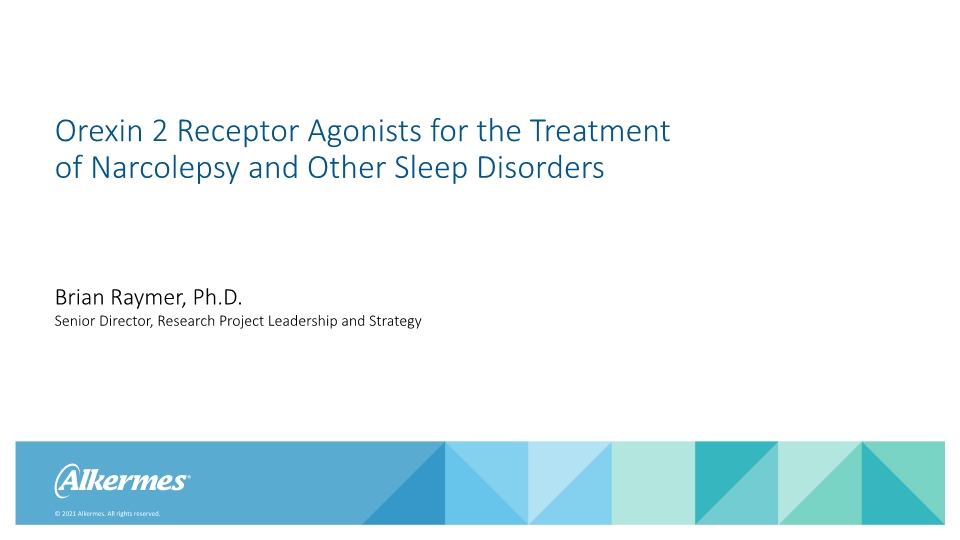
Brian Raymer, Ph.D. Orexin 2 Receptor Agonists for the Treatment of Narcolepsy and Other Sleep Disorders Senior Director, Research Project Leadership and Strategy
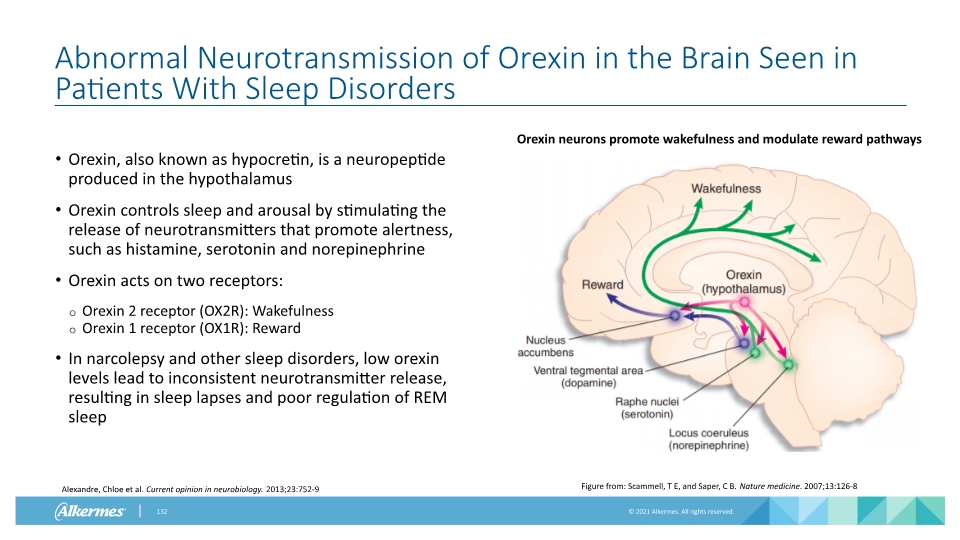
Abnormal Neurotransmission of Orexin in the Brain Seen in Patients With Sleep Disorders Orexin, also known as hypocretin, is a neuropeptide produced in the hypothalamus Orexin controls sleep and arousal by stimulating the release of neurotransmitters that promote alertness, such as histamine, serotonin and norepinephrine Orexin acts on two receptors: Orexin 2 receptor (OX2R): Wakefulness Orexin 1 receptor (OX1R): Reward In narcolepsy and other sleep disorders, low orexin levels lead to inconsistent neurotransmitter release, resulting in sleep lapses and poor regulation of REM sleep Figure from: Scammell, T E, and Saper, C B. Nature medicine. 2007;13:126-8 Orexin neurons promote wakefulness and modulate reward pathways Alexandre, Chloe et al. Current opinion in neurobiology. 2013;23:752-9
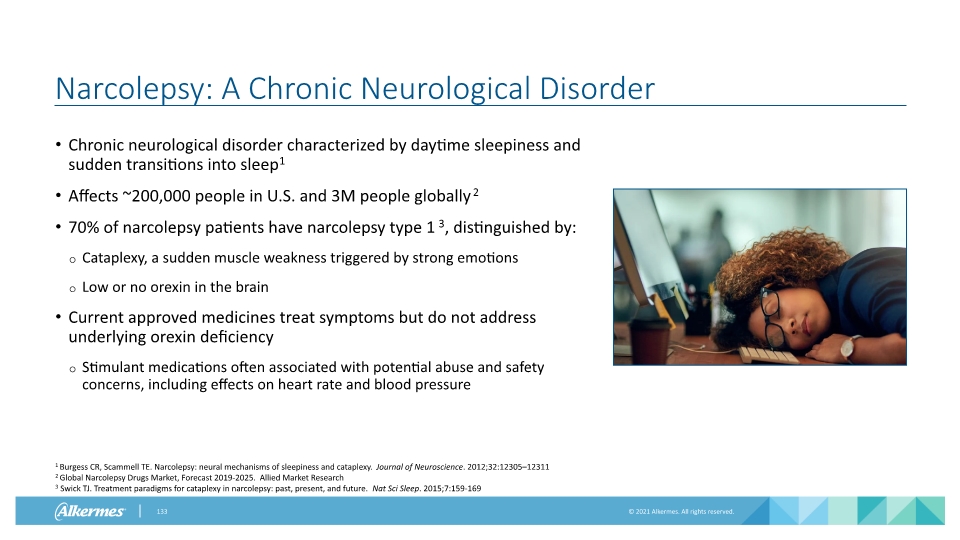
Narcolepsy: A Chronic Neurological Disorder Chronic neurological disorder characterized by daytime sleepiness and sudden transitions into sleep1 Affects ~200,000 people in U.S. and 3M people globally2 70% of narcolepsy patients have narcolepsy type 13, distinguished by: Cataplexy, a sudden muscle weakness triggered by strong emotions Low or no orexin in the brain Current approved medicines treat symptoms but do not address underlying orexin deficiency Stimulant medications often associated with potential abuse and safety concerns, including effects on heart rate and blood pressure 1 Burgess CR, Scammell TE. Narcolepsy: neural mechanisms of sleepiness and cataplexy. Journal of Neuroscience. 2012;32:12305–12311 2 Global Narcolepsy Drugs Market, Forecast 2019-2025. Allied Market Research 3 Swick TJ. Treatment paradigms for cataplexy in narcolepsy: past, present, and future. Nat Sci Sleep. 2015;7:159-169
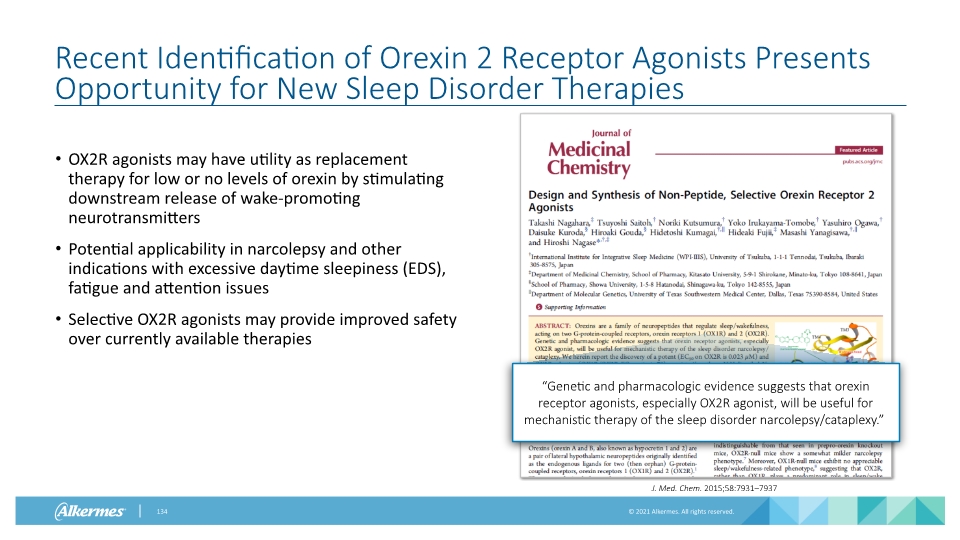
Recent Identification of Orexin 2 Receptor Agonists Presents Opportunity for New Sleep Disorder Therapies OX2R agonists may have utility as replacement therapy for low or no levels of orexin by stimulating downstream release of wake-promoting neurotransmitters Potential applicability in narcolepsy and other indications with excessive daytime sleepiness (EDS), fatigue and attention issues Selective OX2R agonists may provide improved safety over currently available therapies “Genetic and pharmacologic evidence suggests that orexin receptor agonists, especially OX2R agonist, will be useful for mechanistic therapy of the sleep disorder narcolepsy/cataplexy.” J. Med. Chem. 2015;58:7931–7937
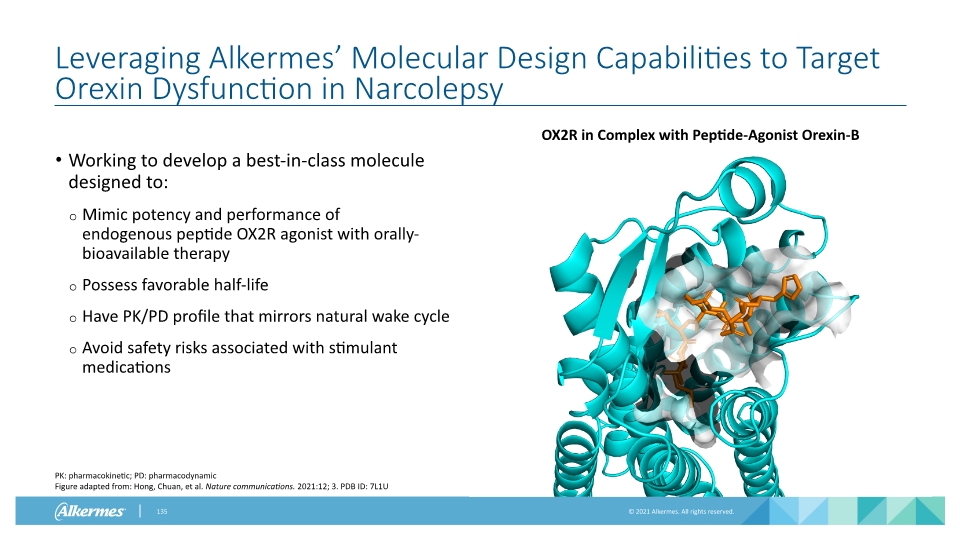
Leveraging Alkermes’ Molecular Design Capabilities to Target Orexin Dysfunction in Narcolepsy Working to develop a best-in-class molecule designed to: Mimic potency and performance of endogenous peptide OX2R agonist with orally-bioavailable therapy Possess favorable half-life Have PK/PD profile that mirrors natural wake cycle Avoid safety risks associated with stimulant medications PK: pharmacokinetic; PD: pharmacodynamic Figure adapted from: Hong, Chuan, et al. Nature communications. 2021:12; 3. PDB ID: 7L1U OX2R in Complex with Peptide-Agonist Orexin-B
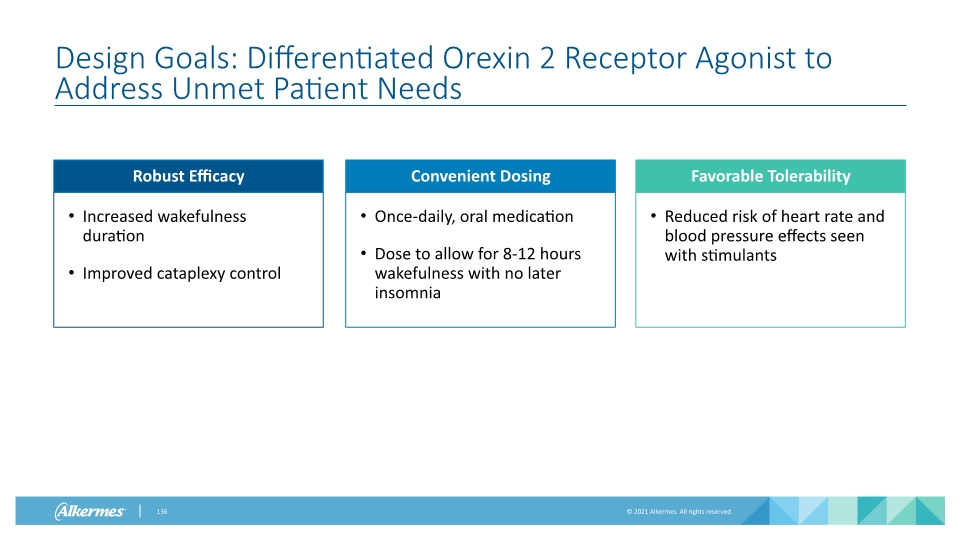
Design Goals: Differentiated Orexin 2 Receptor Agonist to Address Unmet Patient Needs Increased wakefulness duration Improved cataplexy control Robust Efficacy Reduced risk of heart rate and blood pressure effects seen with stimulants Favorable Tolerability Once-daily, oral medication Dose to allow for 8-12 hours wakefulness with no later insomnia Convenient Dosing
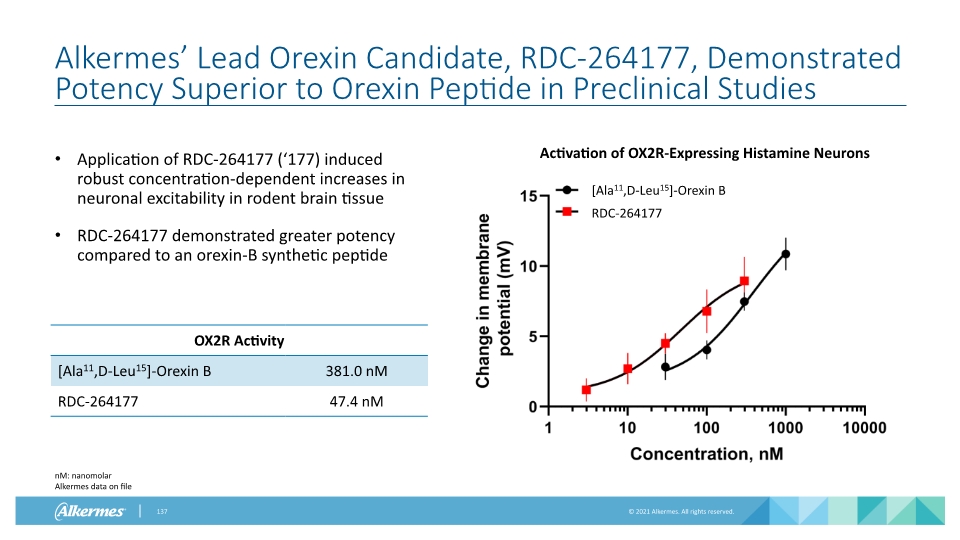
Alkermes’ Lead Orexin Candidate, RDC-264177, Demonstrated Potency Superior to Orexin Peptide in Preclinical Studies Application of RDC-264177 (‘177) induced robust concentration-dependent increases in neuronal excitability in rodent brain tissue RDC-264177 demonstrated greater potency compared to an orexin-B synthetic peptide Activation of OX2R-Expressing Histamine Neurons nM: nanomolar Alkermes data on file
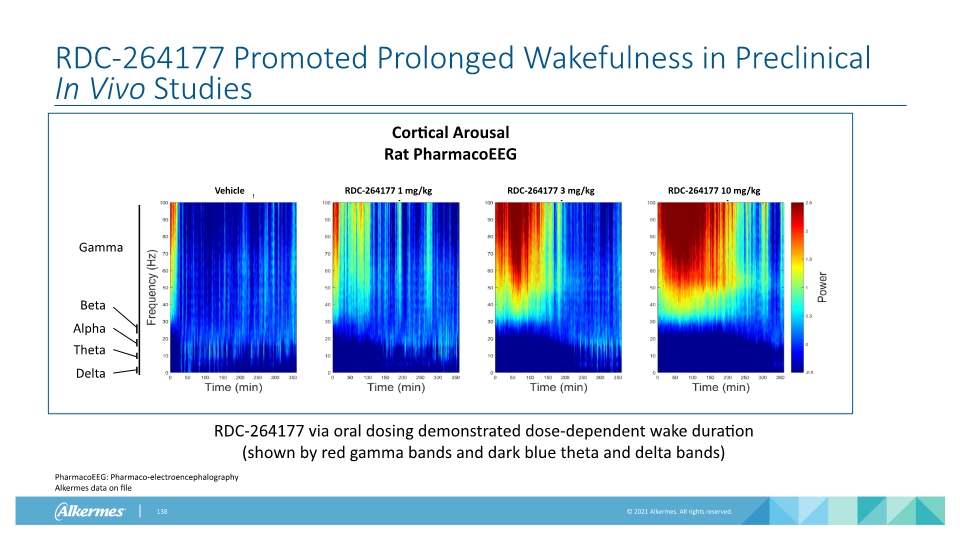
RDC-264177 Promoted Prolonged Wakefulness in Preclinical In Vivo Studies RDC-264177 via oral dosing demonstrated dose-dependent wake duration (shown by red gamma bands and dark blue theta and delta bands) PharmacoEEG: Pharmaco-electroencephalography Alkermes data on file
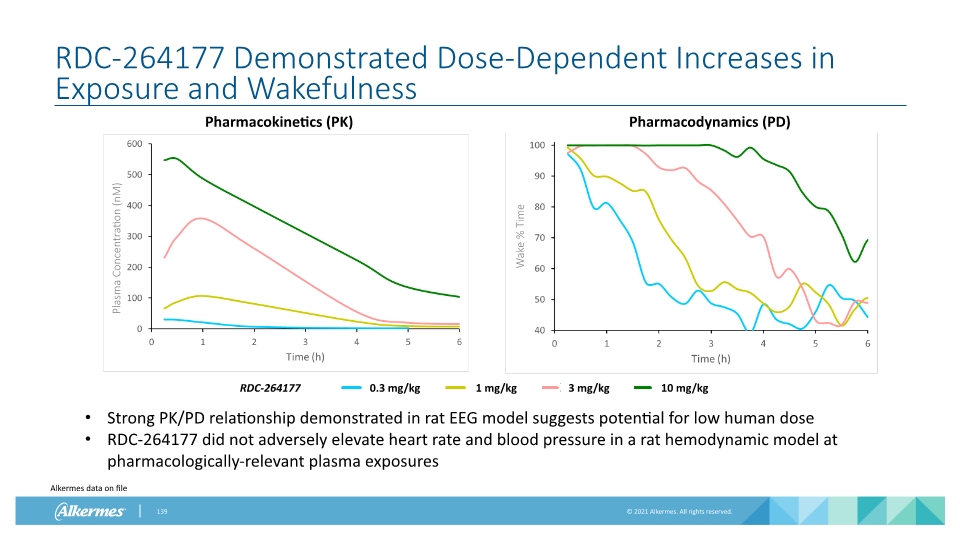
RDC-264177 Demonstrated Dose-Dependent Increases in Exposure and Wakefulness Pharmacokinetics (PK) Pharmacodynamics (PD) Strong PK/PD relationship demonstrated in rat EEG model suggests potential for low human dose RDC-264177 did not adversely elevate heart rate and blood pressure in a rat hemodynamic model at pharmacologically-relevant plasma exposures Plasma Concentration (nM) Wake % Time Alkermes data on file
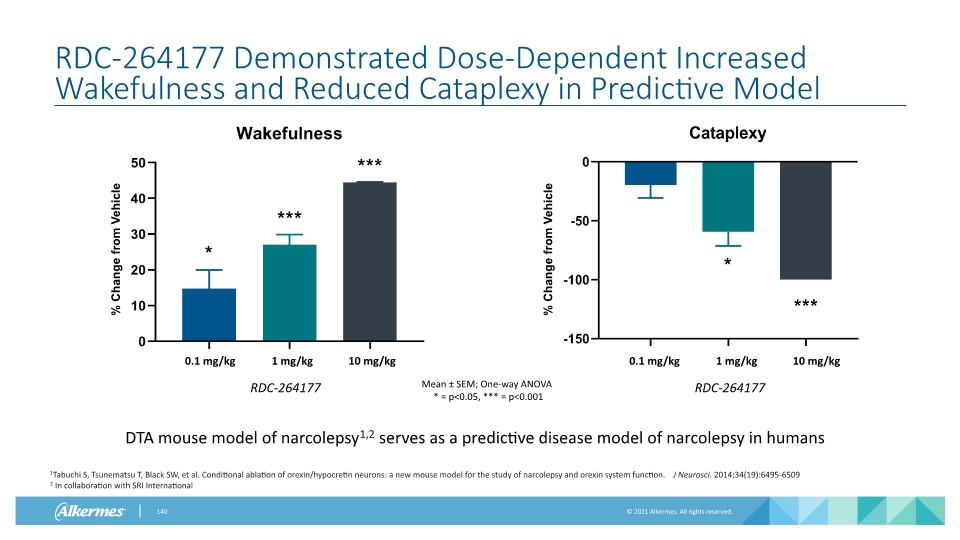
RDC-264177 Demonstrated Dose-Dependent Increased Wakefulness and Reduced Cataplexy in Predictive Model Mean ± SEM; One-way ANOVA * = p<0.05, *** = p<0.001 0.1 mg/kg 1 mg/kg 10 mg/kg RDC-264177 0.1 mg/kg 1 mg/kg 10 mg/kg RDC-264177 DTA mouse model of narcolepsy1,2 serves as a predictive disease model of narcolepsy in humans % Change from Vehicle % Change from Vehicle 1Tabuchi S, Tsunematsu T, Black SW, et al. Conditional ablation of orexin/hypocretin neurons: a new mouse model for the study of narcolepsy and orexin system function. J Neurosci. 2014;34(19):6495-6509 2 In collaboration with SRI International
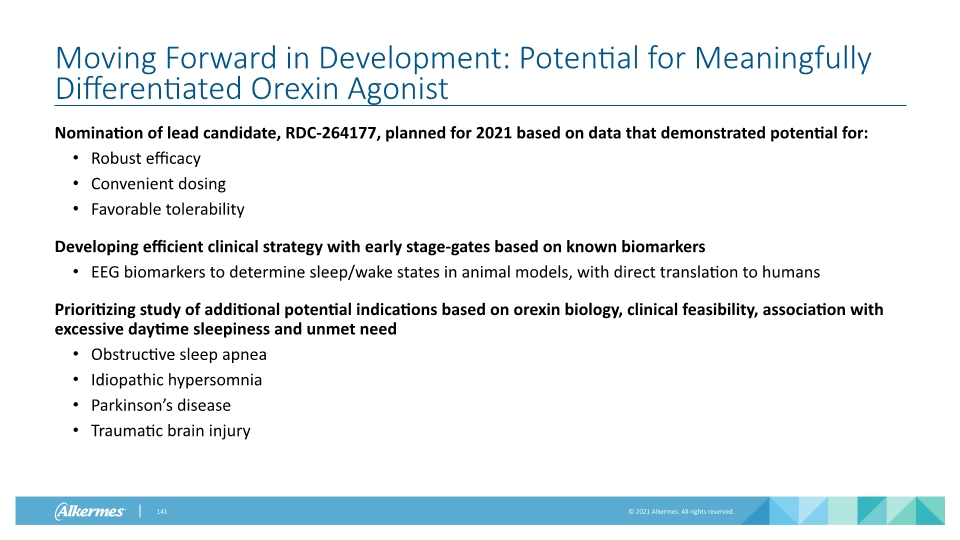
Moving Forward in Development: Potential for Meaningfully Differentiated Orexin Agonist Nomination of lead candidate, RDC-264177, planned for 2021 based on data that demonstrated potential for: Robust efficacy Convenient dosing Favorable tolerability Developing efficient clinical strategy with early stage-gates based on known biomarkers EEG biomarkers to determine sleep/wake states in animal models, with direct translation to humans Prioritizing study of additional potential indications based on orexin biology, clinical feasibility, association with excessive daytime sleepiness and unmet need Obstructive sleep apnea Idiopathic hypersomnia Parkinson’s disease Traumatic brain injury

www.alkermes.com
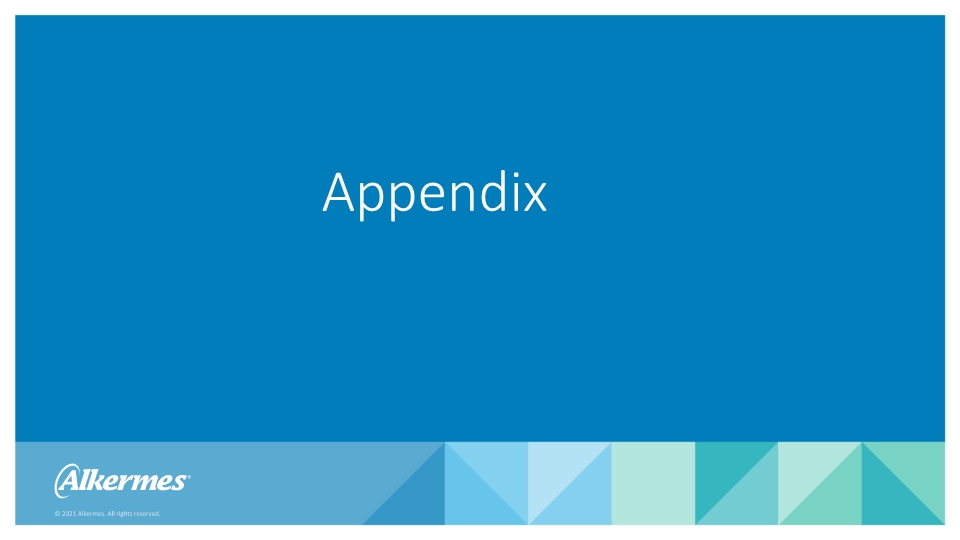
Appendix
